Paul van Yperen's Blog, page 5
August 18, 2025
Gertie Millar
During the Edwardian era, English actress and singer Gertie Millar (1879-1952) was one of the most prominent West End theatre performers. She starred in a series of hit musicals, composed by her husband. After her second marriage in 1924, she became Lady Dudley. Millar had been one of the most photographed stars of the early 20th Century, but did she also appear in a Hollywood film?
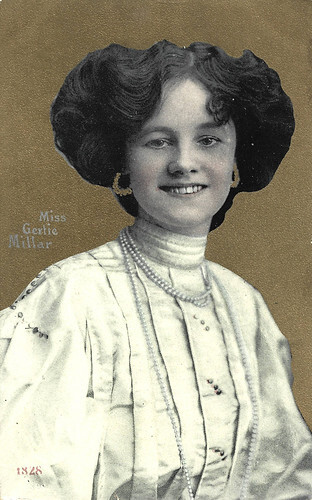
British postcard by The Rapid Photo Printing Co., London, no. 1828. Printed in Belgium.
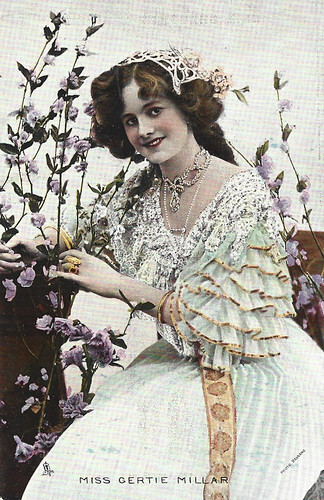
British postcard by Ed. Raphael Tuck & Sons, Photochrome, no. 331 B. Photo: Bassano.
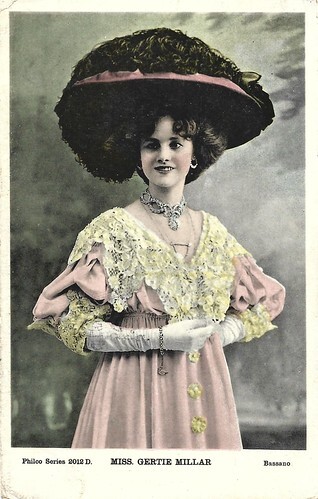
British postcard in the Philco Series, no. 2012 D. Photo: Bassano.
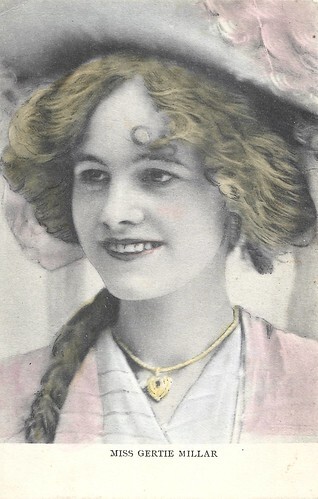
British postcard in the Empire Series, London, no. 28. Printed in Berlin.
Prima donna at London's Gaiety Theatre
Gertie Millar was born in 1879 in Manningham, Bradford, as Gertrude Miller. Her father, John Millar, was a mill worker and her mother, Elizabeth Millar, a seamstress. Gertie grew up to be tall, thin and attractive with dark hair and large limpid eyes. She was also tough, determined and ambitious.
At 13, she made her stage debut in a children's show. Gertie played Lily in the pantomime 'Babes in the Wood' (1892) in the St James's Theatre in Manchester. She also started singing and dancing in variety theatres in Yorkshire. Not long after, Gertie moved to London and started working in theatres there. Soon, she earned substantial sums and attracted much attention for her performances.
Her other early roles include Phyllis Crosby in the musical comedy 'A Game of Cards' (Shodfriars Hall, Boston, 1897); Dora in 'The New Barmaid' (a UK tour in 1898); 'The Silver Lining' (UK tour, 1898); Sadie Pinkhose in 'The Lady Detective' (UK tour, 1898); and Dandini in 'Cinderella' (Grand Theatre, Fulham, London, 1899).
In 1901, Lionel Monckton (1861-1924), an Oxford University-educated lawyer and theatre critic turned composer, gave Millar the role of Isabel Blyth in the musical 'The Messenger Boy'. She performed several songs in it that were very popular with the audience and made Millar a star. She married Monckton in 1902.
Gertie Millar's early career had coincided with the rise of operettas and musical comedies. This new form of entertainment in the Edwardian period was supported by George Edwardes, the manager of London's Gaiety Theatre and Daly's Theatres. The year before, the famous theatre manager had lost his star, Marie Tempest, after a disagreement over a costume, and he recruited Gertie Millar to be the new leading lady in his productions. From 1901 to 1910, Millar became the prima donna at the Gaiety Theatre in a series of highly successful musicals composed for her by her husband, Lionel Monckton, and Ivan Caryll.
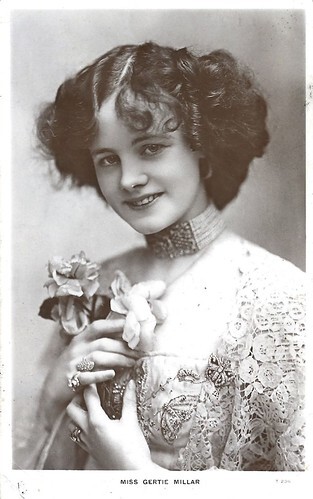
British postcard in the 'Celebrities of the stage' series by Raphael Tuck & Sons, no. 234 (?).
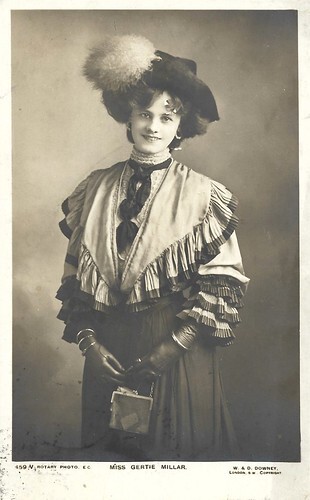
British postcard by Rotary, no. 459 V. Photo: W.& D. Downey, London.
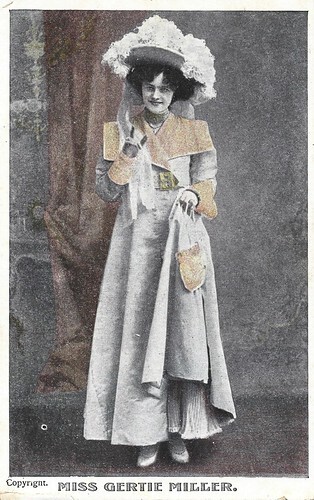
British postcard in the Star Series by Gottschalk, Dreyfuss & Davis, London. The card was printed in Germany. Millar's name is misspelt as Miller.
One of the most photographed actresses of the Edwardian era
One of Gertie Millar's greatest triumphs was her role as Bridesmaid Cora in her first musical for George Edwardes, 'The Toreador'(1901). During a national Gaitey Theatre Tour, she performed the role 675 times. Her next role was as Mary Gibbs in the musical 'Our Miss Gibbs' that opened at the Gaiety on 23 January 1902. Sydney Higgins at The Golden Age of British Theatre (1880-1920): "Its strong cast included George Grossmith jr., Robert Hale, Edmund Payne, Denise Orme, Jean Aylwin, Gladys Homfrey and Kitty Mason, but Gertie Millar was, without doubt, the star and made her the best known musical comedy performer in the country." Millar became one of the most photographed actresses of the Edwardian era, along with Lily Elsie and Gabrielle Ray.
The Gaiety Theatre closed for renovations in 1902, and the last show at the old theatre was 'The Linkman; or, Gaiety Memories', with Millar starring as Morgiana. In 1903, the new Gaiety Theatre opened in the presence of His Majesty King Edward VI and Queen Alexandra with the premiere of the musical comedy 'The Orchid' (1903) with Gertie Millar starring as Violet Anstruther. The show ran for 559 performances. Success after success followed during the next decade. Her other roles included Rosalie in 'The Spring Chicken' (Gaiety Theatre, 1905); Lally in 'The New Aladdin' (Gaiety Theatre, 1906); Mitzi, the innkeeper's daughter in 'The Girls of Gottenberg' (Gaiety Theatre, 1907-1908 and Broadway in 1908); Franzi in 'A Waltz dream' the English-language production of the Operetta 'Ein Walzertraum' by Oscar Straus (Hicks Theater, 1908); and Prudence Pym in 'The Quaker Girl' in Edwardes' new Adelphi Theatre (1910). The latter ran for an extremely successful 536 performances.
Some of Millar's songs became famous, such as 'Keep Off the Grass' from 'The Toreador' (1901), 'Berlin Is On The Spree' from 'The Girls of Gottenberg' (1907) and 'Moonstruck' from 'Our Miss Gibbs' (1902), a hit song which Monkton had written especially for his wife. Her later roles included Lady Babby in 'Gipsy Love' after the Franz Léhar Operetta 'Zigeunerliebe' (Daly's Theatre, 1912); Nancy Joyce in 'The Dancing Mistress' (Adelphi, 1912); 'The Marriage Market' (Daly's, 1912), and Nan in 'The Country Girl' (Daly's, 1914). Millar continued to perform during the First World War, but it brought a change in the tastes of the theatregoing public. Edwardes died in 1915, and Millar's husband, Lionel Monckton, was in poor health.
At the Palace Theatre, Gertie Millar starred in Monckton's revues 'Bric a Brac' (1915) and 'Airs and Graces' (1917), and the musical comedies 'Houp-La' (1916) and 'Flora' (1918). Monckton's style no longer shone as brightly as in the past, and Millar was considered a star of the earlier Edwardian period. New stars were emerging to cater to the new tastes of the post-war generation. Audiences were now flocking to the comfort of the new cinema palaces for their escapism. In 1918, she made her final appearance at the Alhambra Theatre in Bradford, the city where she had been born. Millar's marriage to Monckton had not been a happy one, and she even asked for a divorce, but Lionel refused to grant it. Only after Monckton died in 1924, she remarried William Humble Ward, Second Earl of Dudley, becoming the Countess of Dudley. Before the war, he had been the Governor-General of Australia. Gertie Millar, the working-class girl from Yorkshire who grew up to be one of the best-loved stars and most photographed women of the Edwardian era, had become Lady Dudley. Her husband died in 1932. Twenty years later, Lady Dudley passed away in 1952 in Chiddingford, England.
But did Gertie Millar also appear on screen? According to IMDb and Wikipedia , the actress was known for the American silent film The House of Bondage (Pierce Kingsley, Raymond B. West, 1914). In this lost drama, Lottie Pickford (yes, Mary's sister) plays a young girl rebelling against her strict school and who is then tricked by a romantic suitor into prostitution. The film was produced by the Photo Drama Company and was based on the novel by Reginald Wright Kauffman. Marlene Pilaete, also known as EFSP 's own Ms. Sherlock, has doubts about this info: "The Library of Congress mentions the actress in the film as Miller instead of Millar, so this may refer to somebody else. Apart from Millar's performance in Broadway, nothing is known about any additional work in the US, and it would be strange for such a musical star to travel to the US to play a small supporting part in an American production. Instead, in 1912 a Gertrude Miller played a child in the American film, A Western Child's Heroism. Maybe this was the same Miller? 'The House of Bondage' was performed in 1908-1909 in London as a stage play, and directed by Herbert Beerbohm Tree , but without Gertie Millar."
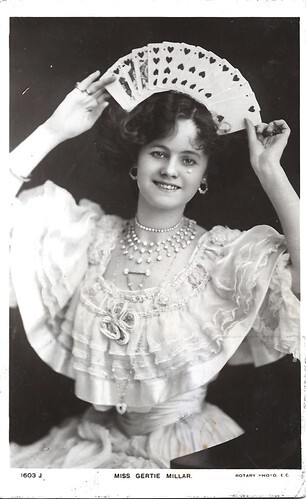
British postcard by Rotary Photo, no. 1603 J.
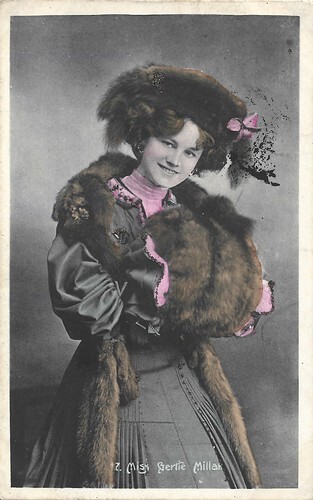
British postcard in the Silverine series by Ray & Co., London.
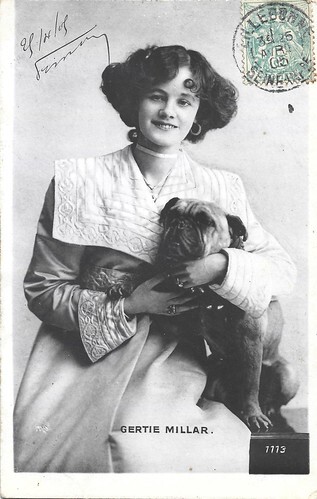
Vintage postcard, probably German by C.B.N.St., series 17-6 Dess., no. 7773. Mailed in Lillebonne, France, 25-4-1905.
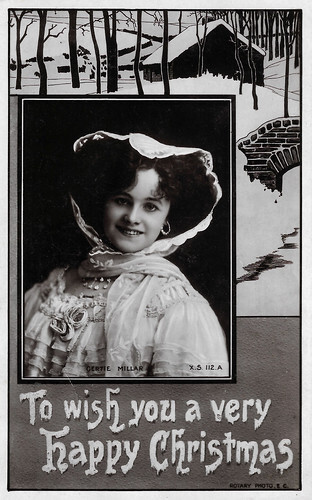
British postcard by Rotary Photo, no. S.S. 112A. Caption: To wish you a very happy Christmas.
Sources: Sydney Higgins (The Golden Age of British Theatre (1880-1920)), Wikipedia (Dutch and English), and .

British postcard by The Rapid Photo Printing Co., London, no. 1828. Printed in Belgium.

British postcard by Ed. Raphael Tuck & Sons, Photochrome, no. 331 B. Photo: Bassano.

British postcard in the Philco Series, no. 2012 D. Photo: Bassano.

British postcard in the Empire Series, London, no. 28. Printed in Berlin.
Prima donna at London's Gaiety Theatre
Gertie Millar was born in 1879 in Manningham, Bradford, as Gertrude Miller. Her father, John Millar, was a mill worker and her mother, Elizabeth Millar, a seamstress. Gertie grew up to be tall, thin and attractive with dark hair and large limpid eyes. She was also tough, determined and ambitious.
At 13, she made her stage debut in a children's show. Gertie played Lily in the pantomime 'Babes in the Wood' (1892) in the St James's Theatre in Manchester. She also started singing and dancing in variety theatres in Yorkshire. Not long after, Gertie moved to London and started working in theatres there. Soon, she earned substantial sums and attracted much attention for her performances.
Her other early roles include Phyllis Crosby in the musical comedy 'A Game of Cards' (Shodfriars Hall, Boston, 1897); Dora in 'The New Barmaid' (a UK tour in 1898); 'The Silver Lining' (UK tour, 1898); Sadie Pinkhose in 'The Lady Detective' (UK tour, 1898); and Dandini in 'Cinderella' (Grand Theatre, Fulham, London, 1899).
In 1901, Lionel Monckton (1861-1924), an Oxford University-educated lawyer and theatre critic turned composer, gave Millar the role of Isabel Blyth in the musical 'The Messenger Boy'. She performed several songs in it that were very popular with the audience and made Millar a star. She married Monckton in 1902.
Gertie Millar's early career had coincided with the rise of operettas and musical comedies. This new form of entertainment in the Edwardian period was supported by George Edwardes, the manager of London's Gaiety Theatre and Daly's Theatres. The year before, the famous theatre manager had lost his star, Marie Tempest, after a disagreement over a costume, and he recruited Gertie Millar to be the new leading lady in his productions. From 1901 to 1910, Millar became the prima donna at the Gaiety Theatre in a series of highly successful musicals composed for her by her husband, Lionel Monckton, and Ivan Caryll.

British postcard in the 'Celebrities of the stage' series by Raphael Tuck & Sons, no. 234 (?).

British postcard by Rotary, no. 459 V. Photo: W.& D. Downey, London.

British postcard in the Star Series by Gottschalk, Dreyfuss & Davis, London. The card was printed in Germany. Millar's name is misspelt as Miller.
One of the most photographed actresses of the Edwardian era
One of Gertie Millar's greatest triumphs was her role as Bridesmaid Cora in her first musical for George Edwardes, 'The Toreador'(1901). During a national Gaitey Theatre Tour, she performed the role 675 times. Her next role was as Mary Gibbs in the musical 'Our Miss Gibbs' that opened at the Gaiety on 23 January 1902. Sydney Higgins at The Golden Age of British Theatre (1880-1920): "Its strong cast included George Grossmith jr., Robert Hale, Edmund Payne, Denise Orme, Jean Aylwin, Gladys Homfrey and Kitty Mason, but Gertie Millar was, without doubt, the star and made her the best known musical comedy performer in the country." Millar became one of the most photographed actresses of the Edwardian era, along with Lily Elsie and Gabrielle Ray.
The Gaiety Theatre closed for renovations in 1902, and the last show at the old theatre was 'The Linkman; or, Gaiety Memories', with Millar starring as Morgiana. In 1903, the new Gaiety Theatre opened in the presence of His Majesty King Edward VI and Queen Alexandra with the premiere of the musical comedy 'The Orchid' (1903) with Gertie Millar starring as Violet Anstruther. The show ran for 559 performances. Success after success followed during the next decade. Her other roles included Rosalie in 'The Spring Chicken' (Gaiety Theatre, 1905); Lally in 'The New Aladdin' (Gaiety Theatre, 1906); Mitzi, the innkeeper's daughter in 'The Girls of Gottenberg' (Gaiety Theatre, 1907-1908 and Broadway in 1908); Franzi in 'A Waltz dream' the English-language production of the Operetta 'Ein Walzertraum' by Oscar Straus (Hicks Theater, 1908); and Prudence Pym in 'The Quaker Girl' in Edwardes' new Adelphi Theatre (1910). The latter ran for an extremely successful 536 performances.
Some of Millar's songs became famous, such as 'Keep Off the Grass' from 'The Toreador' (1901), 'Berlin Is On The Spree' from 'The Girls of Gottenberg' (1907) and 'Moonstruck' from 'Our Miss Gibbs' (1902), a hit song which Monkton had written especially for his wife. Her later roles included Lady Babby in 'Gipsy Love' after the Franz Léhar Operetta 'Zigeunerliebe' (Daly's Theatre, 1912); Nancy Joyce in 'The Dancing Mistress' (Adelphi, 1912); 'The Marriage Market' (Daly's, 1912), and Nan in 'The Country Girl' (Daly's, 1914). Millar continued to perform during the First World War, but it brought a change in the tastes of the theatregoing public. Edwardes died in 1915, and Millar's husband, Lionel Monckton, was in poor health.
At the Palace Theatre, Gertie Millar starred in Monckton's revues 'Bric a Brac' (1915) and 'Airs and Graces' (1917), and the musical comedies 'Houp-La' (1916) and 'Flora' (1918). Monckton's style no longer shone as brightly as in the past, and Millar was considered a star of the earlier Edwardian period. New stars were emerging to cater to the new tastes of the post-war generation. Audiences were now flocking to the comfort of the new cinema palaces for their escapism. In 1918, she made her final appearance at the Alhambra Theatre in Bradford, the city where she had been born. Millar's marriage to Monckton had not been a happy one, and she even asked for a divorce, but Lionel refused to grant it. Only after Monckton died in 1924, she remarried William Humble Ward, Second Earl of Dudley, becoming the Countess of Dudley. Before the war, he had been the Governor-General of Australia. Gertie Millar, the working-class girl from Yorkshire who grew up to be one of the best-loved stars and most photographed women of the Edwardian era, had become Lady Dudley. Her husband died in 1932. Twenty years later, Lady Dudley passed away in 1952 in Chiddingford, England.
But did Gertie Millar also appear on screen? According to IMDb and Wikipedia , the actress was known for the American silent film The House of Bondage (Pierce Kingsley, Raymond B. West, 1914). In this lost drama, Lottie Pickford (yes, Mary's sister) plays a young girl rebelling against her strict school and who is then tricked by a romantic suitor into prostitution. The film was produced by the Photo Drama Company and was based on the novel by Reginald Wright Kauffman. Marlene Pilaete, also known as EFSP 's own Ms. Sherlock, has doubts about this info: "The Library of Congress mentions the actress in the film as Miller instead of Millar, so this may refer to somebody else. Apart from Millar's performance in Broadway, nothing is known about any additional work in the US, and it would be strange for such a musical star to travel to the US to play a small supporting part in an American production. Instead, in 1912 a Gertrude Miller played a child in the American film, A Western Child's Heroism. Maybe this was the same Miller? 'The House of Bondage' was performed in 1908-1909 in London as a stage play, and directed by Herbert Beerbohm Tree , but without Gertie Millar."

British postcard by Rotary Photo, no. 1603 J.

British postcard in the Silverine series by Ray & Co., London.

Vintage postcard, probably German by C.B.N.St., series 17-6 Dess., no. 7773. Mailed in Lillebonne, France, 25-4-1905.

British postcard by Rotary Photo, no. S.S. 112A. Caption: To wish you a very happy Christmas.
Sources: Sydney Higgins (The Golden Age of British Theatre (1880-1920)), Wikipedia (Dutch and English), and .
Published on August 18, 2025 22:00
August 17, 2025
Ramon Novarro
Mexican-American actor Ramon Novarro (1899-1968) was promoted as 'The Latin Lover' and became one of the top box office attractions of the 1920s and early 1930s. In 1925 he appeared in his most famous role, as the title character in Ben-Hur: A Tale of the Christ (Fred Niblo, 1925). He later co-starred with Norma Shearer in The Student Prince in Old Heidelberg (Ernst Lubitsch, 1927) and with Greta Garbo in Mata Hari (George Fitzmaurice, 1931). Novarro also worked in the European cinema. In 1968 he was murdered by two young hustlers.
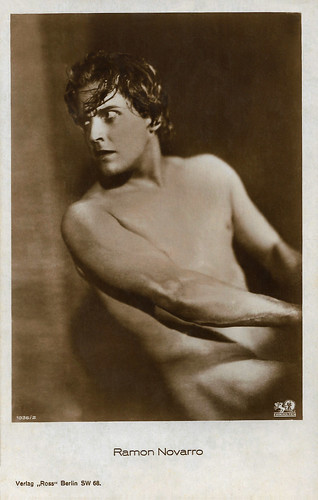
German postcard by Ross Verlag, Berlin, no. 1036/2. Photo: Bragaglia / Phoebus Film. Ramon Novarro in Ben-Hur: A Tale of the Christ (Fred Niblo, 1925).
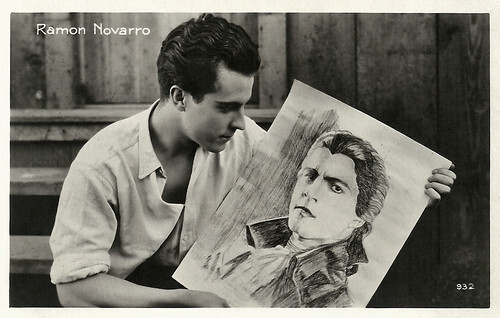
Italian postcard by Ed. Vettori, Bologna, no. 932. Ramon Novarro held a sketch for the period piece Scaramouche (Rex Ingram, 1923), in which Novarro had the title role. The film, produced by Metro Pictures, was based on a novel by Rafael Sabatini and co-starred Lewis Stone and Alice Terry .
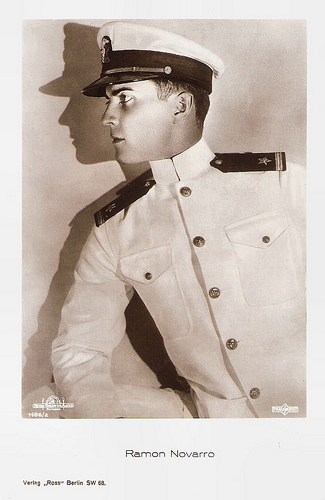
German postcard by Ross Verlag, no. 1486/2, 1927-1928. Photo: MGM / ParUfaMet. Ramon Novarro in The Midshipman (Christy Cabanne, 1925)

German postcard by Ross Verlag, no. 2021/1, 1927-1928. Photo: Fanamet. Ramon Novarro in Lovers? (John M. Stahl, 1927).
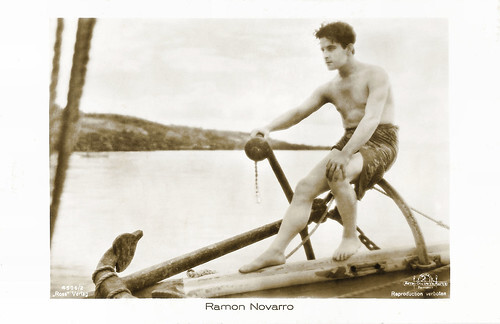
German postcard by Ross Verlag, no. 4907/2, 1929-1930. Photo: MGM. Publicity still for The Pagan (W.S. Van Dyke, 1929).
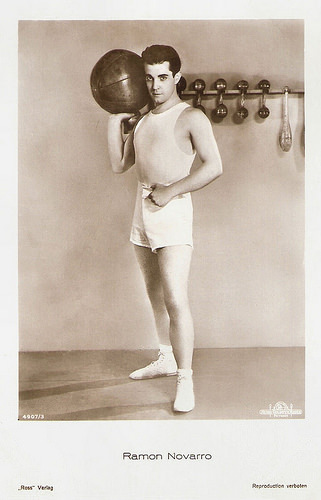
German postcard by Ross Verlag, no. 4907/3, 1929-1930. Photo: MGM. Ramon Novarro in The Flying Fleet (George W. Hill, 1929).
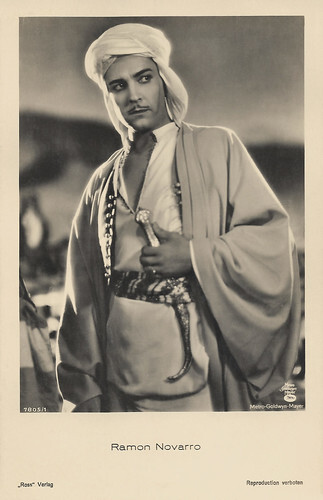
German postcard by Ross Verlag, no. 7805/1, 1932-1933. Photo: MGM. Ramon Novarro in The Barbarian / A Night in Cairo (Sam Wood, 1933).
The new Valentino
Ramon Novarro was born Jose Ramón Gil Samaniego in 1899 in Durango, Mexico. His parents were Leonor (Gavilan) and Dr. Mariano N. Samaniego Siqueiros, a wealthy dentist. Ramon and his family moved to Los Angeles in 1913, as refugees from the Mexican Revolution. He was a second cousin of the Mexican film star Dolores del Rio .
The family's wealth having been left behind, young Novarro took on several odd jobs, ranging from ballet dancer, piano teacher and singing waiter. In 1917, he became a film extra. Ramon worked as an extra until director Rex Ingram cast him as the lovable scoundrel Rupert of Hentzau in The Prisoner of Zenda (1922) with Lewis Stone and Alice Terry . Ramon scored an immediate hit. He was billed as Ramon Samaniegos and Terry suggested that he would change his name to Novarro. And so he did.
Ramon Novarro worked with Ingram in his next four films. Ingram again teamed him with Terry and Stone in the successful costume adventure Scaramouche (Rex Ingram, 1923). Novarro played a law student who becomes an outlaw French revolutionary when he decides to avenge the unjust killing of his friend. Ron Oliver at IMDb : "Novarro, taking the hero role this time, proved he was no flash in the pan. Equally adept as a sensitive lover or duelling revolutionary, with this performance, Novarro was catapulted to Hollywood's upper ranks."
Novarro's rising popularity among female moviegoers resulted in his being billed as the 'New Valentino' and as 'The Latin Lover'. In 1925 he appeared in his most famous role, as Judah Ben-Hur in Ben-Hur: A Tale of the Christ (Fred Niblo, 1925). At IMDb , John Nicolaus reviews: "I found Ramon Navarro far more likeable in the title role than Charlton Heston . Like with most silent films, Navarro is a bit over the top, but he's still portrayed as an honest and kind, yet proud figure. He also has a very kind face, which helps the audience 'fall' for this guy."
With Valentino's death in 1926, Novarro became the screen's leading Latin actor. He co-starred with Norma Shearer in The Student Prince in Old Heidelberg (Ernst Lubitsch, 1927). Lubitsch made an enjoyable Viennese fairy tale in which Novarro played a cloistered, overprotected Austrian prince who falls in love with a down-to-earth barmaid (Shearer). Ron Oliver at IMDb : "This wonderful, exuberant, heartbreaking film - one of the last major movies of the Silent Era - is a scintillating example of the artistry of director Ernst Lubitsch. Filled with wry humour & aching pathos, Lubitsch tells a tale which is a persuasive paean to the power of the talkless film. Ramon Novarro, always eager to please his audience, brings great charm to the title role. Although about 10 years too old to be playing a typical university freshman, he nonetheless brings tremendous enthusiasm to the role."

German postcard by Ross Verlag, no. 697/5, 1919-1924. Photo: BAFAG (British-American-Films A.G.). Ramon Novarro and Barbara la Marr in The Prisoner of Zenda (Rex Ingram, 1922).
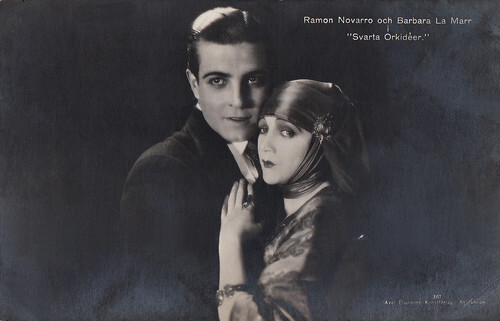
Swedish postcard by Axel Eliassons Konstförlag, Stockholm, no. 361. Barbara la Marr and Ramon Novarro in Trifling Women (Rex Ingram, 1922). Collection: Marlene Pilaete.
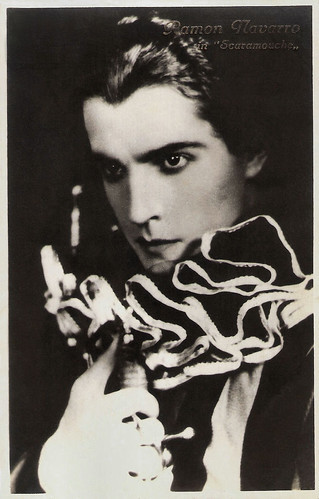
Italian postcard by G.B. Falci, Milano, no. 457. Ramon Novaro in Scaramouche (Rex Ingram, 1923).
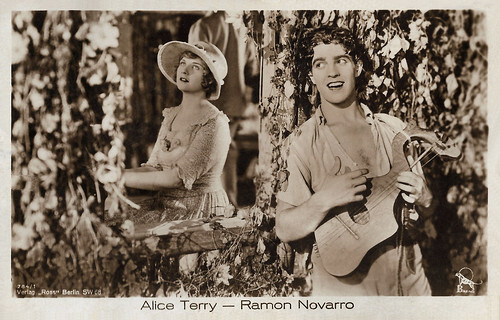
German postcard by Ross Verlag, Berlin, no. 784/1. Photo: Bafag. Alice Terry and Ramon Novarro in Where the Pavement Ends (Rex Ingram, 1923).
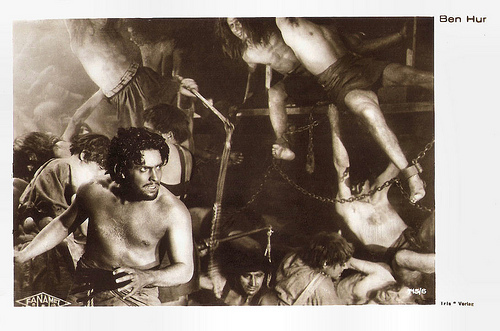
Austrian postcard by Iris Verlag, no. 715/6. Photo: FaNaMet. Publicity still for Ben-Hur: A Tale of the Christ (Fred Niblo, 1925).
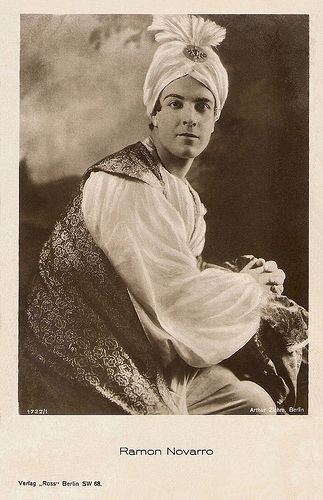
German postcard by Ross Verlag, no. 1722/1, 1927-1928. Photo: Arthur Ziehm, Berlin. Novarro is dressed in the attire of his film A Lover's Oath (Ferdinand P. Earle, 1925), based on Edward Fitzgerald's The Rubaiyat of Omar Khayyam, the Astronomer-Poet of Persia. From this film, only a short clip remains.

Austrian postcard by Iris Verlag, no. 5326. Photo: Metro-Goldwyn-Mayer. Ramon Novarro in The Road to Romance (John S. Robertson, 1927).

German postcard by Ross Verlag, no. 98/9. Photo: Metro-Goldwyn-Mayer. Publicity still for The Student Prince of Old Heidelberg (Ernst Lubitsch, 1927).
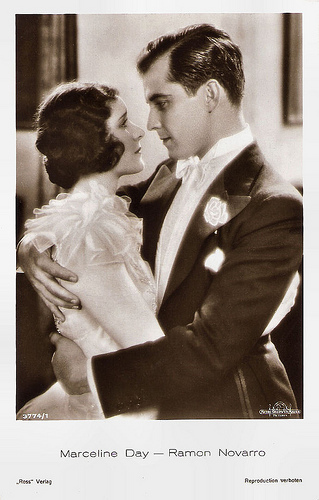
German postcard by Ross Verlag, no. 3774/2, 1928-1929. Photo: Metro-Goldwyn-Mayer. Publicity still for A Certain Young Man (Hobart Henley, 1928) with Marceline Day .
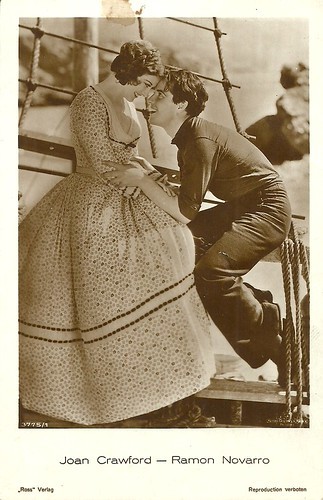
German postcard by Ross Verlag, no. 3775/1, 1928-1929. Photo: Metro-Goldwyn-Mayer. Joan Crawford and Ramon Novarro in Across to Singapore (William Nigh, 1928).
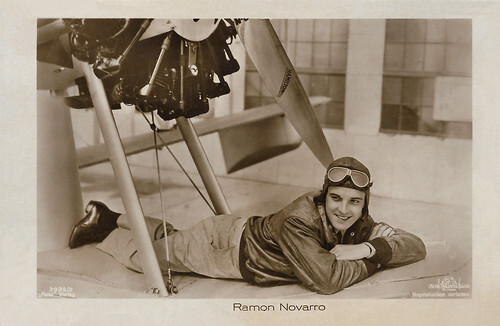
German postcard by Ross Verlag, no. 3926/2, 1928-1929. Photo: Metro-Goldwyn-Mayer. Ramon Novarro during the making of The Flying Fleet (George W. Hill, 1929).
Savagely beaten by two young hustlers
At the peak of his success in the late 1920s and early 1930s, Ramon Novarro was earning more than US$100,000 per film. His first talking picture was Call of the Flesh (Charles Brabin, 1930), where he sang and danced the tango. He continued to appear in musicals, but his popularity was slipping. MGM insisted on giving their Mexican star a wide range of ethnic parts, everything from a carefree South Seas native in The Pagan (W.S. Van Dyke, 1929) to a wealthy Indian jewel merchant in Son of India (Jacques Feyder, 1931).
He was not given many top-notch assignments, but he did star with Greta Garbo in Mata Hari (George Fitzmaurice, 1931), a semi-fictionalised account of the life of the exotic dancer who was accused of spying for Germany during World War I. She falls in love for the first and only time in her life when she meets dazzlingly handsome Lieutenant Ramon Novarro. Ron Oliver at IMDb : "Ramon Novarro, who receives co-equal billing with Garbo, had been an important movie celebrity far longer than she, but her rising sun tended to obscure most other stars in her orbit and Novarro has to work hard to get much notice in their joint scenes. As always, MGM's chameleon actor (this time he plays a Russian) gives a very competent performance, but as a romantic pair they make a rather unusual couple - which simply means that Novarro's sexual ambiguity is perfectly mirrored by Garbo's intrinsic androgyny."
Mata Hari was a success, but soon Novarro's career began to fade fast. In 1935 he left MGM and appeared on Broadway in a show that quickly flopped. Though wealthy enough not to need work, Novarro was restless when not before the cameras. His later career consisted mostly of cameos. In Europe, he was still popular. In France, he starred in La comédie du bonheur / Comedy of Happiness (Marcel L'Herbier, 1940) opposite Michel Simon . He also appeared in the Italian version, Ecco la felicità (Marcel L'Herbier, 1940). In Mexico, he starred in La virgen que forjó una patria / The Saint That Forged a Country (Julio Bracho, 1942).
After the war, Novarro returned to Hollywood as a supporting actor and appeared in such films as We Were Strangers (John Huston, 1949) and the Film Noir The Big Steal (Don Siegel, 1949), starring Robert Mitchum . His last film was Heller in Pink Tights (George Cukor, 1960) with Sophia Loren . Later he guest-starred in TV series such as Rawhide (1964), Bonanza (1965) and The High Chaparral (1968).
Ramon Novarro was troubled all his life by his conflicted feelings toward his Roman Catholic religion and his homosexuality. His life-long struggle with alcoholism is often traced to these issues. He was romantically involved with journalist Herbert Howe, who was also his publicist in the late 1920s. In 1968, Novarro was savagely beaten in his North Hollywood home by two young hustlers, the brothers Paul and Tom Ferguson, aged 22 and 17. They had heard - in error - that a large sum of money was locked away somewhere in his home. They never found any money, and Novarro was discovered dead the next day by his servant. Novarro died as a result of asphyxiation—having choked to death on his own blood after being beaten. He was less than four months away from what would have been his 70th birthday.
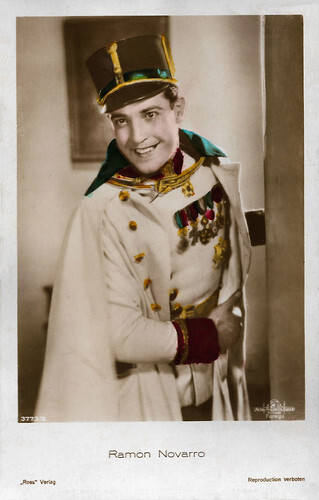
British postcard by Ross Verlag Foreign, no. 3773/2, 1928-1929. Photo: Metro-Goldwyn-Mayer. Ramon Novarro in Forbidden Hours (Harry Beaumont, 1928).
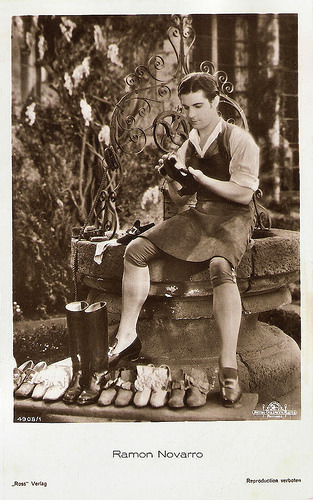
German postcard by Ross Verlag, Berlin, no. 4908/1, 1929-1930. Photo: MGM. Publicity still for Devil-May-Care (Sidney Franklin, 1929).
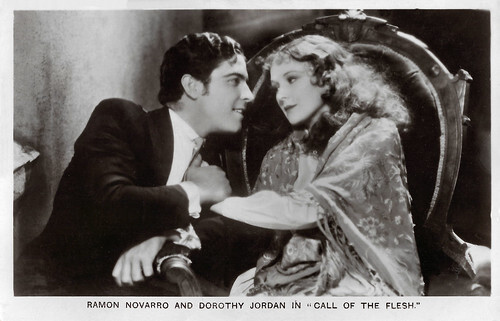
British postcard in the Picturegoer Series, London, no. 516. Ramon Novarro and Dorothy Jordan in Call of the Flesh (Charles Brabin, 1930).
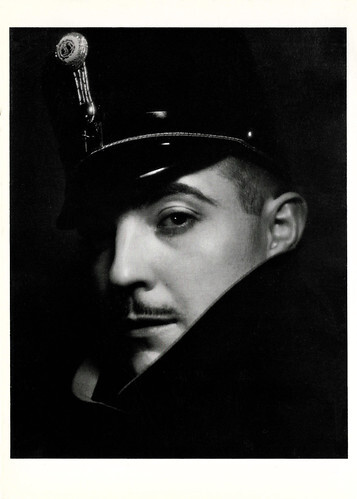
American postcard by Fotofolio, NY, NY, no. GH8. Photo: George Hurrell / Creative Art Images, Hollywood. Caption: Ramon Novarro, 1931. Publicity still for Daybreak (Jacques Feyder, 1931).
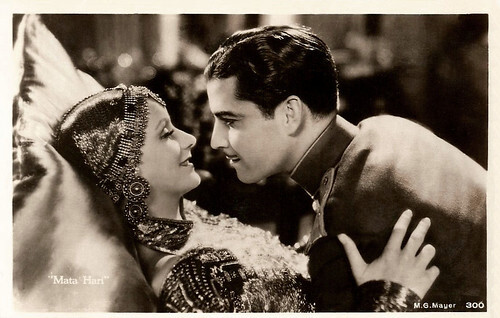
Dutch postcard, no. 300. Photo: Metro-Goldwyn-Mayer. Ramon Novarro and Greta Garbo in Mata Hari (George Fitzmaurice, 1931).
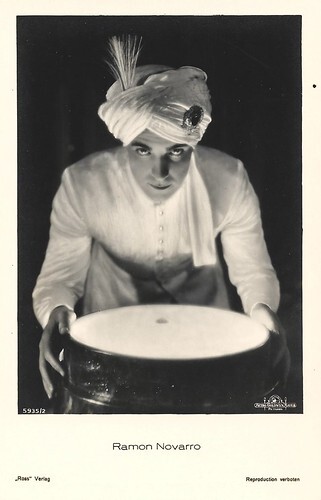
German postcard by Ross Verlag / Ballerini & Fratini, Firenze, no. 535/2. Photo: Metro-Goldwyn-Mayer. Ramon Novarro in Son of India (Jacques Feyder, 1931).
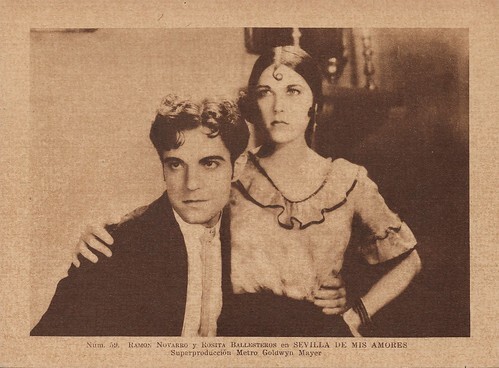
Spanish collector's card in the series Estampas del cinema, no. 59, by Editorial Gráfica Barcelona, series 8, 1931, no. 3 of 8. Photo: Metro-Goldwyn-Mayer. Ramon Novarro and Rosita Ballesteros in Sevilla de mis amores / La Sevillana (Ramon Novarro, 1931).
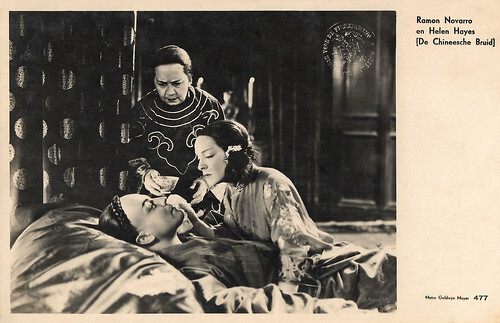
Dutch postcard, no. 477. Photo: Metro Goldwyn Mayer. Ramon Novarro and Helen Hayes in The Son-Daughter (Clarence Brown, 1932).
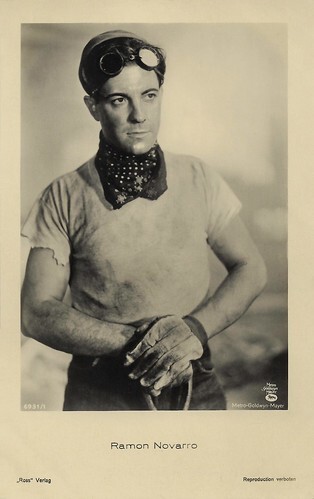
German postcard by Ross Verlag, no. 6931/1, 1931-1932. Photo: Metro Goldwyn Mayer. Ramon Novarro in Huddle (Sam Wood, 1932).
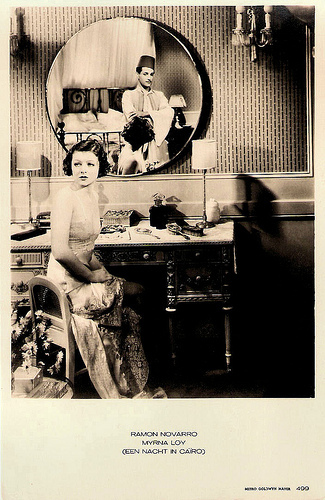
Dutch postcard, no. 499. Photo: Metro-Goldwyn-Mayer. Publicity still for The Barbarian (Sam Wood, 1933) with Myrna Loy .
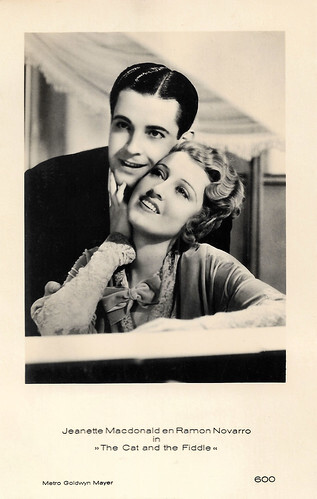
Dutch postcard, no. 600. Photo: M.G.M. Jeanette MacDonald and Ramon Novarro in The Cat and the Fiddle (William K. Howard, 1934).
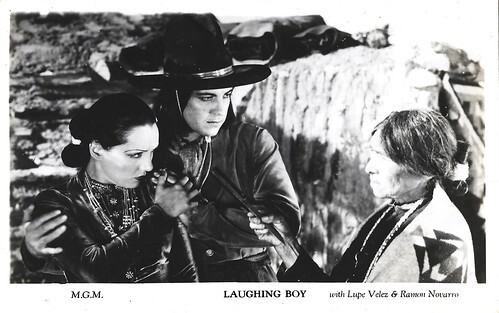
British postcard in the Film Weekly. Photo: MGM. Ramon Novarro and Lupe Velez in Laughing Boy (W.S. Van Dyke, 1934). It was the only film Novarro regretted having made, as he looked unconvincing as a Navajo Indian. Still, as Samuel Wilson remarked in 2018, " Lupe Velez 's performance and an unusually complex portrait of Native American life make Laughing Boy worth a look regardless of its consequences for its star's career." It was Novarro's one but last film at MGM before his contract there expired. The film was also no success at the box office.
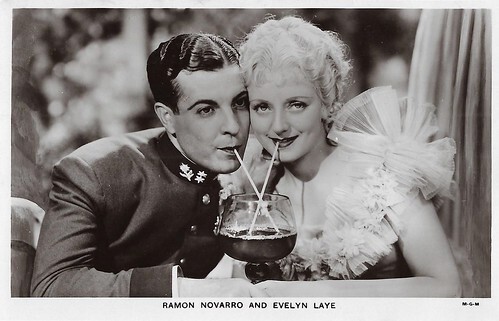
British postcard in the Film Partners series, no. P. 155. Photo: Metro-Goldwyn-Mayer. Ramon Novarro and Evelyn Laye in The Night is Young (Dudley Murphy, 1935), based on a story by Vicki Baum.
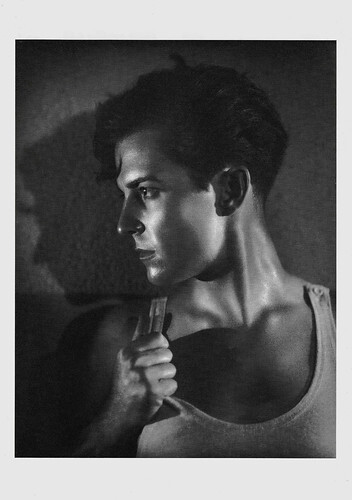
British postcard by Foto-Roff in the Black and Whites Gallery, London, no. 1060. Photo: George Hurrell, 1929 / Kobal Collection.
Source: Hal Erickson (AllMovie - Page now defunct), (IMDb), TCM, Wikipedia and .

German postcard by Ross Verlag, Berlin, no. 1036/2. Photo: Bragaglia / Phoebus Film. Ramon Novarro in Ben-Hur: A Tale of the Christ (Fred Niblo, 1925).

Italian postcard by Ed. Vettori, Bologna, no. 932. Ramon Novarro held a sketch for the period piece Scaramouche (Rex Ingram, 1923), in which Novarro had the title role. The film, produced by Metro Pictures, was based on a novel by Rafael Sabatini and co-starred Lewis Stone and Alice Terry .

German postcard by Ross Verlag, no. 1486/2, 1927-1928. Photo: MGM / ParUfaMet. Ramon Novarro in The Midshipman (Christy Cabanne, 1925)

German postcard by Ross Verlag, no. 2021/1, 1927-1928. Photo: Fanamet. Ramon Novarro in Lovers? (John M. Stahl, 1927).

German postcard by Ross Verlag, no. 4907/2, 1929-1930. Photo: MGM. Publicity still for The Pagan (W.S. Van Dyke, 1929).

German postcard by Ross Verlag, no. 4907/3, 1929-1930. Photo: MGM. Ramon Novarro in The Flying Fleet (George W. Hill, 1929).

German postcard by Ross Verlag, no. 7805/1, 1932-1933. Photo: MGM. Ramon Novarro in The Barbarian / A Night in Cairo (Sam Wood, 1933).
The new Valentino
Ramon Novarro was born Jose Ramón Gil Samaniego in 1899 in Durango, Mexico. His parents were Leonor (Gavilan) and Dr. Mariano N. Samaniego Siqueiros, a wealthy dentist. Ramon and his family moved to Los Angeles in 1913, as refugees from the Mexican Revolution. He was a second cousin of the Mexican film star Dolores del Rio .
The family's wealth having been left behind, young Novarro took on several odd jobs, ranging from ballet dancer, piano teacher and singing waiter. In 1917, he became a film extra. Ramon worked as an extra until director Rex Ingram cast him as the lovable scoundrel Rupert of Hentzau in The Prisoner of Zenda (1922) with Lewis Stone and Alice Terry . Ramon scored an immediate hit. He was billed as Ramon Samaniegos and Terry suggested that he would change his name to Novarro. And so he did.
Ramon Novarro worked with Ingram in his next four films. Ingram again teamed him with Terry and Stone in the successful costume adventure Scaramouche (Rex Ingram, 1923). Novarro played a law student who becomes an outlaw French revolutionary when he decides to avenge the unjust killing of his friend. Ron Oliver at IMDb : "Novarro, taking the hero role this time, proved he was no flash in the pan. Equally adept as a sensitive lover or duelling revolutionary, with this performance, Novarro was catapulted to Hollywood's upper ranks."
Novarro's rising popularity among female moviegoers resulted in his being billed as the 'New Valentino' and as 'The Latin Lover'. In 1925 he appeared in his most famous role, as Judah Ben-Hur in Ben-Hur: A Tale of the Christ (Fred Niblo, 1925). At IMDb , John Nicolaus reviews: "I found Ramon Navarro far more likeable in the title role than Charlton Heston . Like with most silent films, Navarro is a bit over the top, but he's still portrayed as an honest and kind, yet proud figure. He also has a very kind face, which helps the audience 'fall' for this guy."
With Valentino's death in 1926, Novarro became the screen's leading Latin actor. He co-starred with Norma Shearer in The Student Prince in Old Heidelberg (Ernst Lubitsch, 1927). Lubitsch made an enjoyable Viennese fairy tale in which Novarro played a cloistered, overprotected Austrian prince who falls in love with a down-to-earth barmaid (Shearer). Ron Oliver at IMDb : "This wonderful, exuberant, heartbreaking film - one of the last major movies of the Silent Era - is a scintillating example of the artistry of director Ernst Lubitsch. Filled with wry humour & aching pathos, Lubitsch tells a tale which is a persuasive paean to the power of the talkless film. Ramon Novarro, always eager to please his audience, brings great charm to the title role. Although about 10 years too old to be playing a typical university freshman, he nonetheless brings tremendous enthusiasm to the role."

German postcard by Ross Verlag, no. 697/5, 1919-1924. Photo: BAFAG (British-American-Films A.G.). Ramon Novarro and Barbara la Marr in The Prisoner of Zenda (Rex Ingram, 1922).

Swedish postcard by Axel Eliassons Konstförlag, Stockholm, no. 361. Barbara la Marr and Ramon Novarro in Trifling Women (Rex Ingram, 1922). Collection: Marlene Pilaete.

Italian postcard by G.B. Falci, Milano, no. 457. Ramon Novaro in Scaramouche (Rex Ingram, 1923).

German postcard by Ross Verlag, Berlin, no. 784/1. Photo: Bafag. Alice Terry and Ramon Novarro in Where the Pavement Ends (Rex Ingram, 1923).

Austrian postcard by Iris Verlag, no. 715/6. Photo: FaNaMet. Publicity still for Ben-Hur: A Tale of the Christ (Fred Niblo, 1925).

German postcard by Ross Verlag, no. 1722/1, 1927-1928. Photo: Arthur Ziehm, Berlin. Novarro is dressed in the attire of his film A Lover's Oath (Ferdinand P. Earle, 1925), based on Edward Fitzgerald's The Rubaiyat of Omar Khayyam, the Astronomer-Poet of Persia. From this film, only a short clip remains.

Austrian postcard by Iris Verlag, no. 5326. Photo: Metro-Goldwyn-Mayer. Ramon Novarro in The Road to Romance (John S. Robertson, 1927).

German postcard by Ross Verlag, no. 98/9. Photo: Metro-Goldwyn-Mayer. Publicity still for The Student Prince of Old Heidelberg (Ernst Lubitsch, 1927).

German postcard by Ross Verlag, no. 3774/2, 1928-1929. Photo: Metro-Goldwyn-Mayer. Publicity still for A Certain Young Man (Hobart Henley, 1928) with Marceline Day .

German postcard by Ross Verlag, no. 3775/1, 1928-1929. Photo: Metro-Goldwyn-Mayer. Joan Crawford and Ramon Novarro in Across to Singapore (William Nigh, 1928).

German postcard by Ross Verlag, no. 3926/2, 1928-1929. Photo: Metro-Goldwyn-Mayer. Ramon Novarro during the making of The Flying Fleet (George W. Hill, 1929).
Savagely beaten by two young hustlers
At the peak of his success in the late 1920s and early 1930s, Ramon Novarro was earning more than US$100,000 per film. His first talking picture was Call of the Flesh (Charles Brabin, 1930), where he sang and danced the tango. He continued to appear in musicals, but his popularity was slipping. MGM insisted on giving their Mexican star a wide range of ethnic parts, everything from a carefree South Seas native in The Pagan (W.S. Van Dyke, 1929) to a wealthy Indian jewel merchant in Son of India (Jacques Feyder, 1931).
He was not given many top-notch assignments, but he did star with Greta Garbo in Mata Hari (George Fitzmaurice, 1931), a semi-fictionalised account of the life of the exotic dancer who was accused of spying for Germany during World War I. She falls in love for the first and only time in her life when she meets dazzlingly handsome Lieutenant Ramon Novarro. Ron Oliver at IMDb : "Ramon Novarro, who receives co-equal billing with Garbo, had been an important movie celebrity far longer than she, but her rising sun tended to obscure most other stars in her orbit and Novarro has to work hard to get much notice in their joint scenes. As always, MGM's chameleon actor (this time he plays a Russian) gives a very competent performance, but as a romantic pair they make a rather unusual couple - which simply means that Novarro's sexual ambiguity is perfectly mirrored by Garbo's intrinsic androgyny."
Mata Hari was a success, but soon Novarro's career began to fade fast. In 1935 he left MGM and appeared on Broadway in a show that quickly flopped. Though wealthy enough not to need work, Novarro was restless when not before the cameras. His later career consisted mostly of cameos. In Europe, he was still popular. In France, he starred in La comédie du bonheur / Comedy of Happiness (Marcel L'Herbier, 1940) opposite Michel Simon . He also appeared in the Italian version, Ecco la felicità (Marcel L'Herbier, 1940). In Mexico, he starred in La virgen que forjó una patria / The Saint That Forged a Country (Julio Bracho, 1942).
After the war, Novarro returned to Hollywood as a supporting actor and appeared in such films as We Were Strangers (John Huston, 1949) and the Film Noir The Big Steal (Don Siegel, 1949), starring Robert Mitchum . His last film was Heller in Pink Tights (George Cukor, 1960) with Sophia Loren . Later he guest-starred in TV series such as Rawhide (1964), Bonanza (1965) and The High Chaparral (1968).
Ramon Novarro was troubled all his life by his conflicted feelings toward his Roman Catholic religion and his homosexuality. His life-long struggle with alcoholism is often traced to these issues. He was romantically involved with journalist Herbert Howe, who was also his publicist in the late 1920s. In 1968, Novarro was savagely beaten in his North Hollywood home by two young hustlers, the brothers Paul and Tom Ferguson, aged 22 and 17. They had heard - in error - that a large sum of money was locked away somewhere in his home. They never found any money, and Novarro was discovered dead the next day by his servant. Novarro died as a result of asphyxiation—having choked to death on his own blood after being beaten. He was less than four months away from what would have been his 70th birthday.

British postcard by Ross Verlag Foreign, no. 3773/2, 1928-1929. Photo: Metro-Goldwyn-Mayer. Ramon Novarro in Forbidden Hours (Harry Beaumont, 1928).

German postcard by Ross Verlag, Berlin, no. 4908/1, 1929-1930. Photo: MGM. Publicity still for Devil-May-Care (Sidney Franklin, 1929).

British postcard in the Picturegoer Series, London, no. 516. Ramon Novarro and Dorothy Jordan in Call of the Flesh (Charles Brabin, 1930).

American postcard by Fotofolio, NY, NY, no. GH8. Photo: George Hurrell / Creative Art Images, Hollywood. Caption: Ramon Novarro, 1931. Publicity still for Daybreak (Jacques Feyder, 1931).

Dutch postcard, no. 300. Photo: Metro-Goldwyn-Mayer. Ramon Novarro and Greta Garbo in Mata Hari (George Fitzmaurice, 1931).

German postcard by Ross Verlag / Ballerini & Fratini, Firenze, no. 535/2. Photo: Metro-Goldwyn-Mayer. Ramon Novarro in Son of India (Jacques Feyder, 1931).

Spanish collector's card in the series Estampas del cinema, no. 59, by Editorial Gráfica Barcelona, series 8, 1931, no. 3 of 8. Photo: Metro-Goldwyn-Mayer. Ramon Novarro and Rosita Ballesteros in Sevilla de mis amores / La Sevillana (Ramon Novarro, 1931).

Dutch postcard, no. 477. Photo: Metro Goldwyn Mayer. Ramon Novarro and Helen Hayes in The Son-Daughter (Clarence Brown, 1932).

German postcard by Ross Verlag, no. 6931/1, 1931-1932. Photo: Metro Goldwyn Mayer. Ramon Novarro in Huddle (Sam Wood, 1932).

Dutch postcard, no. 499. Photo: Metro-Goldwyn-Mayer. Publicity still for The Barbarian (Sam Wood, 1933) with Myrna Loy .

Dutch postcard, no. 600. Photo: M.G.M. Jeanette MacDonald and Ramon Novarro in The Cat and the Fiddle (William K. Howard, 1934).

British postcard in the Film Weekly. Photo: MGM. Ramon Novarro and Lupe Velez in Laughing Boy (W.S. Van Dyke, 1934). It was the only film Novarro regretted having made, as he looked unconvincing as a Navajo Indian. Still, as Samuel Wilson remarked in 2018, " Lupe Velez 's performance and an unusually complex portrait of Native American life make Laughing Boy worth a look regardless of its consequences for its star's career." It was Novarro's one but last film at MGM before his contract there expired. The film was also no success at the box office.

British postcard in the Film Partners series, no. P. 155. Photo: Metro-Goldwyn-Mayer. Ramon Novarro and Evelyn Laye in The Night is Young (Dudley Murphy, 1935), based on a story by Vicki Baum.

British postcard by Foto-Roff in the Black and Whites Gallery, London, no. 1060. Photo: George Hurrell, 1929 / Kobal Collection.
Source: Hal Erickson (AllMovie - Page now defunct), (IMDb), TCM, Wikipedia and .
Published on August 17, 2025 22:00
August 16, 2025
L'empereur des pauvres (1921)
L'empereur des pauvres / The Emperor of the Poor (René Leprince, 1921) is a beautiful French silent film serial, based on the epic novel by Felicien Champsau. The serial was produced by Pathé Frères Consortium and the stars were Léon Mathot and Gina Relly.
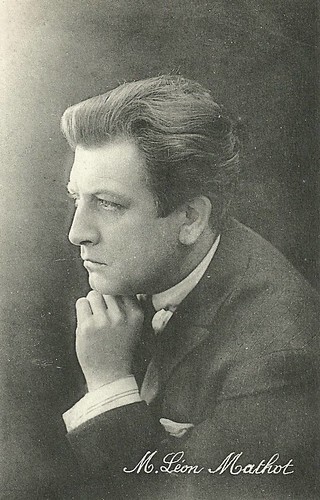
French postcard by M. Le Deley, Paris. Photo: Pathé Consortium Cinéma. Léon Mathot in L'empereur des pauvres / The Emperor of the poor (René Leprince, 1921).
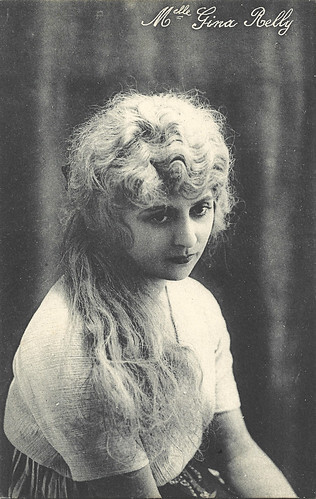
French postcard by M. Le Deley, Paris. Photo: Pathé Consortium Cinéma. Gina Relly in L'empereur des pauvres / The Emperor of the poor (René Leprince, 1921).
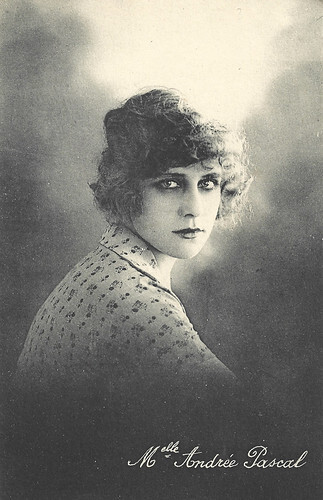
French postcard by M. Le Deley, Paris. Photo: Pathé Consortium Cinéma. Andrée Pascal in L'empereur des pauvres / The Emperor of the poor (René Leprince, 1921).
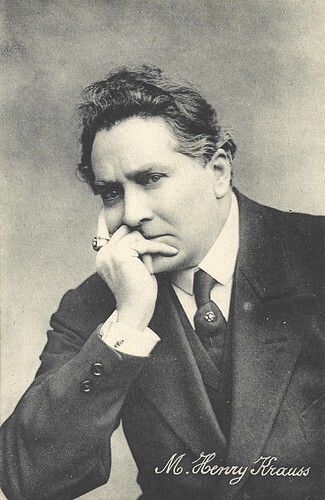
French postcard by M. Le Deley, Paris. Photo: Pathé Consortium Cinéma. Henry Krauss in L'empereur des pauvres / The Emperor of the poor (René Leprince, 1921).
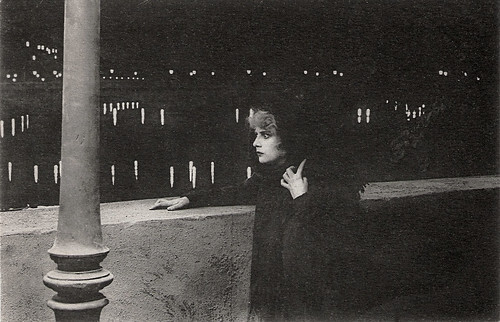
French postcard by M. Le Deley, Paris. Photo: Pathé Consortium Cinéma. Gina Relly in L'empereur des pauvres / The Emperor of the Poor (René Leprince, 1921).
A vagabond who wants to do good
French novelist and journalist Félicien Champsaur debuted with the roman à clef 'Dinah Samuel' (1882), said to present portraits of poet Arthur Rimbaud and actress Sarah Bernhardt. He went on to publish many novels, collections of articles, and other works, including 'Miss America' (1885), 'Entrée de clowns' (1886), 'Lulu' (1888), and 'Poupée Japonaise' (1912). He wrote 'L'empereur des pauvres' in 1920.
Based on Champsaur's novel, director René Leprince created the silent film serial, L'empereur des pauvres / The Emperor of the poor (René Leprince, 1921)..
The film serial tells the epic story of a rich and spoiled young man, Marc Anavan, played by Léon Mathot . Marc leads a profligate life, but when he understands his fortune is about to evaporate, he decides to change his life.
Marc becomes a vagabond and wants to do good around him. The task is not easy, but his faith in his mission and the love of the pure Sylvette ( Gina Relly ) help him.
Marc becomes the peaceful spokesperson for the disinherited. He has to face revolution, anarchism and the Great War, before retaking his humanitarian mission. In the end, he overcomes all the hardships on his way.
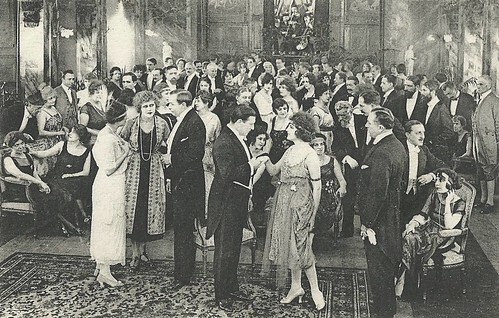
French postcard by M. Le Deley, Paris. Photo: Pathé Consortium Cinéma. Publicity still for L'empereur des pauvres / The Emperor of the Poor (René Leprince, 1921) with Léon Mathot as Marc Anavan.
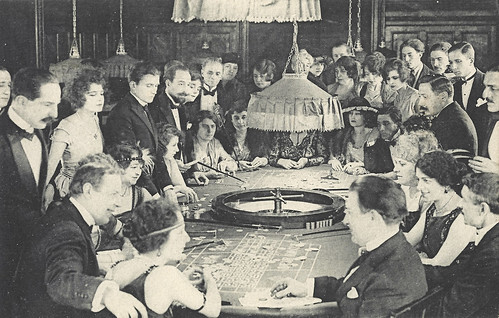
French postcard by M. Le Deley, Paris. Photo: Pathé Consortium Cinéma. Publicity still for L'empereur des pauvres / The Emperor of the Poor (René Leprince, 1921) with, probably downright, Léon Mathot as Marc Anavan.
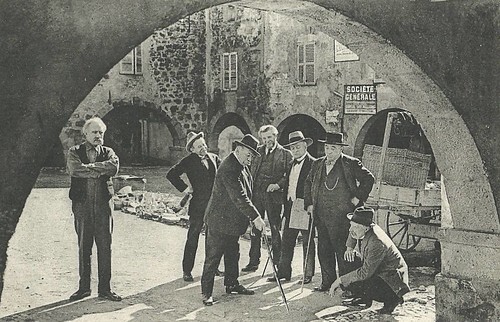
French postcard by M. Le Deley, Paris. Photo: Pathé Consortium Cinéma. Publicity still for L'empereur des pauvres / The Emperor of the Poor (René Leprince, 1921) with left, Henry Krauss , as Jean Sarrias, revolting against society.
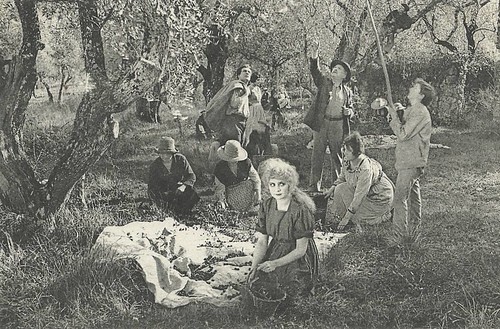
French postcard by M. Le Deley, Paris. Photo: Pathé Consortium Cinéma. Publicity still for L'empereur des pauvres / The Emperor of the Poor (René Leprince, 1921). In the foreground, Gina Relly as Sylvette. Standing in the back, Léon Mathot as Marc Anavan and Henry Krauss as Jean Sarrias.

French postcard by M. Le Deley, Paris. Photo: Pathé Consortium Cinéma. Publicity still for L'empereur des pauvres / The Emperor of the Poor (René Leprince, 1921). Probably Léon Mathot as Marc Anavan.
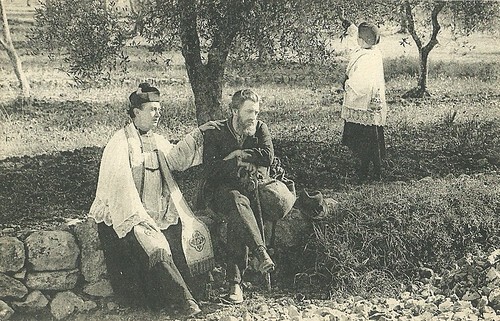
French postcard by M. Le Deley, Paris. Photo: Pathé Consortium Cinéma. Publicity still for L'empereur des pauvres / The Emperor of the Poor (René Leprince, 1921). Probably Léon Mathot as Marc Anavan.
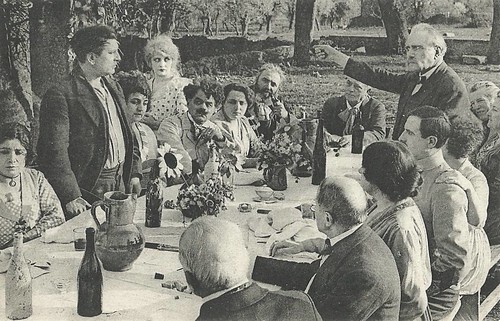
French postcard by M. Le Deley, Paris. Photo: Pathé Consortium Cinéma. Publicity still for L'empereur des pauvres / The Emperor of the Poor (René Leprince, 1921) with, at left, Léon Mathot as Marc Anavan, in the middle, Gina Relly as Sylvette, and right, Henry Krauss as her uncle Jean Sarrias.
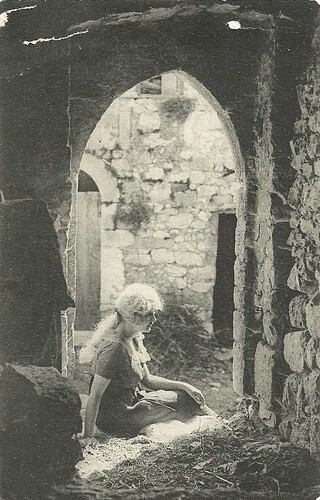
French postcard by M. Le Deley, Paris. Photo: Pathé Consortium Cinéma. Gina Relly in L'empereur des pauvres / The Emperor of the Poor (1921).
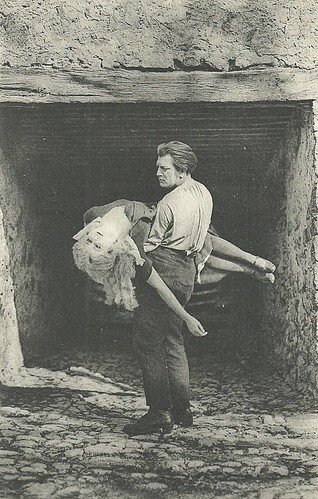
French postcard by M. Le Deley, Paris. Photo: Pathé Consortium Cinéma. Gina Relly as Sylvette and Léon Mathot as Marc Anavan in L'empereur des pauvres / The Emperor of the Poor (René Leprince, 1921).

French postcard by M. Le Deley, Paris. Photo: Pathé Consortium Cinéma. Léon Mathot as Marc Anavan, Gina Relly as Sylvette, and right, Henry Krauss , as her uncle Jean Sarrias in L'empereur des pauvres / The Emperor of the Poor (René Leprince, 1921). Left of Mathot is Andrée Pascal as Clémence Sarrias.
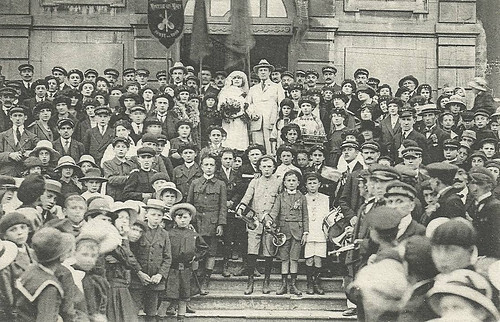
French postcard by M. Le Deley, Paris. Photo: Pathé Consortium Cinéma. Gina Relly and Léon Mathot in L'empereur des pauvres / The Emperor of the Poor (1921).
One of the most successful French serials
L'empereur des pauvres / The Emperor of the Poor (René Leprince, 1921) was produced in six episodes: 1. Le Pauvre (The Poor); 2. Les Millions (The Millions); 3. Les Flambeaux (The Torches); 4. Les Crassiers (The Slag); 5. L'orage (The Storm) and 6. Floreal.
On demand of exhibitors, these six episodes were re-edited into twelve parts of 900 metres each, which were shown over six weeks in France. The Pathé production was one of the most successful French serials of the period. In the Netherlands, the 12 parts were shown in three or two weeks.
Besides Léon Mathot and Gina Relly in the lead roles, the cast of L'empereur des pauvres included several well-known actors of the French silent cinema.
Henry Krauss played Jean Sarrias, the uncle of Silvette; Gilbert Dalleu was Cyprien Cadal, the mayor of Saint Saturnin du Var; Andrée Pascal appeared as Clémence Sarrias; and Lily Damita was Riquette, credited as Lily Deslys. In supporting parts well well-known faces as Charles Lamy, André Luguet , Charles de Rochefort and Maurice Schutz were cast.
The elaborate camera work was done by Julien Ringel and Paul Gaillard. Director René Leprince was a well-known filmmaker of the silent era, who had worked several times with comedian Max Linder and went on to make Fanfan La Tulipe (1925) with Aimé Simon-Girard . In 1929, Leprince died at the age of 53, at the end of the silent era.
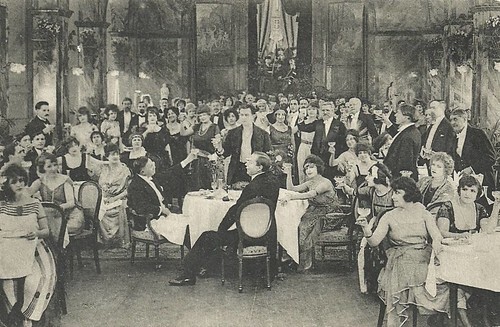
French postcard by M. Le Deley, Paris. Photo: Pathé Consortium Cinéma. Publicity still for L'empereur des pauvres / The Emperor of the poor (René Leprince, 1921). Standing in the middle, actor Léon Mathot .
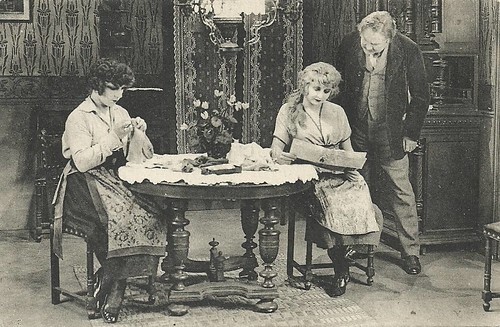
French postcard by M. Le Deley, Paris. Photo: Pathé Consortium Cinéma. Publicity still for L'empereur des pauvres / The Emperor of the Poor (René Leprince, 1921). In the middle, Gina Relly as Sylvette, and right, Henry Krauss as her uncle Jean Sarrias, revolting against society. Left could be Andrée Pascal as Clémence Sarrias.
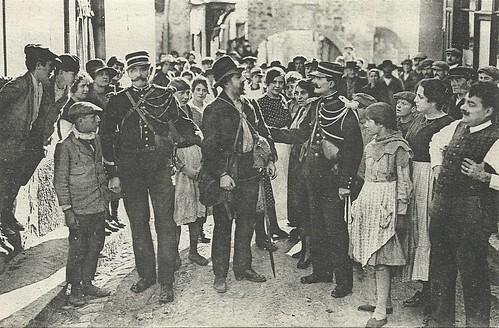
French postcard by M. Le Deley, Paris. Photo: Pathé Consortium Cinéma. Publicity still for L'empereur des pauvres / The Emperor of the Poor (René Leprince, 1921). The vagabond could be Léon Mathot .
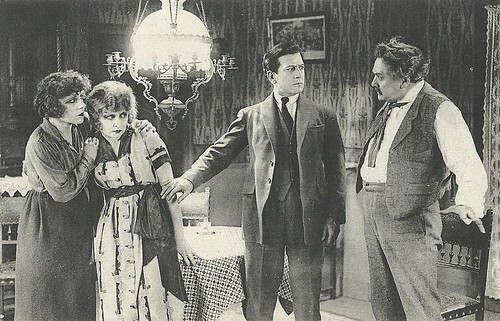
French postcard by M. Le Deley, Paris. Photo: Pathé Consortium Cinéma. Publicity still for L'empereur des pauvres / The Emperor of the Poor (René Leprince, 1921). Left to right: Andrée Pascal as Clémence Sarrias, Gina Relly as Sylvette, Léon Mathot as Marc Anavan, and Henry Krauss as Jean Sarrias.
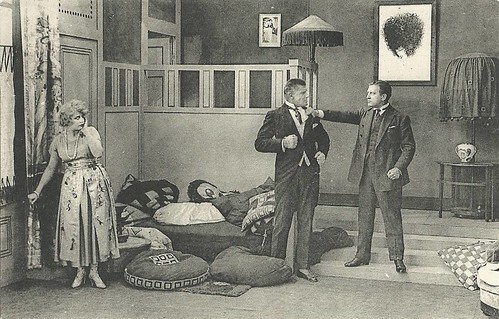
French postcard by M. Le Deley, Paris. Photo: Pathé Consortium Cinéma. Publicity still for L'empereur des pauvres / The Emperor of the poor (René Leprince, 1921). Gina Relly as Sylvette, Léon Mathot as Marc Anavan.

French postcard by M. Le Deley, Paris. Photo: Pathé Consortium Cinéma. Publicity still for L'empereur des pauvres / The Emperor of the poor (René Leprince, 1921). In bed: Gina Relly as Sylvette, left of her, Andrée Pascal as her sister Clémence.
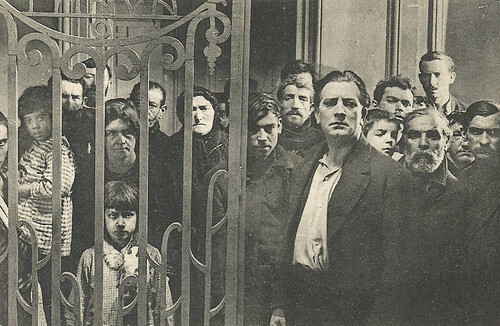
French postcard by M. Le Deley, Paris. Photo: Pathé Consortium Cinéma. Publicity still for L'empereur des pauvres / The Emperor of the Poor (René Leprince, 1921). Standing front, Léon Mathot .
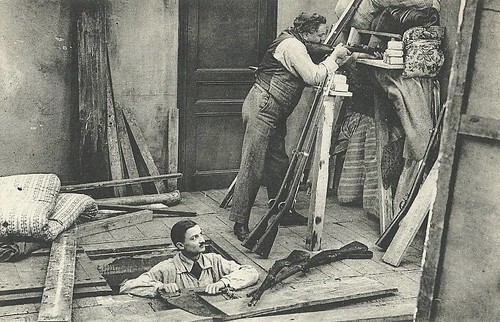
French postcard by M. Le Deley, Paris. Photo: Pathé Consortium Cinéma. Henry Krauss as Jean Sarrias, revolting against society, in L'empereur des pauvres / The Emperor of the Poor (René Leprince, 1921).
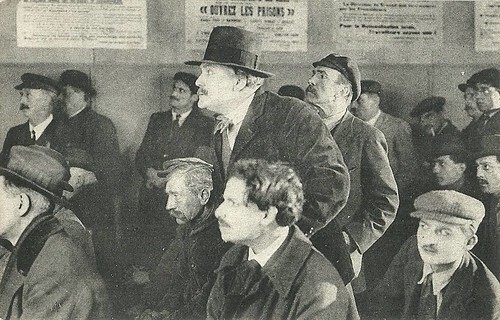
French postcard by M. Le Deley, Paris. Photo: Pathé Consortium Cinéma. Henry Krauss in L'empereur des pauvres / The Emperor of the Poor (René Leprince, 1922).
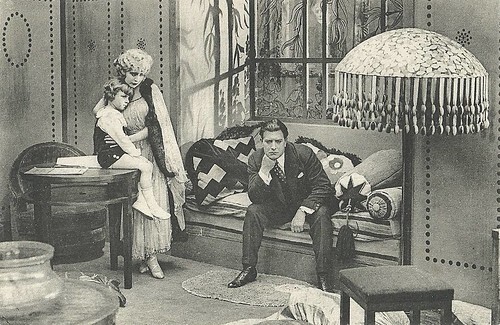
French postcard by M. Le Deley, Paris. Photo: Pathé Consortium Cinéma. Publicity still for L'empereur des pauvres / The Emperor of the Poor (René Leprince, 1921). Gina Relly as Sylvette, and Léon Mathot as Marc Anavan.
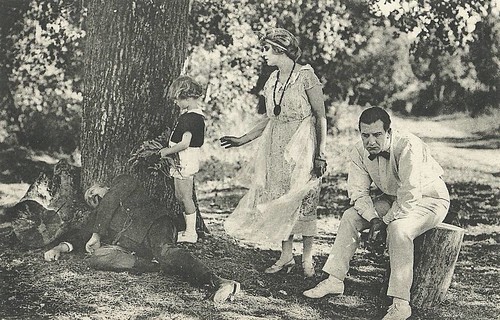
French postcard by M. Le Deley, Paris. Photo: Pathé Consortium Cinéma. Gina Relly as Sylvette and Léon Mathot as Marc Anavan in L'empereur des pauvres / The Emperor of the Poor (René Leprince, 1921).
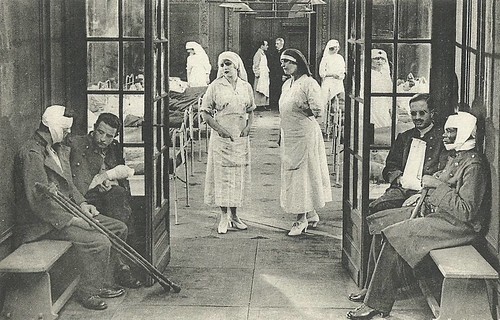
French postcard by M. Le Deley, Paris. Photo: Pathé Consortium Cinéma. Publicity still for L'empereur des pauvres / The Emperor of the Poor (René Leprince, 1921). Gina Relly as Sylvette, working as a nurse during the First World War.
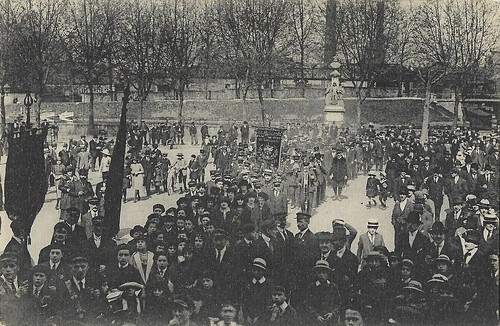
French postcard by M. Le Deley, Paris. Photo: Pathé Consortium Cinéma. Publicity still for L'empereur des pauvres / The Emperor of the Poor (René Leprince, 1921).
Sources: Guy Bellinger (IMDb), Ciné Ressources, Wikipedia and IMDb.

French postcard by M. Le Deley, Paris. Photo: Pathé Consortium Cinéma. Léon Mathot in L'empereur des pauvres / The Emperor of the poor (René Leprince, 1921).

French postcard by M. Le Deley, Paris. Photo: Pathé Consortium Cinéma. Gina Relly in L'empereur des pauvres / The Emperor of the poor (René Leprince, 1921).

French postcard by M. Le Deley, Paris. Photo: Pathé Consortium Cinéma. Andrée Pascal in L'empereur des pauvres / The Emperor of the poor (René Leprince, 1921).

French postcard by M. Le Deley, Paris. Photo: Pathé Consortium Cinéma. Henry Krauss in L'empereur des pauvres / The Emperor of the poor (René Leprince, 1921).

French postcard by M. Le Deley, Paris. Photo: Pathé Consortium Cinéma. Gina Relly in L'empereur des pauvres / The Emperor of the Poor (René Leprince, 1921).
A vagabond who wants to do good
French novelist and journalist Félicien Champsaur debuted with the roman à clef 'Dinah Samuel' (1882), said to present portraits of poet Arthur Rimbaud and actress Sarah Bernhardt. He went on to publish many novels, collections of articles, and other works, including 'Miss America' (1885), 'Entrée de clowns' (1886), 'Lulu' (1888), and 'Poupée Japonaise' (1912). He wrote 'L'empereur des pauvres' in 1920.
Based on Champsaur's novel, director René Leprince created the silent film serial, L'empereur des pauvres / The Emperor of the poor (René Leprince, 1921)..
The film serial tells the epic story of a rich and spoiled young man, Marc Anavan, played by Léon Mathot . Marc leads a profligate life, but when he understands his fortune is about to evaporate, he decides to change his life.
Marc becomes a vagabond and wants to do good around him. The task is not easy, but his faith in his mission and the love of the pure Sylvette ( Gina Relly ) help him.
Marc becomes the peaceful spokesperson for the disinherited. He has to face revolution, anarchism and the Great War, before retaking his humanitarian mission. In the end, he overcomes all the hardships on his way.

French postcard by M. Le Deley, Paris. Photo: Pathé Consortium Cinéma. Publicity still for L'empereur des pauvres / The Emperor of the Poor (René Leprince, 1921) with Léon Mathot as Marc Anavan.

French postcard by M. Le Deley, Paris. Photo: Pathé Consortium Cinéma. Publicity still for L'empereur des pauvres / The Emperor of the Poor (René Leprince, 1921) with, probably downright, Léon Mathot as Marc Anavan.

French postcard by M. Le Deley, Paris. Photo: Pathé Consortium Cinéma. Publicity still for L'empereur des pauvres / The Emperor of the Poor (René Leprince, 1921) with left, Henry Krauss , as Jean Sarrias, revolting against society.

French postcard by M. Le Deley, Paris. Photo: Pathé Consortium Cinéma. Publicity still for L'empereur des pauvres / The Emperor of the Poor (René Leprince, 1921). In the foreground, Gina Relly as Sylvette. Standing in the back, Léon Mathot as Marc Anavan and Henry Krauss as Jean Sarrias.

French postcard by M. Le Deley, Paris. Photo: Pathé Consortium Cinéma. Publicity still for L'empereur des pauvres / The Emperor of the Poor (René Leprince, 1921). Probably Léon Mathot as Marc Anavan.

French postcard by M. Le Deley, Paris. Photo: Pathé Consortium Cinéma. Publicity still for L'empereur des pauvres / The Emperor of the Poor (René Leprince, 1921). Probably Léon Mathot as Marc Anavan.

French postcard by M. Le Deley, Paris. Photo: Pathé Consortium Cinéma. Publicity still for L'empereur des pauvres / The Emperor of the Poor (René Leprince, 1921) with, at left, Léon Mathot as Marc Anavan, in the middle, Gina Relly as Sylvette, and right, Henry Krauss as her uncle Jean Sarrias.

French postcard by M. Le Deley, Paris. Photo: Pathé Consortium Cinéma. Gina Relly in L'empereur des pauvres / The Emperor of the Poor (1921).

French postcard by M. Le Deley, Paris. Photo: Pathé Consortium Cinéma. Gina Relly as Sylvette and Léon Mathot as Marc Anavan in L'empereur des pauvres / The Emperor of the Poor (René Leprince, 1921).

French postcard by M. Le Deley, Paris. Photo: Pathé Consortium Cinéma. Léon Mathot as Marc Anavan, Gina Relly as Sylvette, and right, Henry Krauss , as her uncle Jean Sarrias in L'empereur des pauvres / The Emperor of the Poor (René Leprince, 1921). Left of Mathot is Andrée Pascal as Clémence Sarrias.

French postcard by M. Le Deley, Paris. Photo: Pathé Consortium Cinéma. Gina Relly and Léon Mathot in L'empereur des pauvres / The Emperor of the Poor (1921).
One of the most successful French serials
L'empereur des pauvres / The Emperor of the Poor (René Leprince, 1921) was produced in six episodes: 1. Le Pauvre (The Poor); 2. Les Millions (The Millions); 3. Les Flambeaux (The Torches); 4. Les Crassiers (The Slag); 5. L'orage (The Storm) and 6. Floreal.
On demand of exhibitors, these six episodes were re-edited into twelve parts of 900 metres each, which were shown over six weeks in France. The Pathé production was one of the most successful French serials of the period. In the Netherlands, the 12 parts were shown in three or two weeks.
Besides Léon Mathot and Gina Relly in the lead roles, the cast of L'empereur des pauvres included several well-known actors of the French silent cinema.
Henry Krauss played Jean Sarrias, the uncle of Silvette; Gilbert Dalleu was Cyprien Cadal, the mayor of Saint Saturnin du Var; Andrée Pascal appeared as Clémence Sarrias; and Lily Damita was Riquette, credited as Lily Deslys. In supporting parts well well-known faces as Charles Lamy, André Luguet , Charles de Rochefort and Maurice Schutz were cast.
The elaborate camera work was done by Julien Ringel and Paul Gaillard. Director René Leprince was a well-known filmmaker of the silent era, who had worked several times with comedian Max Linder and went on to make Fanfan La Tulipe (1925) with Aimé Simon-Girard . In 1929, Leprince died at the age of 53, at the end of the silent era.

French postcard by M. Le Deley, Paris. Photo: Pathé Consortium Cinéma. Publicity still for L'empereur des pauvres / The Emperor of the poor (René Leprince, 1921). Standing in the middle, actor Léon Mathot .

French postcard by M. Le Deley, Paris. Photo: Pathé Consortium Cinéma. Publicity still for L'empereur des pauvres / The Emperor of the Poor (René Leprince, 1921). In the middle, Gina Relly as Sylvette, and right, Henry Krauss as her uncle Jean Sarrias, revolting against society. Left could be Andrée Pascal as Clémence Sarrias.

French postcard by M. Le Deley, Paris. Photo: Pathé Consortium Cinéma. Publicity still for L'empereur des pauvres / The Emperor of the Poor (René Leprince, 1921). The vagabond could be Léon Mathot .

French postcard by M. Le Deley, Paris. Photo: Pathé Consortium Cinéma. Publicity still for L'empereur des pauvres / The Emperor of the Poor (René Leprince, 1921). Left to right: Andrée Pascal as Clémence Sarrias, Gina Relly as Sylvette, Léon Mathot as Marc Anavan, and Henry Krauss as Jean Sarrias.

French postcard by M. Le Deley, Paris. Photo: Pathé Consortium Cinéma. Publicity still for L'empereur des pauvres / The Emperor of the poor (René Leprince, 1921). Gina Relly as Sylvette, Léon Mathot as Marc Anavan.

French postcard by M. Le Deley, Paris. Photo: Pathé Consortium Cinéma. Publicity still for L'empereur des pauvres / The Emperor of the poor (René Leprince, 1921). In bed: Gina Relly as Sylvette, left of her, Andrée Pascal as her sister Clémence.

French postcard by M. Le Deley, Paris. Photo: Pathé Consortium Cinéma. Publicity still for L'empereur des pauvres / The Emperor of the Poor (René Leprince, 1921). Standing front, Léon Mathot .

French postcard by M. Le Deley, Paris. Photo: Pathé Consortium Cinéma. Henry Krauss as Jean Sarrias, revolting against society, in L'empereur des pauvres / The Emperor of the Poor (René Leprince, 1921).

French postcard by M. Le Deley, Paris. Photo: Pathé Consortium Cinéma. Henry Krauss in L'empereur des pauvres / The Emperor of the Poor (René Leprince, 1922).

French postcard by M. Le Deley, Paris. Photo: Pathé Consortium Cinéma. Publicity still for L'empereur des pauvres / The Emperor of the Poor (René Leprince, 1921). Gina Relly as Sylvette, and Léon Mathot as Marc Anavan.

French postcard by M. Le Deley, Paris. Photo: Pathé Consortium Cinéma. Gina Relly as Sylvette and Léon Mathot as Marc Anavan in L'empereur des pauvres / The Emperor of the Poor (René Leprince, 1921).

French postcard by M. Le Deley, Paris. Photo: Pathé Consortium Cinéma. Publicity still for L'empereur des pauvres / The Emperor of the Poor (René Leprince, 1921). Gina Relly as Sylvette, working as a nurse during the First World War.

French postcard by M. Le Deley, Paris. Photo: Pathé Consortium Cinéma. Publicity still for L'empereur des pauvres / The Emperor of the Poor (René Leprince, 1921).
Sources: Guy Bellinger (IMDb), Ciné Ressources, Wikipedia and IMDb.
Published on August 16, 2025 22:00
August 15, 2025
Roland Young
Balding and highly distinguished Roland Young (1887-1953) was an American film and theatre actor of British origin. He was best known for the role of Cosmo Topper in the three Topper film comedies.
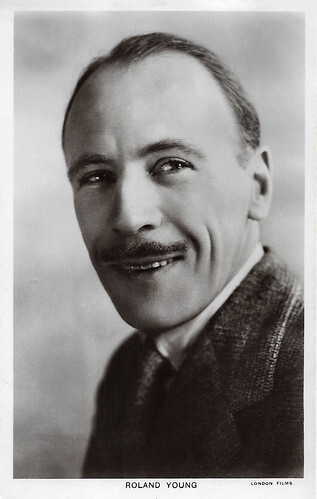
British postcard in the Picturegoer Series, London, no. 756. Photo: London Films.
Sherlock Holmes
Roland Young was born in 1887 in London, England. He was the son of an architect. Young enjoyed his school education at Sherborne College and later at London University. He decided to become an actor. Young acquired the necessary skills at the renowned Royal Academy of Dramatic Art (RADA).
In 1908, at the age of 21, Young appeared on stage in London for the first time in 'Find the Woman'. Four years later, he made his Broadway debut in 'Hindle Wakes' (1912). Until the mid-1910s, Young was still taking on engagements in England, which meant that he alternated between New York and London. Young became an American citizen in 1918 and then served briefly on the American side as a soldier in the First World War.
In 1921, he married his first wife, Marjorie Kummer, to whom he remained married until 1940. Young made his debut as a film actor as Doctor Watson in Sherlock Holmes (Albert Parker, 1922), alongside John Barrymore as Holmes and Gustav von Seyffertitz as Moriarty.
On Broadway, Young performed equally well in droll farces and classic drama. His standout credits included productions of 'Hedda Gabler' (1923) and 'The Last of Mrs. Cheyney' (1927). He signed a contract with Metro-Goldwyn-Mayer and made his talkie debut in the murder mystery The Unholy Night (Lionel Barrymore, 1929) with Ernest Torrence and Boris Karloff . He was loaned to Warner Bros. to appear in the drama Her Private Life (Alexander Korda, 1929), with Billie Dove and to Fox, winning critical approval for his comedic performance as Jeanette MacDonald 's husband in Don't Bet on Women (William K. Howard, 1931).
He was again paired with MacDonald in the romantic comedy Annabelle's Affairs (Alfred L. Werker, 1931). He appeared in Cecil B. DeMille 's Western The Squaw Man (1931), and played opposite Alfred Lunt and Lynn Fontanne in The Guardsman (Sidney Franklin, 1931). His final film under his MGM contract was Lovers Courageous (Robert Z. Leonard, 1932), opposite Robert Montgomery . He had a starring role in a risqué comedy for Fox entitled Pleasure Cruise (Frank Tuttle, 1933) alongside Genevieve Tobin .
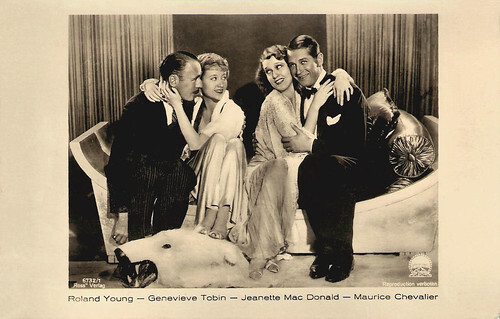
German postcard by Ross Verlag, no. 6732/1, 1931-1932. Photo: Paramount. Roland Young, Genevieve Tobin , Jeanette MacDonald and Maurice Chevalier in One Hour with You (Ernst Lubitsch, 1932).
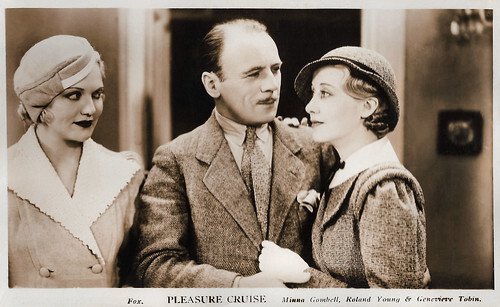
British postcard by Film Weekly in the Film Shots Series. Photo: Fox. Roland Young, Minna Gombell and Genevieve Tobin in Pleasure Cruise (Frank Tuttle, 1933).
Topper
Roland Young's roles were mostly limited to British characters, in which he embodied the stereotypical image of the aristocratic Englishman. He appeared with Jeanette MacDonald , Genevieve Tobin and Maurice Chevalier in One Hour With You (Ernst Lubitsch, 1932). Alexander Korda invited him to return to Britain to make his British film debut in Wedding Rehearsal (1932).
His best-known film was the screwball classic Topper (Norman Z. McLeod, 1937). Young played the bourgeois bank manager Cosmo Topper, whose orderly life is shaken up by the ghosts of his clients, Cary Grant and Constance Bennett . It was one of the most successful films of the year, and Young received an Oscar nomination for his role in the Best Supporting Actor category in 1938. He also starred in the sequels, Topper Takes a Trip (Norman Z. McLeod, 1938) and Topper Returns (Roy Del Ruth, 1941).
Young is also known for his role as the villain Uriah Heep in the Charles Dickens adaptation David Copperfield (George Cukor, 1935) and for the British fantasy film The Man Who Would Change the World (Lothar Mendes, 1936) based on a short story by H.G. Wells.
He often played eccentric characters, such as the inebriated Earl of Burnstead, who loses his valet Charles Laughton in a poker game, in Ruggles of Red Gap (Leo McCarey, 1935) or the rich uncle of Katharine Hepburn in The Philadelphia Story (George Cukor, 1940). He continued working steadily through the 1940s, playing small roles opposite some of Hollywood's leading actresses, such as Joan Crawford , Marlene Dietrich , Paulette Goddard and Greta Garbo in her final film, Two-Faced Woman (George Cukor, 1941). In 1945, he began his radio show and appeared in the film adaptation of Agatha Christie's classic whodunnit And Then There Were None (René Clair, 1945).
By the end of the decade, his film career had declined, and his final films, including The Great Lover (Alexander Hall, 1949), in which he played a murderer opposite Bob Hope , and Fred Astaire 's Let's Dance (Norman Z. MacLeod, 1950), were not successful. Roland Young found his second wife, Dorothy Patience May DuCroz, in 1948, with whom he spent the last years of his life. Roland Young had no children. In 1953, he died in New York of natural causes at the age of 65. He was honoured with two stars on the Hollywood Walk of Fame for his film and television work.
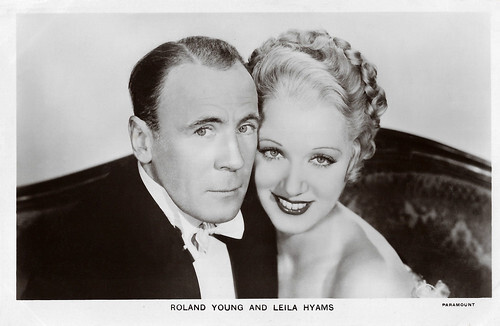
British postcard in the Film Partners Series, London, no. P 169. Photo: Paramount. Roland Young and Leila Hyams in Ruggles of Red Gap (Leo McCarey, 1935).
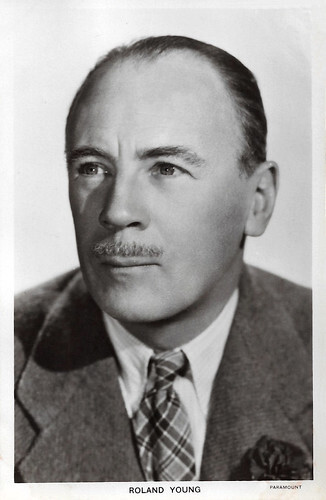
British postcard in the Picturegoer Series, London, no. 756a. Photo: Paramount.
Sources: (IMDb), Wikipedia (English and German) and.

British postcard in the Picturegoer Series, London, no. 756. Photo: London Films.
Sherlock Holmes
Roland Young was born in 1887 in London, England. He was the son of an architect. Young enjoyed his school education at Sherborne College and later at London University. He decided to become an actor. Young acquired the necessary skills at the renowned Royal Academy of Dramatic Art (RADA).
In 1908, at the age of 21, Young appeared on stage in London for the first time in 'Find the Woman'. Four years later, he made his Broadway debut in 'Hindle Wakes' (1912). Until the mid-1910s, Young was still taking on engagements in England, which meant that he alternated between New York and London. Young became an American citizen in 1918 and then served briefly on the American side as a soldier in the First World War.
In 1921, he married his first wife, Marjorie Kummer, to whom he remained married until 1940. Young made his debut as a film actor as Doctor Watson in Sherlock Holmes (Albert Parker, 1922), alongside John Barrymore as Holmes and Gustav von Seyffertitz as Moriarty.
On Broadway, Young performed equally well in droll farces and classic drama. His standout credits included productions of 'Hedda Gabler' (1923) and 'The Last of Mrs. Cheyney' (1927). He signed a contract with Metro-Goldwyn-Mayer and made his talkie debut in the murder mystery The Unholy Night (Lionel Barrymore, 1929) with Ernest Torrence and Boris Karloff . He was loaned to Warner Bros. to appear in the drama Her Private Life (Alexander Korda, 1929), with Billie Dove and to Fox, winning critical approval for his comedic performance as Jeanette MacDonald 's husband in Don't Bet on Women (William K. Howard, 1931).
He was again paired with MacDonald in the romantic comedy Annabelle's Affairs (Alfred L. Werker, 1931). He appeared in Cecil B. DeMille 's Western The Squaw Man (1931), and played opposite Alfred Lunt and Lynn Fontanne in The Guardsman (Sidney Franklin, 1931). His final film under his MGM contract was Lovers Courageous (Robert Z. Leonard, 1932), opposite Robert Montgomery . He had a starring role in a risqué comedy for Fox entitled Pleasure Cruise (Frank Tuttle, 1933) alongside Genevieve Tobin .

German postcard by Ross Verlag, no. 6732/1, 1931-1932. Photo: Paramount. Roland Young, Genevieve Tobin , Jeanette MacDonald and Maurice Chevalier in One Hour with You (Ernst Lubitsch, 1932).

British postcard by Film Weekly in the Film Shots Series. Photo: Fox. Roland Young, Minna Gombell and Genevieve Tobin in Pleasure Cruise (Frank Tuttle, 1933).
Topper
Roland Young's roles were mostly limited to British characters, in which he embodied the stereotypical image of the aristocratic Englishman. He appeared with Jeanette MacDonald , Genevieve Tobin and Maurice Chevalier in One Hour With You (Ernst Lubitsch, 1932). Alexander Korda invited him to return to Britain to make his British film debut in Wedding Rehearsal (1932).
His best-known film was the screwball classic Topper (Norman Z. McLeod, 1937). Young played the bourgeois bank manager Cosmo Topper, whose orderly life is shaken up by the ghosts of his clients, Cary Grant and Constance Bennett . It was one of the most successful films of the year, and Young received an Oscar nomination for his role in the Best Supporting Actor category in 1938. He also starred in the sequels, Topper Takes a Trip (Norman Z. McLeod, 1938) and Topper Returns (Roy Del Ruth, 1941).
Young is also known for his role as the villain Uriah Heep in the Charles Dickens adaptation David Copperfield (George Cukor, 1935) and for the British fantasy film The Man Who Would Change the World (Lothar Mendes, 1936) based on a short story by H.G. Wells.
He often played eccentric characters, such as the inebriated Earl of Burnstead, who loses his valet Charles Laughton in a poker game, in Ruggles of Red Gap (Leo McCarey, 1935) or the rich uncle of Katharine Hepburn in The Philadelphia Story (George Cukor, 1940). He continued working steadily through the 1940s, playing small roles opposite some of Hollywood's leading actresses, such as Joan Crawford , Marlene Dietrich , Paulette Goddard and Greta Garbo in her final film, Two-Faced Woman (George Cukor, 1941). In 1945, he began his radio show and appeared in the film adaptation of Agatha Christie's classic whodunnit And Then There Were None (René Clair, 1945).
By the end of the decade, his film career had declined, and his final films, including The Great Lover (Alexander Hall, 1949), in which he played a murderer opposite Bob Hope , and Fred Astaire 's Let's Dance (Norman Z. MacLeod, 1950), were not successful. Roland Young found his second wife, Dorothy Patience May DuCroz, in 1948, with whom he spent the last years of his life. Roland Young had no children. In 1953, he died in New York of natural causes at the age of 65. He was honoured with two stars on the Hollywood Walk of Fame for his film and television work.

British postcard in the Film Partners Series, London, no. P 169. Photo: Paramount. Roland Young and Leila Hyams in Ruggles of Red Gap (Leo McCarey, 1935).

British postcard in the Picturegoer Series, London, no. 756a. Photo: Paramount.
Sources: (IMDb), Wikipedia (English and German) and.
Published on August 15, 2025 22:00
August 14, 2025
15 New cards from G.D.I.
On the 15th of every month, EFSP presents 15 vintage postcards from the collection of the Geoffrey Donaldson Institute - GDI. Last month, we did the final post on a big blue album from the estate of Dutch film historians Tjitte de Vries and Ati Mul. This album included mostly Dutch postcards from the 1920s to the 1950s. Today we have the first post on a smaller blue album from the same estate, but with mainly German postcards from the 1910s and 1920s. This post ends with two postcards from the French series Nos Artistes dans leur Loge.
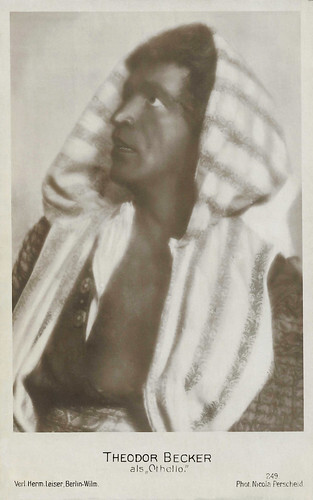
German postcard by Verlag Hermann Leiser, Berlin-Wilm., no. 249. Photo: Nicola Perscheid. Theodor Becker as Othello.
Theodor Becker (1880-1952) was a German stage and silent screen actor. He was married to actress Maria Fein, later to actress Helma Seitz. His daughters Maria and Renate also became actresses.
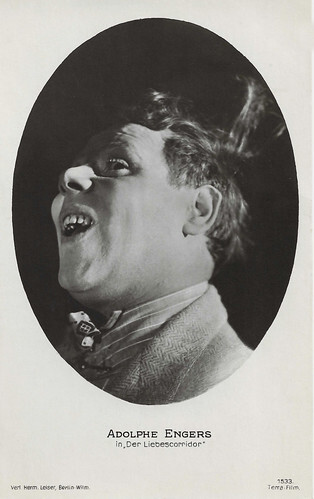
German postcard by Verlag Hermann Leiser, Berlin,-Wilm, no. 1533. Photo: Terra-Film. Adolphe Engers in Der Liebescorridor / The Love Passage (Urban Gad, Emil Albes, 1921).
Impressive Dutch actor Adolphe Engers (1884-1945) appeared in some 50 German and Dutch films in the 1920s and 1930s.
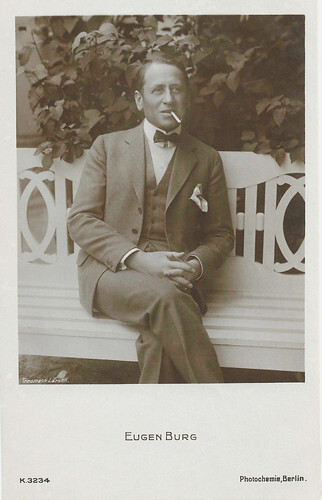
German postcard by Photochemie, Berlin, no. K. 3234. Photo: Treumann-Larsen.
Eugen Burg (1871-1944) was a German actor, writer and film director. From 1914 on, he appeared steadily in silent films. In the early 1930s, he appeared with his son-in-law, Hans Albers, in several popular action films.
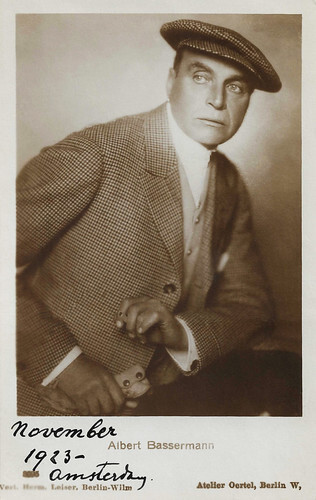
German postcard by Hermann Leiser, Berlin-Wilm., no. 3095. Photo: Atelier Oertel, Berlin W.
Albert Bassermann (1867-1952) was one of the first great German stage actors who worked for the cinema. In 1933 he fled the Nazi regime and became an Oscar nominated stage actor in Hollywood.
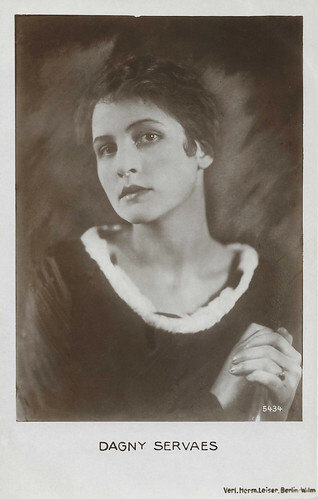
German postcard by Verlag Hermann Leiser, Berlin-Wilm., no. 5434.
Dagny Servaes (1894-1961) was a German-Austrian theatre and film actress. She reached her peak in Ernst Lubitsch's Das Weib des Pharao / The Pharao's Wife (1921).
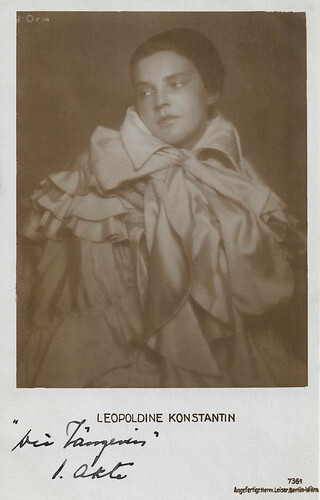
German postcard by Hermann Leiser, Berlin-Wilm., no. 7361. Leopoldine Konstantin in Die Tänzerin / The Dancer (Georg Jacoby, 1915).
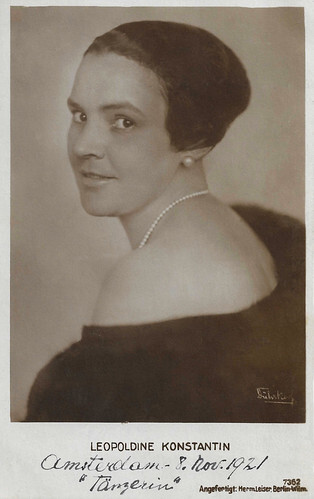
German postcard by Hermann Leiser, Berlin-Wilm., no. 7362. Photo: Dührkoop. Leopoldine Konstantin in Die Tänzerin / The Dancer (Georg Jacoby, 1915).
Leopoldine Konstantin (1886-1965) was a famous Austrian theatre and film character actress who worked for years with director Max Reinhardt. She played Claude Rains' dominant mother in Alfred Hitchcock’s classic Notorious (1946). It was her sole Hollywood role.
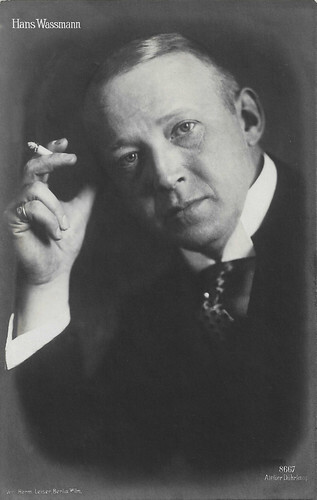
German postcard by Verlag Hermann Leiser, Berlin-Wilm., no. 8667. Photo: Dührkoop.
Hans Wassmann (1873-1932) was a German film actor. Between 1914 and his death in 1932, Wassmann played in 50 German films, mostly in supporting parts.
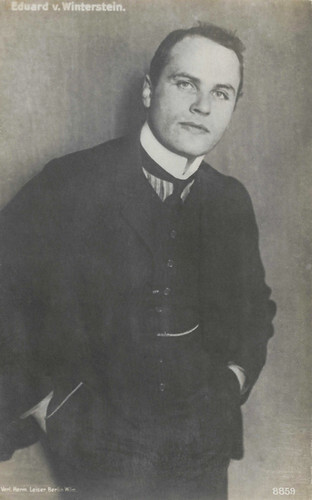
German postcard by Verlag Hermann Leiser, Berlin-Wilm., no. 8859.
Eduard von Winterstein (1871-1961) was an Austrian-born film and theatre actor. His German film career spanned from the 1910s to the late 1950s, from the Wilhelminian cinema to the cinema of the GDR.
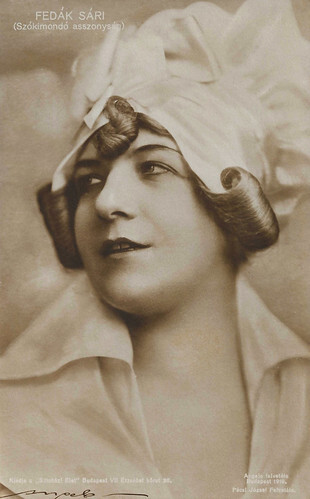
Hungarian postcard by Jozsef Pécsi for 'Shinhàzi Elet', Budapest. Photo: Angelo, Budapest, 1919. Sari Fedák in 'Szókimondó asszonysán' (Madame Sans-Gêne) by Victorien Sardou and Emile Moreau.
Hungarian actress and singer Sári Fedák (1879-1955) was one of the most famous prima donnas of her time. The temperamental operetta and film star was mixed up in several scandals.
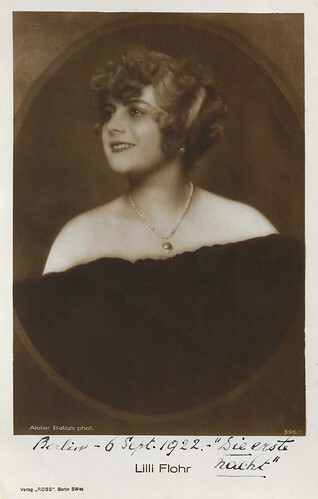
German postcard by Verlag Ross, Berlin, no. 395/1, 1922. Photo: Atelier Balazs, Berlin.
Austrian film star Lilly Flohr (1893-1978) was a busy actress, soubrette, cabaret artist and chanson singer on stage. From 1918 on, she starred in 25 silent films.
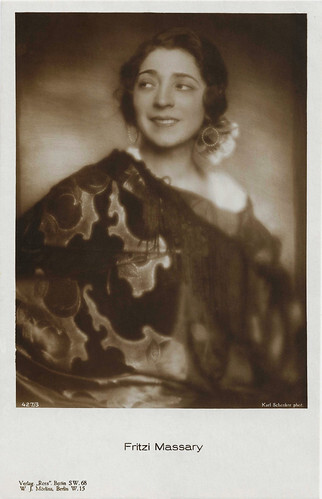
German postcard by Ross Verlag / W.J. Morlins, Berlin, no. 427/3, 1919-1924. Photo: Karl Schenker.
Austrian-American soprano singer and actress Fritzi Massary (1882-1969) was one of the greatest 20th-century operetta divas. She was a superstar in Berlin and Vienna in the Weimar era, but after the rise of the Nazis, Massary was forced to flee Germany. In London, she appeared in an operetta that Noel Coward wrote for her. The popular singer also starred in several early German ‘sound pictures’ and other silent films.
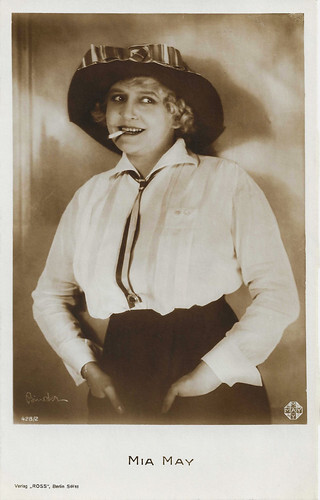
German postcard by Verlag Ross, Berlin, no. 428/2, 1919-1924. Photo: Binder / May Film.
Mia May (1884-1980) was one of the first divas of the German cinema. She starred in many films by her husband, producer, writer and director Joe May.
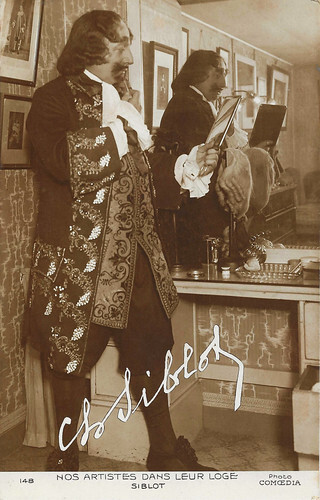
French postcard in the series Nos Artistes dans leur Loge, no. 148. Photo: Comoedia.
Charles-Louis-Adrien Siblot was born in 1871 in Vincennes, Val-de-Marne, France. Siblot was an actor, known for Molière, sa vie, son oeuvre (1922) and Le chasseur de chez Maxim's (1933). Charles Siblot died in 1943 in Paris, France.
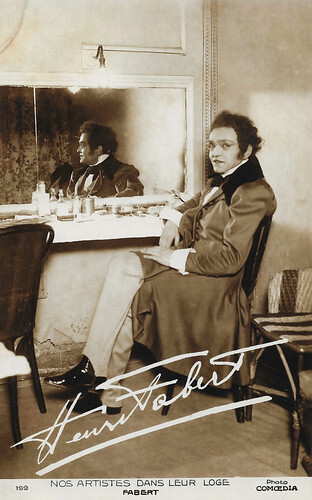
French postcard in the series Nos Artistes dans leur Loge, no. 199. Photo: Comoedia. Henri Fabert as Franz Schubert in 'Chanson d'amour', the French adaptation of the operetta 'Das Dreimäderlhaus' (Heinrich Berté, 1912), first performed in Paris in 1921.
Henri Fabert was born in 1879. He was an actor and director, known for such films as Blanc comme neige (1931), La merveilleuse tragédie de Lourdes (1933) and La chanson du souvenir (1937). Fabert died in 1941.
All postcards are part of the collection of the Geoffrey Donaldson Institute (GDI). This post will be continued on 15 September 2025.

German postcard by Verlag Hermann Leiser, Berlin-Wilm., no. 249. Photo: Nicola Perscheid. Theodor Becker as Othello.
Theodor Becker (1880-1952) was a German stage and silent screen actor. He was married to actress Maria Fein, later to actress Helma Seitz. His daughters Maria and Renate also became actresses.

German postcard by Verlag Hermann Leiser, Berlin,-Wilm, no. 1533. Photo: Terra-Film. Adolphe Engers in Der Liebescorridor / The Love Passage (Urban Gad, Emil Albes, 1921).
Impressive Dutch actor Adolphe Engers (1884-1945) appeared in some 50 German and Dutch films in the 1920s and 1930s.

German postcard by Photochemie, Berlin, no. K. 3234. Photo: Treumann-Larsen.
Eugen Burg (1871-1944) was a German actor, writer and film director. From 1914 on, he appeared steadily in silent films. In the early 1930s, he appeared with his son-in-law, Hans Albers, in several popular action films.

German postcard by Hermann Leiser, Berlin-Wilm., no. 3095. Photo: Atelier Oertel, Berlin W.
Albert Bassermann (1867-1952) was one of the first great German stage actors who worked for the cinema. In 1933 he fled the Nazi regime and became an Oscar nominated stage actor in Hollywood.

German postcard by Verlag Hermann Leiser, Berlin-Wilm., no. 5434.
Dagny Servaes (1894-1961) was a German-Austrian theatre and film actress. She reached her peak in Ernst Lubitsch's Das Weib des Pharao / The Pharao's Wife (1921).

German postcard by Hermann Leiser, Berlin-Wilm., no. 7361. Leopoldine Konstantin in Die Tänzerin / The Dancer (Georg Jacoby, 1915).

German postcard by Hermann Leiser, Berlin-Wilm., no. 7362. Photo: Dührkoop. Leopoldine Konstantin in Die Tänzerin / The Dancer (Georg Jacoby, 1915).
Leopoldine Konstantin (1886-1965) was a famous Austrian theatre and film character actress who worked for years with director Max Reinhardt. She played Claude Rains' dominant mother in Alfred Hitchcock’s classic Notorious (1946). It was her sole Hollywood role.

German postcard by Verlag Hermann Leiser, Berlin-Wilm., no. 8667. Photo: Dührkoop.
Hans Wassmann (1873-1932) was a German film actor. Between 1914 and his death in 1932, Wassmann played in 50 German films, mostly in supporting parts.

German postcard by Verlag Hermann Leiser, Berlin-Wilm., no. 8859.
Eduard von Winterstein (1871-1961) was an Austrian-born film and theatre actor. His German film career spanned from the 1910s to the late 1950s, from the Wilhelminian cinema to the cinema of the GDR.

Hungarian postcard by Jozsef Pécsi for 'Shinhàzi Elet', Budapest. Photo: Angelo, Budapest, 1919. Sari Fedák in 'Szókimondó asszonysán' (Madame Sans-Gêne) by Victorien Sardou and Emile Moreau.
Hungarian actress and singer Sári Fedák (1879-1955) was one of the most famous prima donnas of her time. The temperamental operetta and film star was mixed up in several scandals.

German postcard by Verlag Ross, Berlin, no. 395/1, 1922. Photo: Atelier Balazs, Berlin.
Austrian film star Lilly Flohr (1893-1978) was a busy actress, soubrette, cabaret artist and chanson singer on stage. From 1918 on, she starred in 25 silent films.

German postcard by Ross Verlag / W.J. Morlins, Berlin, no. 427/3, 1919-1924. Photo: Karl Schenker.
Austrian-American soprano singer and actress Fritzi Massary (1882-1969) was one of the greatest 20th-century operetta divas. She was a superstar in Berlin and Vienna in the Weimar era, but after the rise of the Nazis, Massary was forced to flee Germany. In London, she appeared in an operetta that Noel Coward wrote for her. The popular singer also starred in several early German ‘sound pictures’ and other silent films.

German postcard by Verlag Ross, Berlin, no. 428/2, 1919-1924. Photo: Binder / May Film.
Mia May (1884-1980) was one of the first divas of the German cinema. She starred in many films by her husband, producer, writer and director Joe May.

French postcard in the series Nos Artistes dans leur Loge, no. 148. Photo: Comoedia.
Charles-Louis-Adrien Siblot was born in 1871 in Vincennes, Val-de-Marne, France. Siblot was an actor, known for Molière, sa vie, son oeuvre (1922) and Le chasseur de chez Maxim's (1933). Charles Siblot died in 1943 in Paris, France.

French postcard in the series Nos Artistes dans leur Loge, no. 199. Photo: Comoedia. Henri Fabert as Franz Schubert in 'Chanson d'amour', the French adaptation of the operetta 'Das Dreimäderlhaus' (Heinrich Berté, 1912), first performed in Paris in 1921.
Henri Fabert was born in 1879. He was an actor and director, known for such films as Blanc comme neige (1931), La merveilleuse tragédie de Lourdes (1933) and La chanson du souvenir (1937). Fabert died in 1941.
All postcards are part of the collection of the Geoffrey Donaldson Institute (GDI). This post will be continued on 15 September 2025.
Published on August 14, 2025 22:00
August 13, 2025
Women and Horses in Silent Film
In silent cinema, the combination of women, especially young women, with horses already started in the early 20th century. It occurred particularly in Germany between 1910 and 1914, when the first female film stars rose, such as Henny Porten and Fern Andra. These young actresses were portrayed on postcards caressing horses, often white horses. They thus expressed a chaste kind of love and care, that would have a long-lasting tradition in teenage culture, from novels like 'National Velvet' (1935) by Enid Bagnold - filmed in 1944 with a young Elizabeth Taylor in the lead - and children’s books to teenager magazines like Pony and Young Rider and TV series like The Adventures of Black Beauty (1972-1974), partly related to the often filmed novel 'Black Beauty' (1877) by Anna Sewell. For this post, Ivo Blom selected 20 postcards and wrote the text.
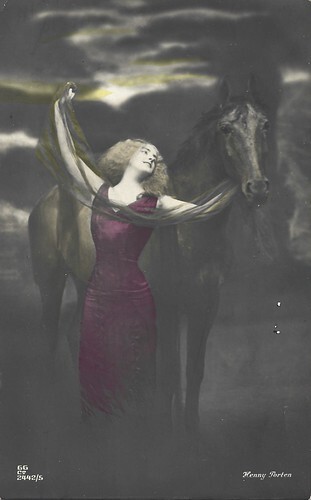
German postcard by G.G. Co. (Georg Gerlach Company, Berlin), no. 2442/5. Henny Porten .
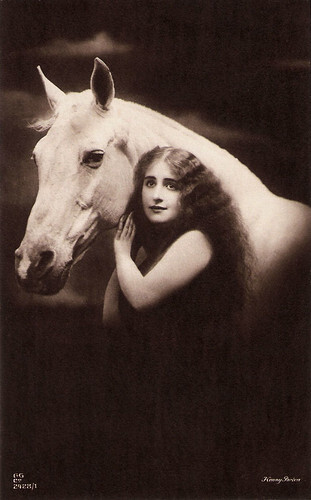
German postcard by G.G. Co. (Georg Gerlach Company, Berlin), no. 2428/11. Henny Porten .
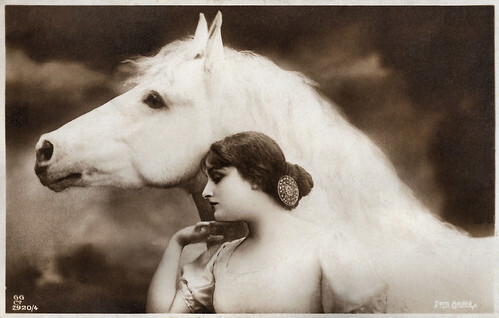
German postcard by Verlag Photochemie, Berlin / G.G. Co., no. 2920/4. Photo: Fern Andra Atelier. Fern Andra .
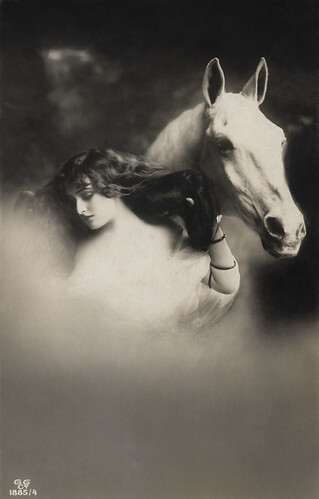
German postcard by Verlag Photochemie, Berlin / G.G. Co., no. 1885/4. Photo: Fern Andra Atelier. Fern Andra .
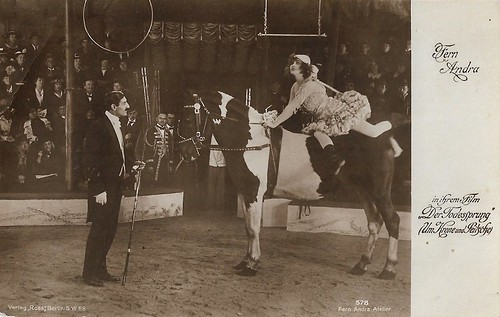
German postcard by Ross Verlag, no. 578. Photo: Fern Andra Atelier. Fern Andra in Der Todessprung / Um Krone und Peitsche / Crown and Whip (Georg Bluen, Fern Andra, 1919).
Wild pursuits on horseback
In early cinema, narrative connotations between women and horses were soon created. From the 1910s, women also became daredevils on horses, in the first place as amazons in circus acts.
In the Italian film L’amazzone mascherata / The Woman Who Dared (Baldassarre Negroni, 1914), Francesca Bertini played a masked amazon, who is keen to get stolen state documents back from two foreign spies. In La pantomima della morte / The Pantomime of Death (Mario Caserini, 1917), Leda Gys is a frivolous circus amazon who gets her comeuppance when she has driven a man to death: she is killed during her circus act.
In Chaplin’s film The Circus (Charles Chaplin, 1928), Merna Kennedy plays a young amazon and Charlie’s love interest. Sometimes, women even performed wild acrobatic acts with horses, like Fern Andra . She jumped down from a high pedestal with her horse, in Der Todessprung / Um Krone und Peitsche / Crown and Whip (Georg Bluen, Fern Andra, 1919). Wild pursuits would happen on horseback, such as Linda Albertini’s in I figli di Sansonia / The Children of Samson (Filippo Costamagna, 1920).
For aristocratic or well-to-do ladies in film plots, it was standard fare to ride a horse, just like they would have done in real life. Pauline Brunius ’ character rides horses in the Swedish society comedy Gyurkovicsarna / Lieutenant Tophat (John W. Brunius, 1920).
Likewise, Mae Murray uses horse riding as part of her new life as a super-rich woman, who, after her inheritance, has become The Merry Widow (Erich von Stroheim, 1925). Expressing control and power, women may drive a horse and cart themselves, like a tilbury, or, when too chic for this, men would drive the carts for them, as in the Italian film L’ombra / The Shadow (Mario Almirante, 1923).
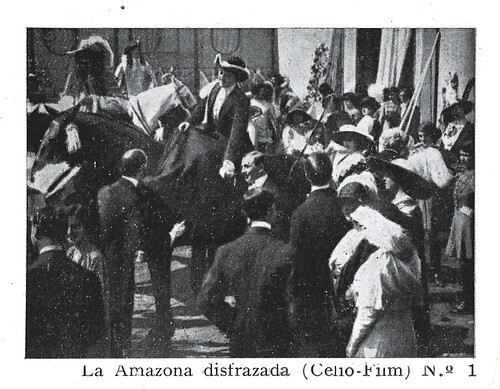
Spanish collector card by Reclam Film, Mallorca, no. 1 of 6. Photo: Celio Film. Francesca Bertini and Alberto Collo in L'amazzone mascherata / The Woman Who Dared (Baldassarre Negroni, 1914). The Spanish release title was La Amazona disfrazada.
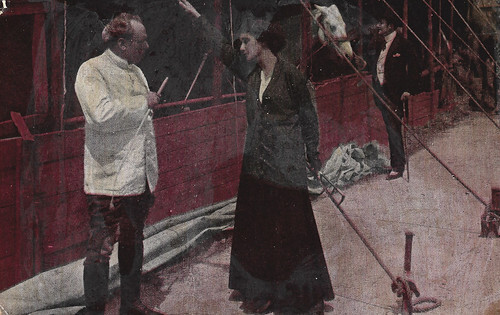
Spanish collector card by Edics. y Publics. de Arte L. Planas, Barcelona, no. 3. Leda Gys and Mario Bonnard (in the background) in La pantomima della morte / The Pantomime of Death (Mario Caserini, 1915). The Spanish release title was La pantomima de la muerte.
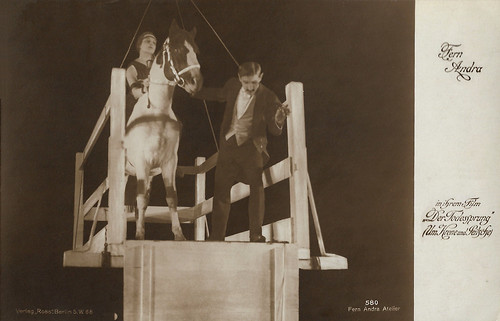
German postcard by Ross Verlag, no. 580. Photo: Fern Andra Atelier. Fern Andra in Der Todessprung / Um Krone und Peitsche / Crown and Whip (Georg Bluen, Fern Andra, 1919).
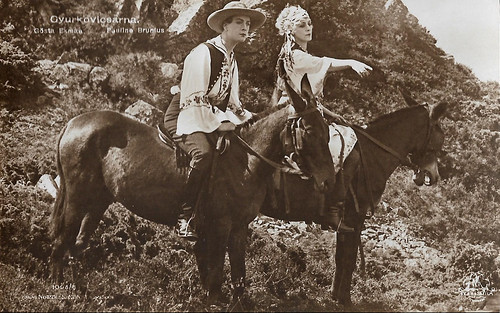
Swedish postcard by Förlag Nordisk Konst, Stockholm, no. 1096/6. Photo: Skandia Film. Gösta Ekman and Pauline Brunius in the comedy Gyurkovicsarna / Lieutenant Tophat (John W. Brunius, 1920).
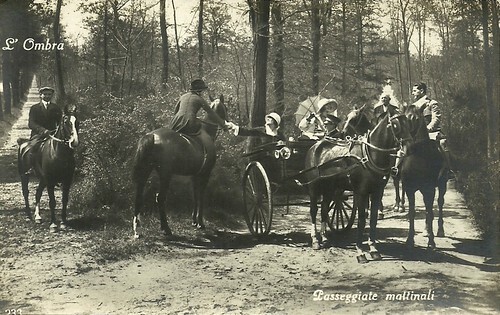
Italian postcard by Ed. Ballerini & Fratini, Firenze. Photo: Alba Film. Italia Almirante Manzini in L'ombra / The Shadow (Mario Almirante, 1923). Caption: Morning strolls.
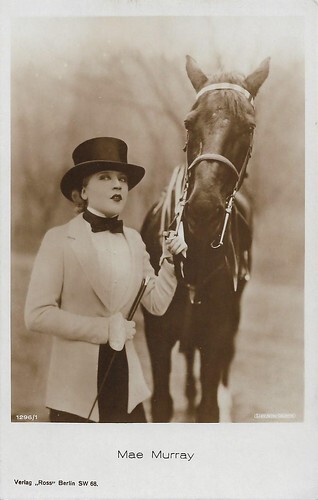
German postcard by Ross Verlag, Berlin, no. 1296/1, 1927-1928. Photo: Loew-Metro-Goldwyn. Mae Murray in The Merry Widow (Erich von Stroheim, 1925). The film was released in Europe from 1926 onward.
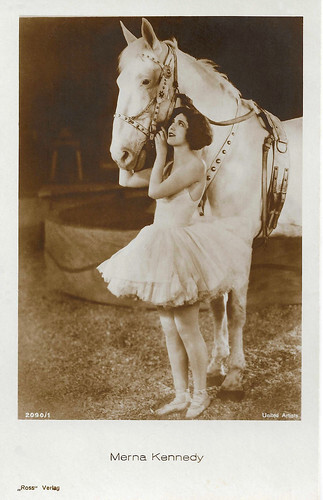
German postcard by Ross Verlag, no. 2090/1, 1928-1929. Photo: United Artists. Merna Kennedy in The Circus (Charles Chaplin, 1928).
Riding attire as an expression of modernity
Sometimes young women dressed as men, and thus, (sometimes wild) horse riding was part of their daily life. In the Dutch film Majoor Frans (Maurits Binger, 1916), Annie Bos played a girl raised as a boy by her father, a high-ranking military officer.
Riding attire was considered quite fashionable, and thus many female film stars, particularly in Germany in the 1920s, posed in riding jackets, bowler hats and whips, as an expression of modernity. Thus, we can see stars of Weimar cinema like Cilly Feindt , Elisabeth Pinajeff and Marcella Albani in riding gear.
Of course, a typical type is the wild cowgirl, connected to the Western, often breaking rules of strict morality and decency, and opposed to the stern settlers, the prostitutes in the brothels, or the well-dressed woman of the city. A good example is Vilma Banky ’s part in The Winning of Barbara Worth (Henry King, 1926). Right from the start of the film, she shows she can ride a wild horse and tame it, even if Ronald Colman comes to help when necessary.
Other examples are Mary Brian in The Virginian (Victor Fleming, 1929). Another recurring trope is the horse racing environment, such as Marion Nixon in Sporting Life (Maurice Tourneur, 1925), a film that was presented in Italy at the time as Donne e cavalli (Women and Horses). Nixon played the daughter of a horse trainer.
Yet, female jockeys also occur in silent cinema, e.g. in the American film The Whip (Maurice Tourneur, 1917), with Alma Hanlon as female jockey, and the Australian film Silk and Saddles (John Wells, 1921), retitled Queen of the Turf in the US, and starring Agnes Vernon as a daring sportswoman.
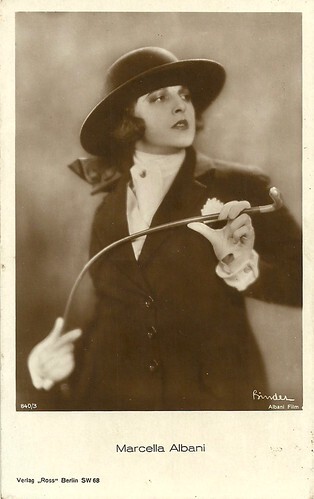
German postcard by Verlag Ross, Berlin, no. 840/3, 1925-1926. Photo: Alex Binder / Albani-Film. Marcella Albani .
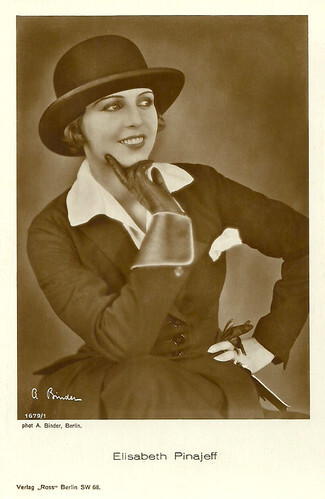
German postcard by Verlag Ross, Berlin, no. 1679/1, 1927-1928. Photo: Alex Binder, Berlin. Elisabeth Pinajeff .
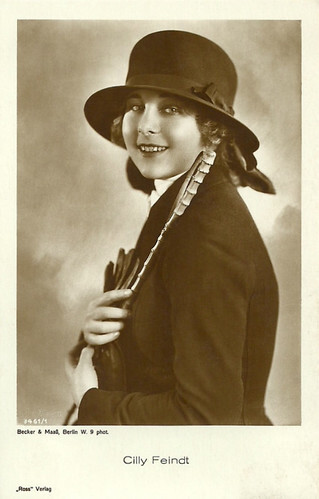
German postcard by Ross Verlag, no. 1961/1, 1927-1928. Photo: Becker & Maass, Berlin. Cilly Feindt.
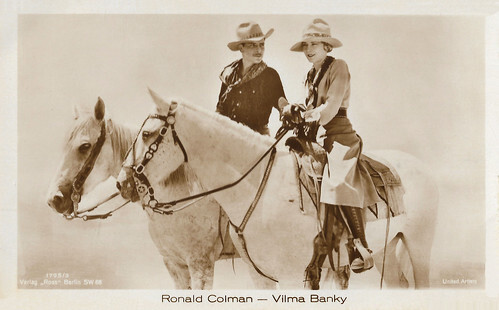
German postcard by Verlag Ross, Berlin, no. 1795/3, 1927-1928. Photo: United Artists. Ronald Colman and Vilma Banky in The Winning of Barbara Worth (Henry King, 1926).
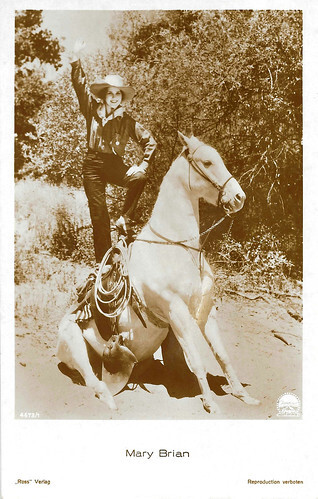
German postcard by Ross Verlag, no. 4673/1, 1929-1930. Photo: Paramount. Mary Brian in The Virginian (Victor Fleming, 1929).
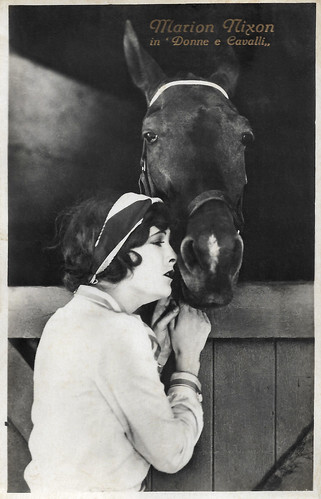
Italian postcard by G.B. Falci Editore, Milano, no. 506. Marion Nixon in Sporting Life (Maurice Tourneur, 1925).
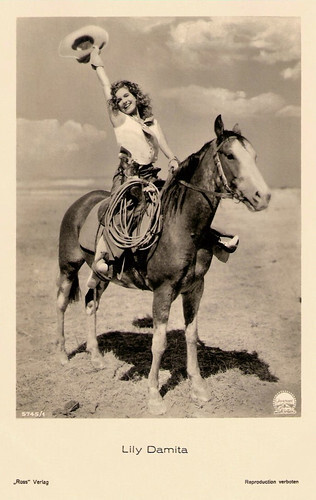
German Postcard by Ross Verlag, no. 5745/1, 1930-1931. Photo: Paramount. Lily Damita in Fighting Caravans (Otto Brower, David Burton, 1931).
Text and postcards: Ivo Blom. For more postcards, check out our Flickr album 'Women and horses' or our post 'The White Horse'.

German postcard by G.G. Co. (Georg Gerlach Company, Berlin), no. 2442/5. Henny Porten .

German postcard by G.G. Co. (Georg Gerlach Company, Berlin), no. 2428/11. Henny Porten .

German postcard by Verlag Photochemie, Berlin / G.G. Co., no. 2920/4. Photo: Fern Andra Atelier. Fern Andra .

German postcard by Verlag Photochemie, Berlin / G.G. Co., no. 1885/4. Photo: Fern Andra Atelier. Fern Andra .

German postcard by Ross Verlag, no. 578. Photo: Fern Andra Atelier. Fern Andra in Der Todessprung / Um Krone und Peitsche / Crown and Whip (Georg Bluen, Fern Andra, 1919).
Wild pursuits on horseback
In early cinema, narrative connotations between women and horses were soon created. From the 1910s, women also became daredevils on horses, in the first place as amazons in circus acts.
In the Italian film L’amazzone mascherata / The Woman Who Dared (Baldassarre Negroni, 1914), Francesca Bertini played a masked amazon, who is keen to get stolen state documents back from two foreign spies. In La pantomima della morte / The Pantomime of Death (Mario Caserini, 1917), Leda Gys is a frivolous circus amazon who gets her comeuppance when she has driven a man to death: she is killed during her circus act.
In Chaplin’s film The Circus (Charles Chaplin, 1928), Merna Kennedy plays a young amazon and Charlie’s love interest. Sometimes, women even performed wild acrobatic acts with horses, like Fern Andra . She jumped down from a high pedestal with her horse, in Der Todessprung / Um Krone und Peitsche / Crown and Whip (Georg Bluen, Fern Andra, 1919). Wild pursuits would happen on horseback, such as Linda Albertini’s in I figli di Sansonia / The Children of Samson (Filippo Costamagna, 1920).
For aristocratic or well-to-do ladies in film plots, it was standard fare to ride a horse, just like they would have done in real life. Pauline Brunius ’ character rides horses in the Swedish society comedy Gyurkovicsarna / Lieutenant Tophat (John W. Brunius, 1920).
Likewise, Mae Murray uses horse riding as part of her new life as a super-rich woman, who, after her inheritance, has become The Merry Widow (Erich von Stroheim, 1925). Expressing control and power, women may drive a horse and cart themselves, like a tilbury, or, when too chic for this, men would drive the carts for them, as in the Italian film L’ombra / The Shadow (Mario Almirante, 1923).

Spanish collector card by Reclam Film, Mallorca, no. 1 of 6. Photo: Celio Film. Francesca Bertini and Alberto Collo in L'amazzone mascherata / The Woman Who Dared (Baldassarre Negroni, 1914). The Spanish release title was La Amazona disfrazada.

Spanish collector card by Edics. y Publics. de Arte L. Planas, Barcelona, no. 3. Leda Gys and Mario Bonnard (in the background) in La pantomima della morte / The Pantomime of Death (Mario Caserini, 1915). The Spanish release title was La pantomima de la muerte.

German postcard by Ross Verlag, no. 580. Photo: Fern Andra Atelier. Fern Andra in Der Todessprung / Um Krone und Peitsche / Crown and Whip (Georg Bluen, Fern Andra, 1919).

Swedish postcard by Förlag Nordisk Konst, Stockholm, no. 1096/6. Photo: Skandia Film. Gösta Ekman and Pauline Brunius in the comedy Gyurkovicsarna / Lieutenant Tophat (John W. Brunius, 1920).

Italian postcard by Ed. Ballerini & Fratini, Firenze. Photo: Alba Film. Italia Almirante Manzini in L'ombra / The Shadow (Mario Almirante, 1923). Caption: Morning strolls.

German postcard by Ross Verlag, Berlin, no. 1296/1, 1927-1928. Photo: Loew-Metro-Goldwyn. Mae Murray in The Merry Widow (Erich von Stroheim, 1925). The film was released in Europe from 1926 onward.

German postcard by Ross Verlag, no. 2090/1, 1928-1929. Photo: United Artists. Merna Kennedy in The Circus (Charles Chaplin, 1928).
Riding attire as an expression of modernity
Sometimes young women dressed as men, and thus, (sometimes wild) horse riding was part of their daily life. In the Dutch film Majoor Frans (Maurits Binger, 1916), Annie Bos played a girl raised as a boy by her father, a high-ranking military officer.
Riding attire was considered quite fashionable, and thus many female film stars, particularly in Germany in the 1920s, posed in riding jackets, bowler hats and whips, as an expression of modernity. Thus, we can see stars of Weimar cinema like Cilly Feindt , Elisabeth Pinajeff and Marcella Albani in riding gear.
Of course, a typical type is the wild cowgirl, connected to the Western, often breaking rules of strict morality and decency, and opposed to the stern settlers, the prostitutes in the brothels, or the well-dressed woman of the city. A good example is Vilma Banky ’s part in The Winning of Barbara Worth (Henry King, 1926). Right from the start of the film, she shows she can ride a wild horse and tame it, even if Ronald Colman comes to help when necessary.
Other examples are Mary Brian in The Virginian (Victor Fleming, 1929). Another recurring trope is the horse racing environment, such as Marion Nixon in Sporting Life (Maurice Tourneur, 1925), a film that was presented in Italy at the time as Donne e cavalli (Women and Horses). Nixon played the daughter of a horse trainer.
Yet, female jockeys also occur in silent cinema, e.g. in the American film The Whip (Maurice Tourneur, 1917), with Alma Hanlon as female jockey, and the Australian film Silk and Saddles (John Wells, 1921), retitled Queen of the Turf in the US, and starring Agnes Vernon as a daring sportswoman.

German postcard by Verlag Ross, Berlin, no. 840/3, 1925-1926. Photo: Alex Binder / Albani-Film. Marcella Albani .

German postcard by Verlag Ross, Berlin, no. 1679/1, 1927-1928. Photo: Alex Binder, Berlin. Elisabeth Pinajeff .

German postcard by Ross Verlag, no. 1961/1, 1927-1928. Photo: Becker & Maass, Berlin. Cilly Feindt.

German postcard by Verlag Ross, Berlin, no. 1795/3, 1927-1928. Photo: United Artists. Ronald Colman and Vilma Banky in The Winning of Barbara Worth (Henry King, 1926).

German postcard by Ross Verlag, no. 4673/1, 1929-1930. Photo: Paramount. Mary Brian in The Virginian (Victor Fleming, 1929).

Italian postcard by G.B. Falci Editore, Milano, no. 506. Marion Nixon in Sporting Life (Maurice Tourneur, 1925).

German Postcard by Ross Verlag, no. 5745/1, 1930-1931. Photo: Paramount. Lily Damita in Fighting Caravans (Otto Brower, David Burton, 1931).
Text and postcards: Ivo Blom. For more postcards, check out our Flickr album 'Women and horses' or our post 'The White Horse'.
Published on August 13, 2025 22:00
August 12, 2025
Cameron Mitchell
Cameron Mitchell(1918-1994) was an American stage and screen actor who appeared in many Horror films, thrillers, and Westerns. During the 1960s, he appeared in several Italian films, but he is best remembered for the TV series The High Chaparral (1967-1971). As the happy-go-lucky, hard-drinking Uncle Buck Cannon, he stole the show.
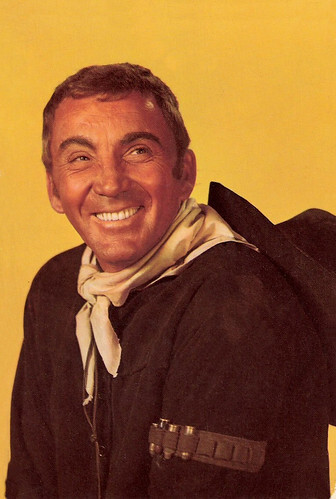
Dutch postcard. Cameron Mitchell as Buck Cannon in The High Chapparal (1967-1971).
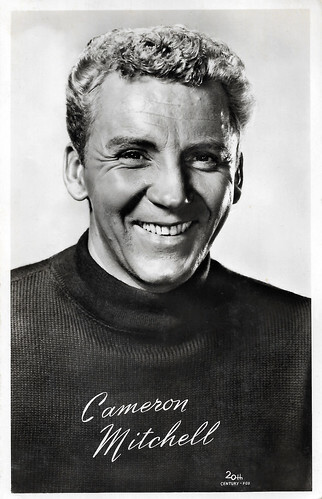
Dutch postcard by Uitg. Takken, Utrecht, no. 1715. Photo: 20th Century Fox.
Discovered by Elia Kazan
Cameron Mitchell was born Cameron McDowell Mitzell in 1918 in Dallastown, Pennsylvania. His parents, Charles and Kathryn Mitzell, were both ministers of the Reformed Lutheran Church, and Cameron was the fourth of their seven children. In 1921, the family moved to Chicora, Pennsylvania, where his father was accepted as pastor of the St. John's Reformed Church, and he grew up in Shrewsbury, Pennsylvania. Cameron graduated from Greenwood High School in Millerstown, PA, in 1936.
His father wanted him to be a minister, but 'Cam' became an actor instead. In New York City, he attended the Theatre School of Dramatic Arts. In 1939, Mitchell made his Broadway debut in a secondary role in 'Jeremiah'. During this time, Mitchell became a piccolo at NBC Radio City, leading to a secondary role in a production of William Shakespeare 's 'The Taming of the Shrew' (1940), with Alfred Lunt and Lynn Fontanne's National Theatre Company. He changed his name from Mitzell to Mitchell because Fontanne realised his real name sounded "a little bit too much like the Hun". In 1940, he also appeared in an experimental television broadcast, The Passing of the Third Floor Back. Mitchell appeared again on Broadway in 'The Trojan Women' in 1941.
During World War II, he served in the US Army Air Forces as a bombardier. In 1945, Mitchell signed a contract with MGM and made his film debut in What Next, Corporal Hargrove? (Richard Thorpe, 1945) starring Robert Walker . He continued with stage as well as film work. He had another small part in the War film They Were Expendable (John Ford, 1945), starring Robert Montgomery and John Wayne , but soon followed bigger roles. He appeared in the drama Cass Timberlane (George Sidney, 1947) starring Spencer Tracy , and the War film Homecoming (Mervyn LeRoy, 1948) with Clark Gable and Lana Turner .
He had his break when Elia Kazan chose him to play Happy Loman, the younger son, in Arthur Miller's stage play 'Death of a Salesman' on Broadway alongside Lee J. Cobb. His performance earned him a 1949 Theatre World Award. Mitchell also played the role in the film version, Death of a Salesman (Laslo Benedek, 1951) starring Fredric March as Willy Loman. It led to a contract with 20th Century-Fox, where he had a prolific career in films such as Les Misérables (Lewis Milestone, 1952). With Marilyn Monroe , Betty Grable and Lauren Bacall , he appeared in the hit comedy How to Marry a Millionaire (Jean Negulesco, 1953). Reportedly, he introduced Monroe to Elia Kazan and Arthur Miller. He then appeared with Gary Cooper , Susan Hayward and Richard Widmark in the Western Garden of Evil (Henry Hathaway, 1954), followed by a supporting role in Samuel Fuller's Cold War drama Hell and High Water (1954).
He then played Joseph Bonaparte opposite Marlon Brando as Napoleon in Désirée (Henry Koster, 1954). He appeared with Clark Gable and Jane Russell in the Western The Tall Men (Raoul Walsh, 1955) and had a role in the film version of the musical Carousel (Henry King, 1956). Mitchell was loaned back to MGM to star with Doris Day in the comedy musical Love Me or Leave Me (Charles Vidor, 1955), as the pianist only too willing to pick up the singer Ruth Etting after she has been knocked down for the nth time by her husband. Mitchell starred alongside Joanne Woodward and Sheree North in the drama No Down Payment (Martin Ritt, 1957).
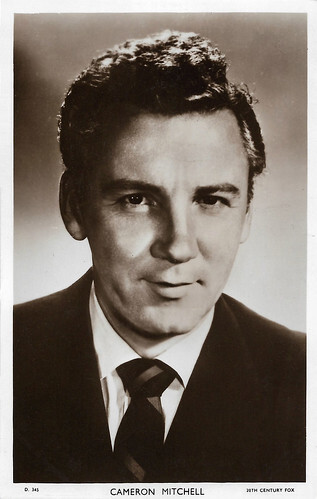
British postcard in the Picturegoer Series, London, no. D. 345. Photo: 20th Century Fox.
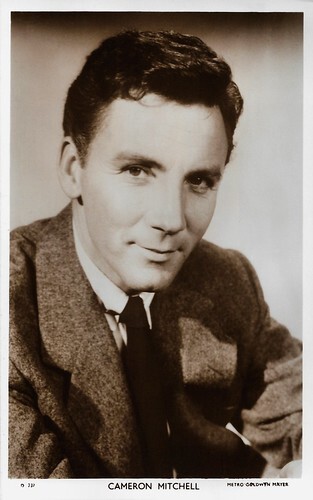
British postcard in the Picturegoer Series, London, no. D. 737. Photo: Metro Goldwyn Mayer.
A former Confederate soldier and a drunkard cowhand
In 1960, Cameron Mitchell went to Italy, where large sums were being paid to fading Hollywood names. He starred as King Harald Hardradain in L'ultimo dei Vikinghi / The Last of the Vikings (Giacomo Gentilomo, 1961), and two follow-ups, Gli invasori / Erik the Conqueror (Mario Bava, 1961) and I Normanni / Attack of the Normans (Giuseppe Vari, 1961). In Rome, he often worked with cult director Mario Bava, such as in the Giallo Sei donne per l'assassino / Blood and Black Lace (Mario Bava, 1964) with Eva Bartok , in which he portrays the owner of a fashion house plagued by a series of brutal murders, and he played a knife-throwing Viking warrior in I coltelli del vendicatore / Knives of the Avenger (Mario Bava, 1966). He also appeared in Westerns, such as Minnesota Clay (Sergio Corbucci, 1964), one of the first Spaghetti Westerns released after the surprise success of Per un pugno di dollari / A Fistful of Dollars (Sergio Leone, 1964) with Clint Eastwood .
Back in the USA, he starred in the Western Ride in the Whirlwind (Monte Hellman, 1966) with Millie Perkins , Jack Nicholson , and Harry Dean Stanton. Mitchell is best remembered by the public for his starring role as the tough Uncle Buck Cannon in the popular Western TV series The High Chaparral (1967-1971), opposite Leif Erickson and Henry Darrow as Manolito Montoya. Mitchell, who did not drink, was a hit as the former Confederate soldier, drunkard cowhand Buck Cannon. Before he was cast by producer David Dortort for the series, he had appeared in an episode of Bonanza (1959) and a short-lived TV series that had also been produced by Dortort.
In later years, Mitchell appeared in mean roles as a sheriff outlaw in Hombre (Martin Ritt, 1967) starring Paul Newman , an outlaw in Buck and the Preacher (Sidney Poitier, 1972) and a Ku Klux Klan racist in The Klansman (Terence Young, 1974) with Lee Marvin . From 1970, he intermittently filmed The Other Side of the Wind with director Orson Welles , a project not released until 2018. In 1975-1976, he portrayed Jeremiah Worth in the TV series Swiss Family Robinson and had a supporting role opposite former Methodist minister Leo Fong in the Philippine film Enforcer from Death Row (Marshall M. Borden, Efren C. Piñon, 1976). He played the captain of the 'Goliath' in the thriller The Deep (Peter Yates, 1977), but his scenes were deleted.
In the 1970s and 1980s, he played in numerous exploitation films, such as The Toolbox Murders (Dennis Donnelly, 1978), the Horror film The Swarm (Irwin Allen, 1978) with Michael Caine , and the Slasher films The Demon (Percival Rubens, 1979) and Silent Scream (Denny Harris 1980) with Barbara Steele and Yvonne De Carlo . The latter became one of the most financially successful independent Horror films of the 1970s. Mitchell even appeared in a hardcore porn film, Dixie Ray: Hollywood Star (Anthony Spinelli, 1982). He played a police lieutenant, although he did not 'perform'. Reportedly, he wasn't told it was a sex film until after his scenes were shot. Towards the end of his career, Mitchell had supporting roles in the anthology Horror films Night Train to Terror (Jay Schlossberg-Cohen, a.o., 1985) and From a Whisper to a Scream (Jeff Burr, 1987) with Vincent Price , as well as roles as the right-wing general Edwin A. Walker in Prince Jack (Bert Lovitt, 1985) and as Captain Alex Jansen in the South African Science-Fiction film Space Mutiny (David Winters, 1988) with John Philip Law.
Mitchell’s fortune took a downturn along with his career, and he twice filed for bankruptcy, in 1965 and 1974. Mitchell was a heavy smoker. As a result, he died in 1994 at his home in Pacific Palisades, California, after battling lung cancer for nearly two years. He reconciled with his first wife, Camille Janclaire, just before his death. Mitchell was survived by six of his seven children, including actors Cameron Mitchell Jr. and Camille Mitchell, and by 5 grandchildren, including Charles Joseph Mitchell and actress Jinjara Mitchell. Cameron Mitchell is interred at Desert Memorial Park in Cathedral City, CA. Due to his numerous appearances in 'Schlock movies', Red Letter Media named him 'the patron saint of Best of the Worst', and he is part of their 'Best of the Worst Hall of Fame'.

British postcard in the Celebrity Autograph Series by L.D. LTD., London, no. 109. Photo: 20th Century Fox. Cameron Mitchell in Hell and High Water (Samuel Fuller, 1954).
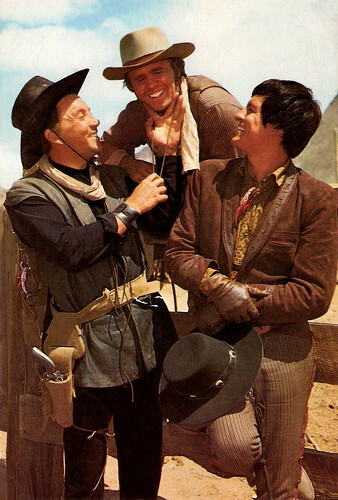
Dutch postcard, no. 4. Cameron Mitchell as Buck, Mark Slade as Billy Blue and Henry Darrow as Manolito in the TV series The High Chapparal (1967-1971).
Sources: David Shipman (The Independent), Wikipedia (Dutch and English) and .

Dutch postcard. Cameron Mitchell as Buck Cannon in The High Chapparal (1967-1971).

Dutch postcard by Uitg. Takken, Utrecht, no. 1715. Photo: 20th Century Fox.
Discovered by Elia Kazan
Cameron Mitchell was born Cameron McDowell Mitzell in 1918 in Dallastown, Pennsylvania. His parents, Charles and Kathryn Mitzell, were both ministers of the Reformed Lutheran Church, and Cameron was the fourth of their seven children. In 1921, the family moved to Chicora, Pennsylvania, where his father was accepted as pastor of the St. John's Reformed Church, and he grew up in Shrewsbury, Pennsylvania. Cameron graduated from Greenwood High School in Millerstown, PA, in 1936.
His father wanted him to be a minister, but 'Cam' became an actor instead. In New York City, he attended the Theatre School of Dramatic Arts. In 1939, Mitchell made his Broadway debut in a secondary role in 'Jeremiah'. During this time, Mitchell became a piccolo at NBC Radio City, leading to a secondary role in a production of William Shakespeare 's 'The Taming of the Shrew' (1940), with Alfred Lunt and Lynn Fontanne's National Theatre Company. He changed his name from Mitzell to Mitchell because Fontanne realised his real name sounded "a little bit too much like the Hun". In 1940, he also appeared in an experimental television broadcast, The Passing of the Third Floor Back. Mitchell appeared again on Broadway in 'The Trojan Women' in 1941.
During World War II, he served in the US Army Air Forces as a bombardier. In 1945, Mitchell signed a contract with MGM and made his film debut in What Next, Corporal Hargrove? (Richard Thorpe, 1945) starring Robert Walker . He continued with stage as well as film work. He had another small part in the War film They Were Expendable (John Ford, 1945), starring Robert Montgomery and John Wayne , but soon followed bigger roles. He appeared in the drama Cass Timberlane (George Sidney, 1947) starring Spencer Tracy , and the War film Homecoming (Mervyn LeRoy, 1948) with Clark Gable and Lana Turner .
He had his break when Elia Kazan chose him to play Happy Loman, the younger son, in Arthur Miller's stage play 'Death of a Salesman' on Broadway alongside Lee J. Cobb. His performance earned him a 1949 Theatre World Award. Mitchell also played the role in the film version, Death of a Salesman (Laslo Benedek, 1951) starring Fredric March as Willy Loman. It led to a contract with 20th Century-Fox, where he had a prolific career in films such as Les Misérables (Lewis Milestone, 1952). With Marilyn Monroe , Betty Grable and Lauren Bacall , he appeared in the hit comedy How to Marry a Millionaire (Jean Negulesco, 1953). Reportedly, he introduced Monroe to Elia Kazan and Arthur Miller. He then appeared with Gary Cooper , Susan Hayward and Richard Widmark in the Western Garden of Evil (Henry Hathaway, 1954), followed by a supporting role in Samuel Fuller's Cold War drama Hell and High Water (1954).
He then played Joseph Bonaparte opposite Marlon Brando as Napoleon in Désirée (Henry Koster, 1954). He appeared with Clark Gable and Jane Russell in the Western The Tall Men (Raoul Walsh, 1955) and had a role in the film version of the musical Carousel (Henry King, 1956). Mitchell was loaned back to MGM to star with Doris Day in the comedy musical Love Me or Leave Me (Charles Vidor, 1955), as the pianist only too willing to pick up the singer Ruth Etting after she has been knocked down for the nth time by her husband. Mitchell starred alongside Joanne Woodward and Sheree North in the drama No Down Payment (Martin Ritt, 1957).

British postcard in the Picturegoer Series, London, no. D. 345. Photo: 20th Century Fox.

British postcard in the Picturegoer Series, London, no. D. 737. Photo: Metro Goldwyn Mayer.
A former Confederate soldier and a drunkard cowhand
In 1960, Cameron Mitchell went to Italy, where large sums were being paid to fading Hollywood names. He starred as King Harald Hardradain in L'ultimo dei Vikinghi / The Last of the Vikings (Giacomo Gentilomo, 1961), and two follow-ups, Gli invasori / Erik the Conqueror (Mario Bava, 1961) and I Normanni / Attack of the Normans (Giuseppe Vari, 1961). In Rome, he often worked with cult director Mario Bava, such as in the Giallo Sei donne per l'assassino / Blood and Black Lace (Mario Bava, 1964) with Eva Bartok , in which he portrays the owner of a fashion house plagued by a series of brutal murders, and he played a knife-throwing Viking warrior in I coltelli del vendicatore / Knives of the Avenger (Mario Bava, 1966). He also appeared in Westerns, such as Minnesota Clay (Sergio Corbucci, 1964), one of the first Spaghetti Westerns released after the surprise success of Per un pugno di dollari / A Fistful of Dollars (Sergio Leone, 1964) with Clint Eastwood .
Back in the USA, he starred in the Western Ride in the Whirlwind (Monte Hellman, 1966) with Millie Perkins , Jack Nicholson , and Harry Dean Stanton. Mitchell is best remembered by the public for his starring role as the tough Uncle Buck Cannon in the popular Western TV series The High Chaparral (1967-1971), opposite Leif Erickson and Henry Darrow as Manolito Montoya. Mitchell, who did not drink, was a hit as the former Confederate soldier, drunkard cowhand Buck Cannon. Before he was cast by producer David Dortort for the series, he had appeared in an episode of Bonanza (1959) and a short-lived TV series that had also been produced by Dortort.
In later years, Mitchell appeared in mean roles as a sheriff outlaw in Hombre (Martin Ritt, 1967) starring Paul Newman , an outlaw in Buck and the Preacher (Sidney Poitier, 1972) and a Ku Klux Klan racist in The Klansman (Terence Young, 1974) with Lee Marvin . From 1970, he intermittently filmed The Other Side of the Wind with director Orson Welles , a project not released until 2018. In 1975-1976, he portrayed Jeremiah Worth in the TV series Swiss Family Robinson and had a supporting role opposite former Methodist minister Leo Fong in the Philippine film Enforcer from Death Row (Marshall M. Borden, Efren C. Piñon, 1976). He played the captain of the 'Goliath' in the thriller The Deep (Peter Yates, 1977), but his scenes were deleted.
In the 1970s and 1980s, he played in numerous exploitation films, such as The Toolbox Murders (Dennis Donnelly, 1978), the Horror film The Swarm (Irwin Allen, 1978) with Michael Caine , and the Slasher films The Demon (Percival Rubens, 1979) and Silent Scream (Denny Harris 1980) with Barbara Steele and Yvonne De Carlo . The latter became one of the most financially successful independent Horror films of the 1970s. Mitchell even appeared in a hardcore porn film, Dixie Ray: Hollywood Star (Anthony Spinelli, 1982). He played a police lieutenant, although he did not 'perform'. Reportedly, he wasn't told it was a sex film until after his scenes were shot. Towards the end of his career, Mitchell had supporting roles in the anthology Horror films Night Train to Terror (Jay Schlossberg-Cohen, a.o., 1985) and From a Whisper to a Scream (Jeff Burr, 1987) with Vincent Price , as well as roles as the right-wing general Edwin A. Walker in Prince Jack (Bert Lovitt, 1985) and as Captain Alex Jansen in the South African Science-Fiction film Space Mutiny (David Winters, 1988) with John Philip Law.
Mitchell’s fortune took a downturn along with his career, and he twice filed for bankruptcy, in 1965 and 1974. Mitchell was a heavy smoker. As a result, he died in 1994 at his home in Pacific Palisades, California, after battling lung cancer for nearly two years. He reconciled with his first wife, Camille Janclaire, just before his death. Mitchell was survived by six of his seven children, including actors Cameron Mitchell Jr. and Camille Mitchell, and by 5 grandchildren, including Charles Joseph Mitchell and actress Jinjara Mitchell. Cameron Mitchell is interred at Desert Memorial Park in Cathedral City, CA. Due to his numerous appearances in 'Schlock movies', Red Letter Media named him 'the patron saint of Best of the Worst', and he is part of their 'Best of the Worst Hall of Fame'.

British postcard in the Celebrity Autograph Series by L.D. LTD., London, no. 109. Photo: 20th Century Fox. Cameron Mitchell in Hell and High Water (Samuel Fuller, 1954).

Dutch postcard, no. 4. Cameron Mitchell as Buck, Mark Slade as Billy Blue and Henry Darrow as Manolito in the TV series The High Chapparal (1967-1971).
Sources: David Shipman (The Independent), Wikipedia (Dutch and English) and .
Published on August 12, 2025 22:00
August 11, 2025
June Collyer
American actress June Collyer (1904-1968) did a total of 11 silent films before she made a successful transition to talkies. She often worked with director John Ford.
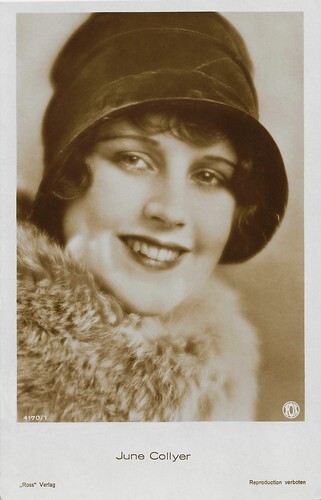
German postcard by Ross Verlag, no. 4170/1, 1929-1930. Photo: Paramount.
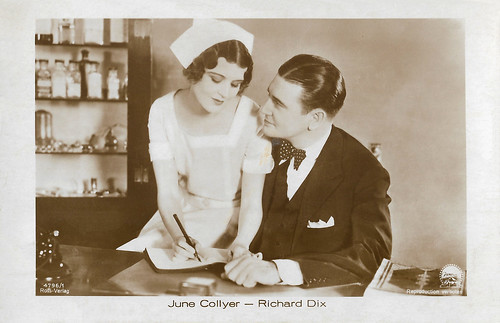
German postcard by Ross Verlag, no. 4796/1, 1929-1930. Photo: Paramount. June Collyer and Richard Dix in The Love Doctor (Melville W. Brown, 1929).
One of 13 WAMPAS Baby Stars
June Collyer was born Dorothea Heermance in New York City in 1904. Her father was Clayton Heermance, an attorney in New York. Collyer was her mother's maiden name.
Her grandfather, Dan Collyer, had a 54-year career as a stage actor. She was the sister of actor Bud Collyer, who was married to actress Marian Shockley, and film editor Richard V. Heermance.
June began her acting career in the film East Side, West Side (Allan Dwan, 1927) starring George O'Brien and Virginia Valli .
In 1928, she was one of 13 girls selected as WAMPAS Baby Stars. That year, she had major roles in Woman Wise (Albert Ray, 1928) with William Russell , and Me, Gangster (Raoul Walsh, 1928).
June Collyer worked with director John Ford in such films as the War drama Four Sons (John Ford, 1928) starring James Hall and the thriller Hangman's House (John Ford, 1928) with Victor McLaglen and Larry Kent.
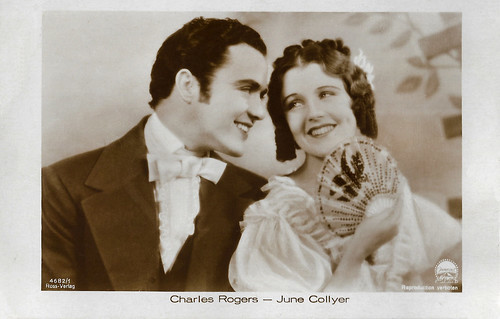
German postcard by Ross Verlag, no. 4682/1, 1929-1930. Photo: Paramount. Charles Rogers and June Collyer in the period piece River to Romance (Richard Wallace, 1929), an early sound film.

Austrian postcard by Iris Verlag, no. 5571. Photo: Max Munn Autrey / Fox.
A successful change to the sound era
After making the successful change to the sound era, June Collyer continued to work, something some of her counterparts couldn't do.
In 1930, Collyer starred opposite Louise Dresser and Joyce Compton in The Three Sisters (Paul Sloane, 1930), and the same year, she starred with Claudia Dell in Sweet Kitty Bellairs (Alfred E. Green, 1930). She starred in 19 films from 1930 to 1936.
In 1931, Collyer married actor Stuart Erwin. Her last meaningful film was A Face in the Fog (Robert F. Hill, 1936), opposite Lloyd Hughes . She took a break in the 1940s, either by choice or due to her not receiving starring roles.
During the 1950s, she returned to acting in her husband's television series The Stu Erwin Show (1950-1955). She played in one episode of the 1958 series Playhouse 90, then retired.
Stuart Erwin died in 1967. Three months later, June Collyer died of bronchial pneumonia in 1968. She was 63. The couple had two children, producer Stuart Erwin Jr. and Judy Erwin. Erwin and Collyer have a crypt at the Chapel of the Pines in Los Angeles.
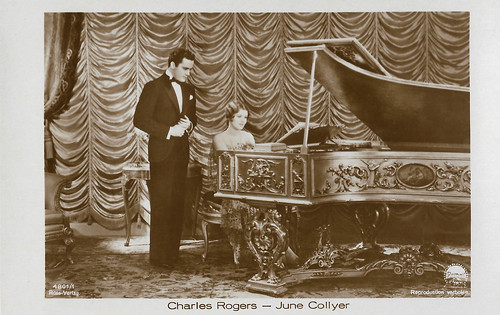
German postcard by Ross Verlag, no. 4801/1. 1929-1930. Photo: Paramount. Charles Rogers and June Collyer, perhaps in the early sound film Illusion (Lothar Mendes, 1929).
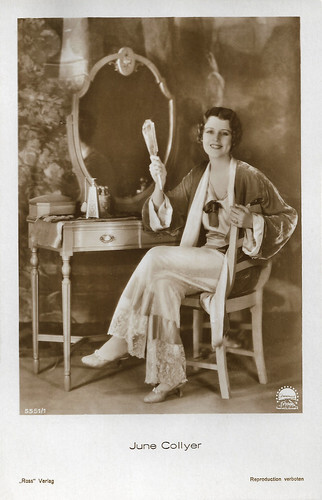
German postcard by Ross Verlag, no. 5551/1, 1930-1931. Photo: Paramount.
Sources: (IMDb), Wikipedia (Dutch and English) and .

German postcard by Ross Verlag, no. 4170/1, 1929-1930. Photo: Paramount.

German postcard by Ross Verlag, no. 4796/1, 1929-1930. Photo: Paramount. June Collyer and Richard Dix in The Love Doctor (Melville W. Brown, 1929).
One of 13 WAMPAS Baby Stars
June Collyer was born Dorothea Heermance in New York City in 1904. Her father was Clayton Heermance, an attorney in New York. Collyer was her mother's maiden name.
Her grandfather, Dan Collyer, had a 54-year career as a stage actor. She was the sister of actor Bud Collyer, who was married to actress Marian Shockley, and film editor Richard V. Heermance.
June began her acting career in the film East Side, West Side (Allan Dwan, 1927) starring George O'Brien and Virginia Valli .
In 1928, she was one of 13 girls selected as WAMPAS Baby Stars. That year, she had major roles in Woman Wise (Albert Ray, 1928) with William Russell , and Me, Gangster (Raoul Walsh, 1928).
June Collyer worked with director John Ford in such films as the War drama Four Sons (John Ford, 1928) starring James Hall and the thriller Hangman's House (John Ford, 1928) with Victor McLaglen and Larry Kent.

German postcard by Ross Verlag, no. 4682/1, 1929-1930. Photo: Paramount. Charles Rogers and June Collyer in the period piece River to Romance (Richard Wallace, 1929), an early sound film.

Austrian postcard by Iris Verlag, no. 5571. Photo: Max Munn Autrey / Fox.
A successful change to the sound era
After making the successful change to the sound era, June Collyer continued to work, something some of her counterparts couldn't do.
In 1930, Collyer starred opposite Louise Dresser and Joyce Compton in The Three Sisters (Paul Sloane, 1930), and the same year, she starred with Claudia Dell in Sweet Kitty Bellairs (Alfred E. Green, 1930). She starred in 19 films from 1930 to 1936.
In 1931, Collyer married actor Stuart Erwin. Her last meaningful film was A Face in the Fog (Robert F. Hill, 1936), opposite Lloyd Hughes . She took a break in the 1940s, either by choice or due to her not receiving starring roles.
During the 1950s, she returned to acting in her husband's television series The Stu Erwin Show (1950-1955). She played in one episode of the 1958 series Playhouse 90, then retired.
Stuart Erwin died in 1967. Three months later, June Collyer died of bronchial pneumonia in 1968. She was 63. The couple had two children, producer Stuart Erwin Jr. and Judy Erwin. Erwin and Collyer have a crypt at the Chapel of the Pines in Los Angeles.

German postcard by Ross Verlag, no. 4801/1. 1929-1930. Photo: Paramount. Charles Rogers and June Collyer, perhaps in the early sound film Illusion (Lothar Mendes, 1929).

German postcard by Ross Verlag, no. 5551/1, 1930-1931. Photo: Paramount.
Sources: (IMDb), Wikipedia (Dutch and English) and .
Published on August 11, 2025 22:00
August 10, 2025
Robert De Niro
Legendary American actor Robert De Niro (1943) has starred in such classic films as Taxi Driver (1976), Novecento/1900 (1978), The Deer Hunter (1978), Awakenings (1990) and GoodFellas (1990). His role in The Godfather: Part II (1974) brought him his first Academy Award, and he scored his second Oscar for his portrayal of Jake La Motta in Raging Bull (1980). De Niro worked with many acclaimed film directors, including Brian DePalma, Francis Coppola, Elia Kazan, Bernardo Bertolucci and, most importantly, Martin Scorsese. He also appeared in French, British and Italian films.
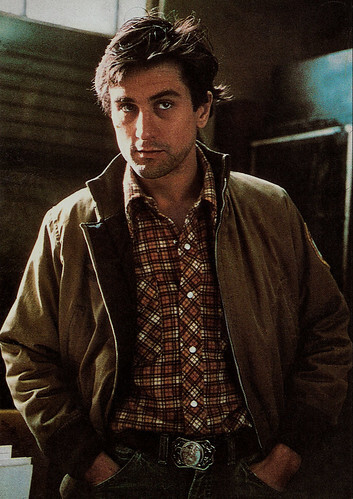
Italian postcard by Edizioni Beatrice D'Este, no. 20 162. Photo: Steve Schapiro. Robert De Niro in Taxi Driver (Martin Scorsese, 1976).
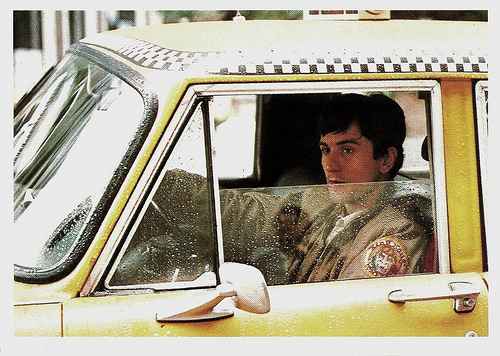
French postcard in the Collection Cinema Couleur by Edition La Malibran, Paris, no. MC 33, 1990. Photo: publicity still for Taxi Driver (Martin Scorsese, 1976).
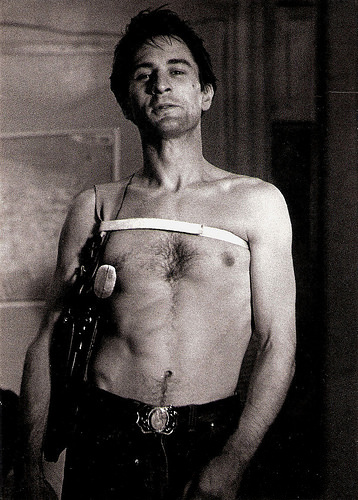
Belgian promotion card by Tasschen Gallery for the exhibition 'Taxi Driver - unseen photographs from Scorsese's Masterpiece'. Photo: Steve Schapiro. Publicity still for Taxi Driver (Martin Scorsese, 1976).
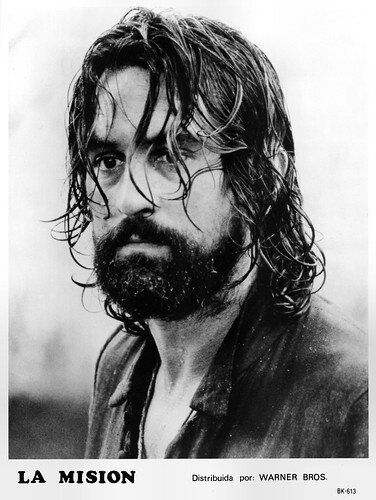
Spanish photo, no. BK-613. Photo: Warner Bros. Robert de Niro in The Mission (Roland Joffé, 1986). The Spanish title is 'La Mision'.
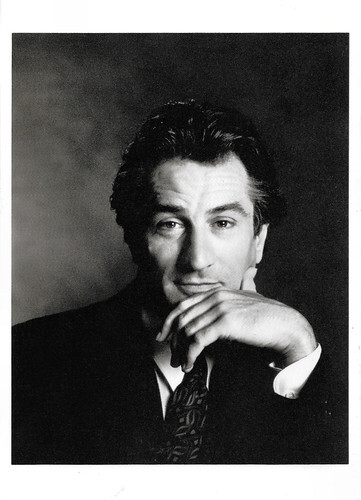
American postcard by Fotofolio, NY, NY, no. GG23. Photo: Greg Gorman. Caption: Robert de Niro, Los Angeles, 1990. Proceeds from the sale of this card benefit Make Love, Not AIDS.

British postcard by Pyramid, Leicester, no PC 8292. Caption: Robert DeNiro (sic) - Shirt & Tie.

Vintage postcard by Memory Card, no. 98. Lobby card of Robert de Niro in Heat (Michael Mann, 1995).
The most chilling performance of his career
Robert Anthony De Niro was born in the Greenwich Village area of Manhattan, New York City in 1943. His mother, Virginia Admiral, was a cerebral and gifted painter, and his father, Robert De Niro Sr., was a painter, sculptor and poet whose work received high critical acclaim. They split ways in 1945, when young Robert was only 2 years old, after his father announced that he was gay. De Niro was raised primarily by his mother, who took on work as a typesetter and printer to support her son. A bright and energetic child, Robert De Niro was incredibly fond of attending films with his father when they spent time together. De Niro's mother worked part-time as a typist and copy editor for Maria Picator's Dramatic Workshop, and as part of her compensation, De Niro was allowed to take children's acting classes for free. At the age of 10, De Niro made his stage debut as the Cowardly Lion in a school production of The Wizard of Oz. De Niro proved to be uninterested in school altogether and, as a teenager, joined a rather tame street gang in Little Italy that gave him the nickname Bobby Milk, about his pale complexion. While De Niro was by all accounts only a very modest troublemaker, the gang provided him with experience to skilfully portray Italian mobsters as an actor.
He left school at age 16 to study acting Stella Adler Conservatory. Adler, who had taught Marlon Brando and Rod Steiger, was a strong proponent of the Stanislavski method of acting, involving deep psychological character investigation. He studied briefly with Lee Strasberg at the Actor's Studio in New York City, and then began auditioning. After a momentary cameo in the French film Trois chambres à Manhattan/Three Rooms in Manhattan (Marcel Carné, 1965), De Niro's real film debut came in Greetings (Brian De Palma, 1968). However, De Niro's first film role already came at the age of 20, when he appeared credited as Robert Denero in De Palma’s The Wedding Party (Brian De Palma, Wilford Leach, 1963), but the film was not released until 1969.
He then appeared in Roger Corman's film Bloody Mama (1970), featuring Shelley Winters . His breakthrough performances came a few years later in two highly acclaimed films: the sports drama Bang the Drum Slowly (John D. Hancock, 1973), in which he played a terminally ill catcher on a baseball team, and the crime film Mean Streets (1973), his first of many collaborations with director Martin Scorsese, in which he played street thug Johnny Boy opposite Harvey Keitel. De Niro and Martin Scorsese worked successfully together on eight films: Mean Streets (1973), Taxi Driver (1976), New York, New York (1977), Raging Bull (1980), The King of Comedy (1983), Goodfellas (1990), Cape Fear (1991), and Casino (1995).
In 1974, De Niro established himself as one of America’s finest actors with his Academy Award-winning portrayal of the young Vito Corleone in The Godfather: Part II (Francis Ford Coppola, 1974), a role for which he learned to speak Sicilian. Two years later, De Niro delivered perhaps the most chilling performance of his career, playing vengeful cabbie Travis Bickle in Taxi Driver (Martin Scorsese, 1976) alongside Jodie Foster . His iconic performance as Travis Bickle catapulted him to stardom and forever linked his name with Bickle's famous 'You talkin' to me?' monologue, which De Niro largely improvised.
In Italy, De Niro appeared opposite Gérard Dépardieu in the epic historical drama Novecento/1900 (Bernardo Bertolucci, 1976). The film is an exploration of life in Italy in the first half of the 20th century, seen through the eyes of two Italian childhood friends at opposite sides of society's hierarchy. He also starred in The Last Tycoon (1976), the last film directed by Elia Kazan. The Hollywood drama is based upon Harold Pinter's screenplay adaptation of F. Scott Fitzgerald's The Last Tycoon. De Niro continued to show his tremendous skill as a dramatic actor in the Vietnam War drama The Deer Hunter (Michael Cimino, 1978). The film follows a group of friends haunted by their Vietnam experiences. De Niro later portrayed middleweight boxer Jake LaMotta in the commercially unsuccessful but critically adored film Raging Bull (Martin Scorsese, 1980). The previously skinny De Niro had put on 60 pounds of muscle for his riveting turn as LaMotta and was rewarded for his dedication with the 1981 Academy Award for best actor.
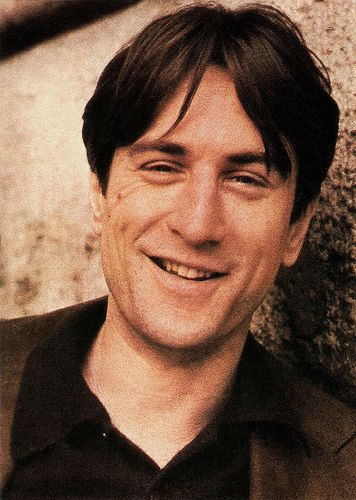
French postcard by Editions F. Nugeron, no. STAR 66. Photo: J. Ritchie / Classico, San Francisco.
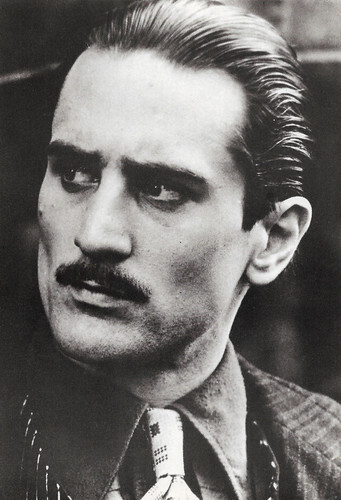
French postcard by Humour à la Carte, Paris, no. 3706. Robert de Niro in The Godfather Part II (Francis Coppola, 1974).
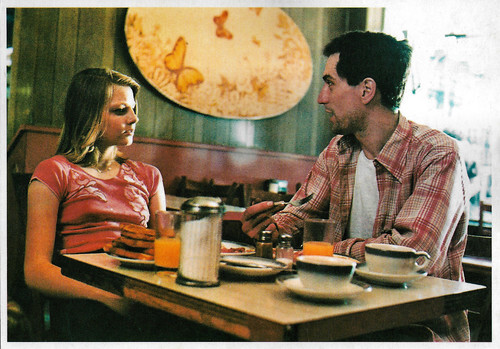
British postcard by Memory Card, no. 530. Photo: Steve Schapiro. Jodie Foster and Robert de Niro in Taxi Driver (Martin Scorsese, 1976).
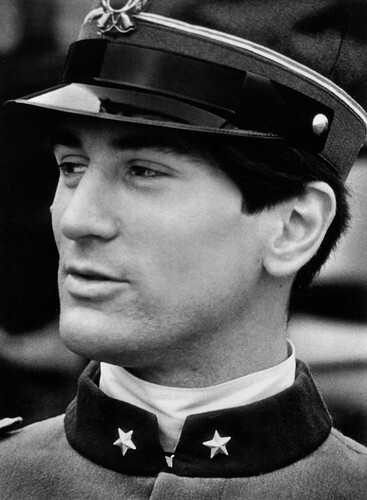
Vintage photo. Robert de Niro in Novecento / 1900 (Bernardo Bertolucci, 1976).
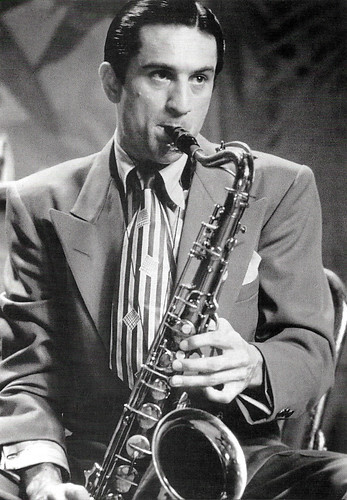
French postcard in the Collection Cinéma by Editions Art & Scene, Paris, no. CA 43. Robert de Niro in New York, New York (Martin Scorsese, 1977).

Dutch collector card in the 'Filmsterren: een Portret' series by Edito-Service S.A., 1994, no. D5 024 30-18. Photo: Kippa-Interpress. Robert de Niro in The Deer Hunter (Michael Cimino, 1978).
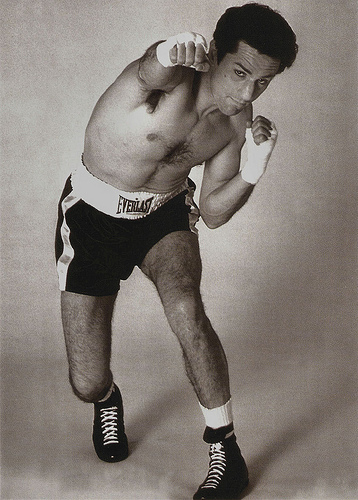
British postcard by Classic. Photo: publicity still for Raging Bull (Martin Scorsese, 1980).
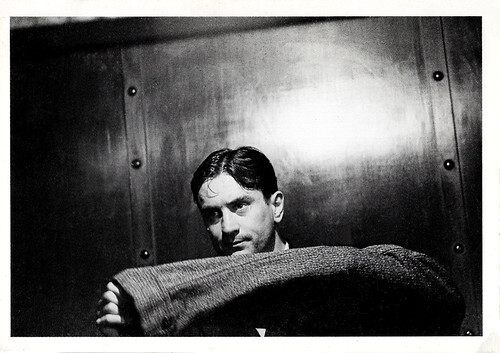
Italian postcard by I.P.Z.S. - Libreria dello Stato, Roma, no. B28. Photo: Angelo Novi. Robert de Niro in C'era una volta in America / Once Upon a Time in America (Sergio Leone, 1984).
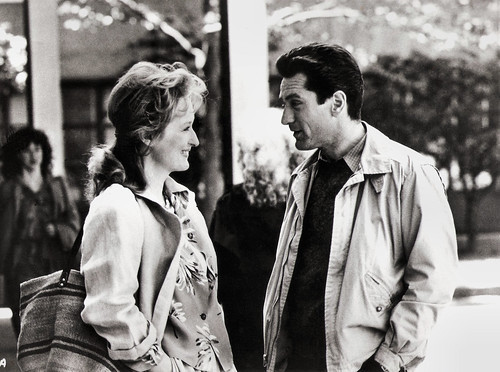
Vintage publicity photo. Meryl Streep and Robert De Niro in Falling in Love (Ulu Grosbard, 1984).
Reunited in a terrifying way
In the 1980s, Robert De Niro first roles were a worldly ambitious Catholic priest in True Confessions (Ulu Grosbard, 1981), an aspiring stand-up comedian in Scorsese's The King of Comedy (Martin Scorsese, 1983) and as a Jewish mobster in the sprawling historical epic Once Upon a Time in America (Sergio Leone, 1984).
Other notable projects included Sci-fi art film Brazil (Terry Gilliam, 1985) and the British drama The Mission (Roland Joffé, 1986), about the experiences of a Jesuit missionary in 18th-century South America, which won the Golden Palm at the Cannes Film Festival. It was followed by films like the crime drama The Untouchables (Brian De Palma, 1987), in which De Niro portrayed gangster Al Capone opposite Kevin Costner as Eliot Ness, the mysterious thriller Angel Heart (Alan Parker, 1987) and the action comedy Midnight Run (Martin Brest, 1988).
De Niro opened the 1990s with Goodfellas (Martin Scorsese, 1990), yet another acclaimed gangster film from Scorsese that saw the actor teaming up with Ray Liotta and Joe Pesci. De Niro next starred in a project that earned him another Oscar nomination, portraying a catatonic patient brought back to awareness in Awakenings (Penny Marshall, 1990), co-starring Robin Williams as a character based on physician Oliver Sacks. Dramas continued to be the genre of choice for De Niro, as he played a blacklisted director in Guilty by Suspicion (Irwin Winkler, 1991) and a fire chief in Backdraft (Ron Howard, 1991).
Soon afterwards, the actor was once again front and centre and reunited with Scorsese in a terrifying way, bulking up to become a tattooed rapist who stalks a family in Cape Fear (Martin Scorsese, 1991). The film was a remake of the 1962 thriller starring Gregory Peck and Robert Mitchum . Peck and Mitchum made appearances in the remake as well. De Niro received his sixth Academy Award nomination for Cape Fear, with the film becoming the highest-grossing collaboration between the actor and Scorsese, earning more than $182 million worldwide. After somewhat edgy, comedic outings like Night and the City (Irwin Winkler, 1992) and Mad Dog and Glory (John McNaughton, 1993), another drama followed in the form of This Boy's Life (Michael Caton-Jones, 1993), in which De Niro portrayed the abusive stepfather of a young Leonardo DiCaprio .
That same year, De Niro made his directorial debut with A Bronx Tale (Robert De Niro, 1993), a film adaptation of a one-man play written and performed by Chazz Palminteri. In 1994, De Niro was practically unrecognisable as the monster in actor-director Kenneth Branagh's adaptation of the Mary Shelley novel Frankenstein (Kenneth Branagh, 1994). It was followed by another Scorsese telling of mob life, this time in Las Vegas. De Niro portrayed a character based on real-life figure Frank ‘Lefty’ Rosenthal in Casino (Martin Scorsese, 1995), co-starring Sharon Stone and Joe Pesci. In Heat (Michael Mann, 1995), De Niro re-teamed with fellow Godfather star Al Pacino in a well-received outing about a bank robber contemplating getting out of the business and the police detective aiming to bring him down.
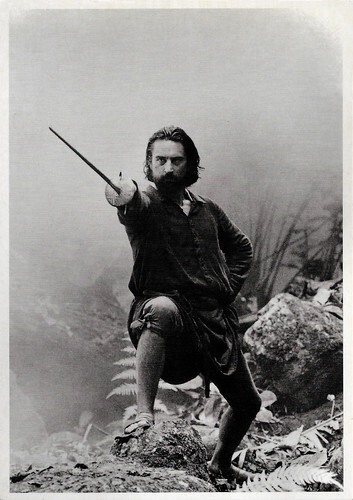
Canadian postcard by Canadian Postcard, no. A-3. Robert de Niro in The Mission (Roland Joffé, 1986).
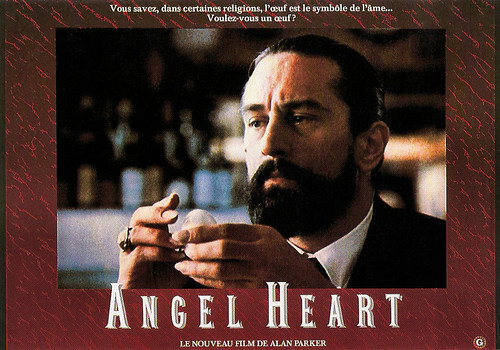
French postcard by Humour à la Carte, Paris, no. A-C 1259. Photo: Gaumont. Robert De Niro in Angel Heart (Alan Parker, 1987). Caption: You know, in certain religions, the egg is the symbol of a soul.... Would you like an egg?
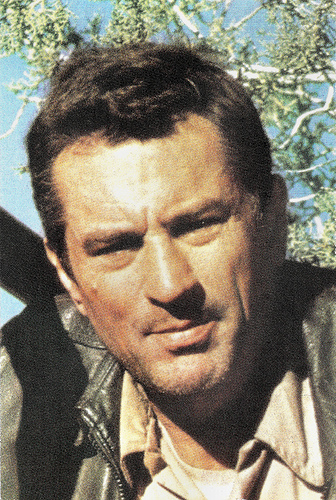
Romanian postcard by Casa Filmului Acin. Photo: publicity still for Midnight Run (Martin Brest, 1988).
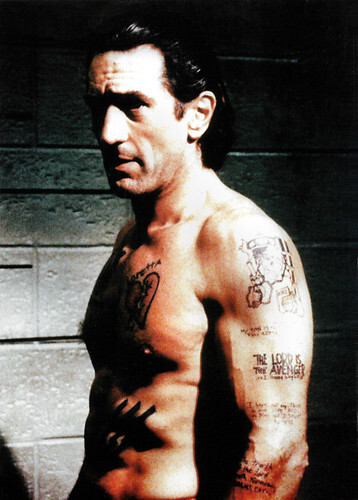
British postcard by Pyramid, Leicester, no. PC8258. Robert de Niro in Cape Fear (Martin Scorsese, 1991).
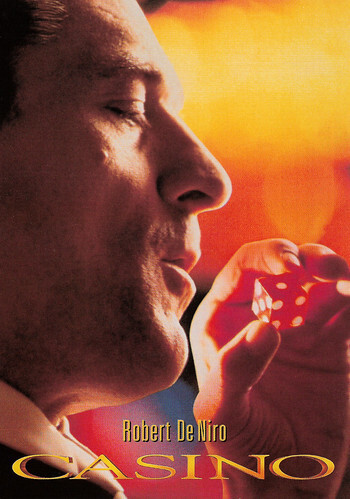
Dutch postcard by Boomerang, Amsterdam. Photo: UIP / Universal. Robert de Niro in Casino (Martin Scorsese, 1995).

Italian postcard by Edizioni Eden, Milano, for Solo Belli monthly, 1995.
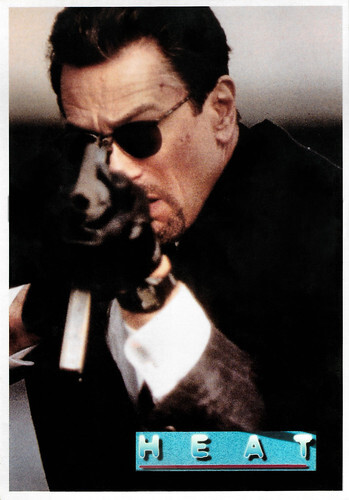
Vintage postcard by Memory Card, no. 96. Lobby card of Robert de Niro in Heat (Michael Mann, 1995).
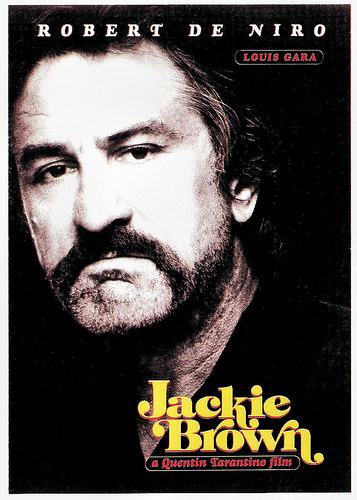
French postcard, no. 654. Photo: publicity still for Jackie Brown (Quentin Tarantino, 1997) with Robert De Niro as Louis Gara.
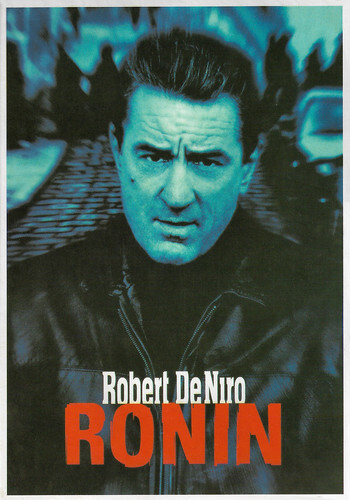
Vintage postcard in the Cinemascope Collection, no. 164. Robert de Niro in Ronin (John Frankenheimer, 1998).
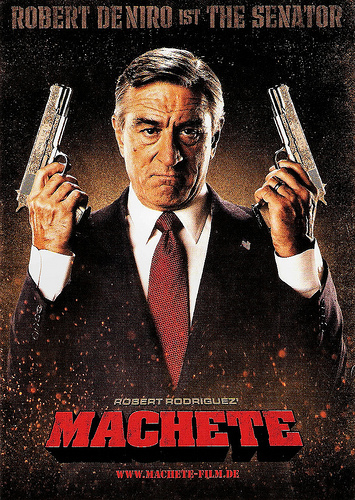
German postcard by CTMG, 2010. Photo: publicity still for Machete (Ethan Maniquis, Robert Rodriguez, 2010) with Robert De Niro as Senator McLaughlin.
Striking out into decidedly different territory
For the rest of the 1990s and into the new millennium, Robert De Niro featured yearly in a big-screen project as either a lead or supporting figure. His films include the legal crime drama Sleepers (Barry Levinson, 1996), the black comedy Wag the Dog (Barry Levinson, 1997), the crime drama Cop Land (James Mangold, 1997), the crime thriller Jackie Brown (Quentin Tarantino, 1997), the spy action-thriller Ronin (John Frankenheimer, 1998) and the crime comedy-drama Flawless (Joel Schumacher, 1999). At the turn of the century, De Niro struck out into decidedly different territory with Analyze This (Harold Ramis, 1999), a hilarious and highly popular spoof of the mob movies that had garnered him fame. Analyze This earned more than $100 million domestically, with De Niro playing a Mafioso who seeks help from a psychiatrist (Billy Crystal). De Niro took on another comedy, Meet the Parents (Jay Roach, 2000), as Ben Stiller's future father-in-law. The smash hit spawned two sequels: Meet the Fockers (Jay Roach, 2004) and Little Fockers (Paul Weitz, 2011), both of which were also box-office successes.
De Niro continued to switch between comedic and serious roles over the next few years, reuniting with Billy Crystal for Analyze That (Harold Ramis, 2002), and starring in the spy thriller The Good Shepherd (Robert De Niro, 2006) with Matt Damon and Angelina Jolie . The following year, De Niro was featured as a secretive cross-dressing pirate with a heart of gold in the fantasy flick Stardust (Matthew Vaughn, 2007), while 2009 saw a return to dramatic fare with Everybody's Fine (Kirk Jones, 2009). In Italy, De Niro starred in the romantic comedy Manuale d'amore 3/The Ages of Love (Giovanni Veronesi, 2011).
De Niro earned yet another Academy Award nomination for his turn in David O. Russell's Silver Linings Playbook (2012), playing the father of a mentally troubled son (Bradley Cooper). De Niro teamed up again with Silver Linings Playbook director Russell and stars Cooper and Jennifer Lawrence for the biopic Joy (David O. Russell, 2015), based on the life of Miracle Mop inventor Joy Mangano. Later that year, De Niro starred as a widower who returns to the workforce in The Intern (Nancy Meyers, 2015), with Anne Hathaway. In 2016, he starred in another biopic, Hands of Stone (Jonathan Jakubowicz, 2016), playing Ray Arcel, the trainer of Panamanian boxer Roberto Durán. That same year, De Niro received the Presidential Medal of Freedom from President Obama for his contribution to the arts.
In 2019, De Niro played a secondary role as Murray Franklin, a talk-show host, in the acclaimed Joker (Todd Phillips, 2019), starring Joaquin Phoenix as the DC Comics character, the Joker. De Niro's character echoes that of Jerry Lewis in The King of Comedy (Martin Scorsese, 1983), in which De Niro played the lead role. The film was a box-office triumph worldwide and received rave reviews from critics. For his portrayal of Robert Mueller alongside Alec Baldwin as Donald Trump in various episodes of Saturday Night Live, he received an Emmy nomination for Best Guest in a Comedy Series. The Irishman (Martin Scorsese, 2019), a gangster film based on the novel 'I Heard You Paint Houses', was his ninth feature film collaboration with Martin Scorsese. De Niro, who played Frank ‘The Irishman’ Sheeran, reunited with Al Pacino , Harvey Keitel, and Joe Pesci. The film, which became the director's longest at 210 minutes, was acclaimed. His next reunion with Scorsese, Killers of the Flower Moon (Martin Scorsese, 2023), with Leonardo DiCaprio , recounts the murders of the Osage Indians. De Niro played rancher William Hale, one of the FBI's prime suspects. The film premiered at the 2023 Cannes Film Festival and received excellent reviews, as did De Niro.
Robert De Niro, who has long resided in New York City, has been investing in Manhattan's Tribeca neighbourhood since 1989. His capital ventures there included co-founding the film studio TriBeCa Productions in 1998 and the Tribeca Film Festival (since 2002). De Niro married actress Diahnne Abbott in 1976. The couple had one son, Raphael, before divorcing 12 years later, in 1988. De Niro then had a long relationship with model Toukie Smith that produced twin sons, Aaron Kendrick and Julian Henry, in 1995. Then in 1997, De Niro married Grace Hightower, with whom he has two children.
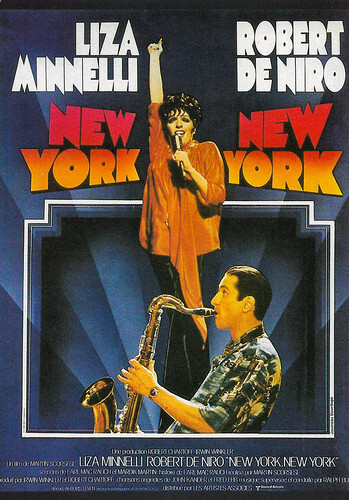
French postcard by Editions F. Nugeron, no. E 434. Image: French poster of New York, New York (Martin Scorsese, 1977) starring Liza Minnelli and Robert De Niro.
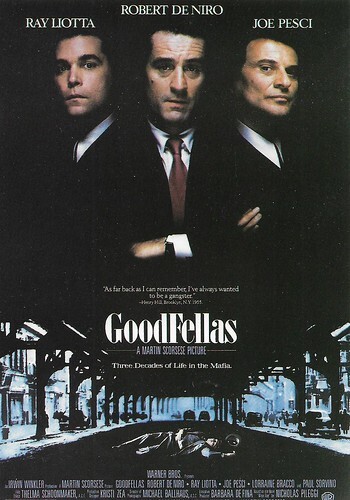
French postcard, 1990s. Poster postcard of Goodfellas (Martin Scorsese, 1990) with Ray Liotta, Robert de Niro, and Joe Pesci.
Trailer Novecento/1900 (1976). Source: Eurekaentertainment (YouTube).
Trailer Raging Bull (1980). Source: Movieclips Trailer Vault (YouTube).
Trailer The Mission (1986). Source: Warner Bros. (YouTube).
Trailer for Analyze This (1999). Source: Movieclips Trailer Vault (YouTube).
Sources: Biography.com, Wikipedia, and .

Italian postcard by Edizioni Beatrice D'Este, no. 20 162. Photo: Steve Schapiro. Robert De Niro in Taxi Driver (Martin Scorsese, 1976).

French postcard in the Collection Cinema Couleur by Edition La Malibran, Paris, no. MC 33, 1990. Photo: publicity still for Taxi Driver (Martin Scorsese, 1976).

Belgian promotion card by Tasschen Gallery for the exhibition 'Taxi Driver - unseen photographs from Scorsese's Masterpiece'. Photo: Steve Schapiro. Publicity still for Taxi Driver (Martin Scorsese, 1976).

Spanish photo, no. BK-613. Photo: Warner Bros. Robert de Niro in The Mission (Roland Joffé, 1986). The Spanish title is 'La Mision'.

American postcard by Fotofolio, NY, NY, no. GG23. Photo: Greg Gorman. Caption: Robert de Niro, Los Angeles, 1990. Proceeds from the sale of this card benefit Make Love, Not AIDS.

British postcard by Pyramid, Leicester, no PC 8292. Caption: Robert DeNiro (sic) - Shirt & Tie.

Vintage postcard by Memory Card, no. 98. Lobby card of Robert de Niro in Heat (Michael Mann, 1995).
The most chilling performance of his career
Robert Anthony De Niro was born in the Greenwich Village area of Manhattan, New York City in 1943. His mother, Virginia Admiral, was a cerebral and gifted painter, and his father, Robert De Niro Sr., was a painter, sculptor and poet whose work received high critical acclaim. They split ways in 1945, when young Robert was only 2 years old, after his father announced that he was gay. De Niro was raised primarily by his mother, who took on work as a typesetter and printer to support her son. A bright and energetic child, Robert De Niro was incredibly fond of attending films with his father when they spent time together. De Niro's mother worked part-time as a typist and copy editor for Maria Picator's Dramatic Workshop, and as part of her compensation, De Niro was allowed to take children's acting classes for free. At the age of 10, De Niro made his stage debut as the Cowardly Lion in a school production of The Wizard of Oz. De Niro proved to be uninterested in school altogether and, as a teenager, joined a rather tame street gang in Little Italy that gave him the nickname Bobby Milk, about his pale complexion. While De Niro was by all accounts only a very modest troublemaker, the gang provided him with experience to skilfully portray Italian mobsters as an actor.
He left school at age 16 to study acting Stella Adler Conservatory. Adler, who had taught Marlon Brando and Rod Steiger, was a strong proponent of the Stanislavski method of acting, involving deep psychological character investigation. He studied briefly with Lee Strasberg at the Actor's Studio in New York City, and then began auditioning. After a momentary cameo in the French film Trois chambres à Manhattan/Three Rooms in Manhattan (Marcel Carné, 1965), De Niro's real film debut came in Greetings (Brian De Palma, 1968). However, De Niro's first film role already came at the age of 20, when he appeared credited as Robert Denero in De Palma’s The Wedding Party (Brian De Palma, Wilford Leach, 1963), but the film was not released until 1969.
He then appeared in Roger Corman's film Bloody Mama (1970), featuring Shelley Winters . His breakthrough performances came a few years later in two highly acclaimed films: the sports drama Bang the Drum Slowly (John D. Hancock, 1973), in which he played a terminally ill catcher on a baseball team, and the crime film Mean Streets (1973), his first of many collaborations with director Martin Scorsese, in which he played street thug Johnny Boy opposite Harvey Keitel. De Niro and Martin Scorsese worked successfully together on eight films: Mean Streets (1973), Taxi Driver (1976), New York, New York (1977), Raging Bull (1980), The King of Comedy (1983), Goodfellas (1990), Cape Fear (1991), and Casino (1995).
In 1974, De Niro established himself as one of America’s finest actors with his Academy Award-winning portrayal of the young Vito Corleone in The Godfather: Part II (Francis Ford Coppola, 1974), a role for which he learned to speak Sicilian. Two years later, De Niro delivered perhaps the most chilling performance of his career, playing vengeful cabbie Travis Bickle in Taxi Driver (Martin Scorsese, 1976) alongside Jodie Foster . His iconic performance as Travis Bickle catapulted him to stardom and forever linked his name with Bickle's famous 'You talkin' to me?' monologue, which De Niro largely improvised.
In Italy, De Niro appeared opposite Gérard Dépardieu in the epic historical drama Novecento/1900 (Bernardo Bertolucci, 1976). The film is an exploration of life in Italy in the first half of the 20th century, seen through the eyes of two Italian childhood friends at opposite sides of society's hierarchy. He also starred in The Last Tycoon (1976), the last film directed by Elia Kazan. The Hollywood drama is based upon Harold Pinter's screenplay adaptation of F. Scott Fitzgerald's The Last Tycoon. De Niro continued to show his tremendous skill as a dramatic actor in the Vietnam War drama The Deer Hunter (Michael Cimino, 1978). The film follows a group of friends haunted by their Vietnam experiences. De Niro later portrayed middleweight boxer Jake LaMotta in the commercially unsuccessful but critically adored film Raging Bull (Martin Scorsese, 1980). The previously skinny De Niro had put on 60 pounds of muscle for his riveting turn as LaMotta and was rewarded for his dedication with the 1981 Academy Award for best actor.

French postcard by Editions F. Nugeron, no. STAR 66. Photo: J. Ritchie / Classico, San Francisco.

French postcard by Humour à la Carte, Paris, no. 3706. Robert de Niro in The Godfather Part II (Francis Coppola, 1974).

British postcard by Memory Card, no. 530. Photo: Steve Schapiro. Jodie Foster and Robert de Niro in Taxi Driver (Martin Scorsese, 1976).

Vintage photo. Robert de Niro in Novecento / 1900 (Bernardo Bertolucci, 1976).

French postcard in the Collection Cinéma by Editions Art & Scene, Paris, no. CA 43. Robert de Niro in New York, New York (Martin Scorsese, 1977).

Dutch collector card in the 'Filmsterren: een Portret' series by Edito-Service S.A., 1994, no. D5 024 30-18. Photo: Kippa-Interpress. Robert de Niro in The Deer Hunter (Michael Cimino, 1978).

British postcard by Classic. Photo: publicity still for Raging Bull (Martin Scorsese, 1980).

Italian postcard by I.P.Z.S. - Libreria dello Stato, Roma, no. B28. Photo: Angelo Novi. Robert de Niro in C'era una volta in America / Once Upon a Time in America (Sergio Leone, 1984).

Vintage publicity photo. Meryl Streep and Robert De Niro in Falling in Love (Ulu Grosbard, 1984).
Reunited in a terrifying way
In the 1980s, Robert De Niro first roles were a worldly ambitious Catholic priest in True Confessions (Ulu Grosbard, 1981), an aspiring stand-up comedian in Scorsese's The King of Comedy (Martin Scorsese, 1983) and as a Jewish mobster in the sprawling historical epic Once Upon a Time in America (Sergio Leone, 1984).
Other notable projects included Sci-fi art film Brazil (Terry Gilliam, 1985) and the British drama The Mission (Roland Joffé, 1986), about the experiences of a Jesuit missionary in 18th-century South America, which won the Golden Palm at the Cannes Film Festival. It was followed by films like the crime drama The Untouchables (Brian De Palma, 1987), in which De Niro portrayed gangster Al Capone opposite Kevin Costner as Eliot Ness, the mysterious thriller Angel Heart (Alan Parker, 1987) and the action comedy Midnight Run (Martin Brest, 1988).
De Niro opened the 1990s with Goodfellas (Martin Scorsese, 1990), yet another acclaimed gangster film from Scorsese that saw the actor teaming up with Ray Liotta and Joe Pesci. De Niro next starred in a project that earned him another Oscar nomination, portraying a catatonic patient brought back to awareness in Awakenings (Penny Marshall, 1990), co-starring Robin Williams as a character based on physician Oliver Sacks. Dramas continued to be the genre of choice for De Niro, as he played a blacklisted director in Guilty by Suspicion (Irwin Winkler, 1991) and a fire chief in Backdraft (Ron Howard, 1991).
Soon afterwards, the actor was once again front and centre and reunited with Scorsese in a terrifying way, bulking up to become a tattooed rapist who stalks a family in Cape Fear (Martin Scorsese, 1991). The film was a remake of the 1962 thriller starring Gregory Peck and Robert Mitchum . Peck and Mitchum made appearances in the remake as well. De Niro received his sixth Academy Award nomination for Cape Fear, with the film becoming the highest-grossing collaboration between the actor and Scorsese, earning more than $182 million worldwide. After somewhat edgy, comedic outings like Night and the City (Irwin Winkler, 1992) and Mad Dog and Glory (John McNaughton, 1993), another drama followed in the form of This Boy's Life (Michael Caton-Jones, 1993), in which De Niro portrayed the abusive stepfather of a young Leonardo DiCaprio .
That same year, De Niro made his directorial debut with A Bronx Tale (Robert De Niro, 1993), a film adaptation of a one-man play written and performed by Chazz Palminteri. In 1994, De Niro was practically unrecognisable as the monster in actor-director Kenneth Branagh's adaptation of the Mary Shelley novel Frankenstein (Kenneth Branagh, 1994). It was followed by another Scorsese telling of mob life, this time in Las Vegas. De Niro portrayed a character based on real-life figure Frank ‘Lefty’ Rosenthal in Casino (Martin Scorsese, 1995), co-starring Sharon Stone and Joe Pesci. In Heat (Michael Mann, 1995), De Niro re-teamed with fellow Godfather star Al Pacino in a well-received outing about a bank robber contemplating getting out of the business and the police detective aiming to bring him down.

Canadian postcard by Canadian Postcard, no. A-3. Robert de Niro in The Mission (Roland Joffé, 1986).

French postcard by Humour à la Carte, Paris, no. A-C 1259. Photo: Gaumont. Robert De Niro in Angel Heart (Alan Parker, 1987). Caption: You know, in certain religions, the egg is the symbol of a soul.... Would you like an egg?

Romanian postcard by Casa Filmului Acin. Photo: publicity still for Midnight Run (Martin Brest, 1988).

British postcard by Pyramid, Leicester, no. PC8258. Robert de Niro in Cape Fear (Martin Scorsese, 1991).

Dutch postcard by Boomerang, Amsterdam. Photo: UIP / Universal. Robert de Niro in Casino (Martin Scorsese, 1995).

Italian postcard by Edizioni Eden, Milano, for Solo Belli monthly, 1995.

Vintage postcard by Memory Card, no. 96. Lobby card of Robert de Niro in Heat (Michael Mann, 1995).

French postcard, no. 654. Photo: publicity still for Jackie Brown (Quentin Tarantino, 1997) with Robert De Niro as Louis Gara.

Vintage postcard in the Cinemascope Collection, no. 164. Robert de Niro in Ronin (John Frankenheimer, 1998).

German postcard by CTMG, 2010. Photo: publicity still for Machete (Ethan Maniquis, Robert Rodriguez, 2010) with Robert De Niro as Senator McLaughlin.
Striking out into decidedly different territory
For the rest of the 1990s and into the new millennium, Robert De Niro featured yearly in a big-screen project as either a lead or supporting figure. His films include the legal crime drama Sleepers (Barry Levinson, 1996), the black comedy Wag the Dog (Barry Levinson, 1997), the crime drama Cop Land (James Mangold, 1997), the crime thriller Jackie Brown (Quentin Tarantino, 1997), the spy action-thriller Ronin (John Frankenheimer, 1998) and the crime comedy-drama Flawless (Joel Schumacher, 1999). At the turn of the century, De Niro struck out into decidedly different territory with Analyze This (Harold Ramis, 1999), a hilarious and highly popular spoof of the mob movies that had garnered him fame. Analyze This earned more than $100 million domestically, with De Niro playing a Mafioso who seeks help from a psychiatrist (Billy Crystal). De Niro took on another comedy, Meet the Parents (Jay Roach, 2000), as Ben Stiller's future father-in-law. The smash hit spawned two sequels: Meet the Fockers (Jay Roach, 2004) and Little Fockers (Paul Weitz, 2011), both of which were also box-office successes.
De Niro continued to switch between comedic and serious roles over the next few years, reuniting with Billy Crystal for Analyze That (Harold Ramis, 2002), and starring in the spy thriller The Good Shepherd (Robert De Niro, 2006) with Matt Damon and Angelina Jolie . The following year, De Niro was featured as a secretive cross-dressing pirate with a heart of gold in the fantasy flick Stardust (Matthew Vaughn, 2007), while 2009 saw a return to dramatic fare with Everybody's Fine (Kirk Jones, 2009). In Italy, De Niro starred in the romantic comedy Manuale d'amore 3/The Ages of Love (Giovanni Veronesi, 2011).
De Niro earned yet another Academy Award nomination for his turn in David O. Russell's Silver Linings Playbook (2012), playing the father of a mentally troubled son (Bradley Cooper). De Niro teamed up again with Silver Linings Playbook director Russell and stars Cooper and Jennifer Lawrence for the biopic Joy (David O. Russell, 2015), based on the life of Miracle Mop inventor Joy Mangano. Later that year, De Niro starred as a widower who returns to the workforce in The Intern (Nancy Meyers, 2015), with Anne Hathaway. In 2016, he starred in another biopic, Hands of Stone (Jonathan Jakubowicz, 2016), playing Ray Arcel, the trainer of Panamanian boxer Roberto Durán. That same year, De Niro received the Presidential Medal of Freedom from President Obama for his contribution to the arts.
In 2019, De Niro played a secondary role as Murray Franklin, a talk-show host, in the acclaimed Joker (Todd Phillips, 2019), starring Joaquin Phoenix as the DC Comics character, the Joker. De Niro's character echoes that of Jerry Lewis in The King of Comedy (Martin Scorsese, 1983), in which De Niro played the lead role. The film was a box-office triumph worldwide and received rave reviews from critics. For his portrayal of Robert Mueller alongside Alec Baldwin as Donald Trump in various episodes of Saturday Night Live, he received an Emmy nomination for Best Guest in a Comedy Series. The Irishman (Martin Scorsese, 2019), a gangster film based on the novel 'I Heard You Paint Houses', was his ninth feature film collaboration with Martin Scorsese. De Niro, who played Frank ‘The Irishman’ Sheeran, reunited with Al Pacino , Harvey Keitel, and Joe Pesci. The film, which became the director's longest at 210 minutes, was acclaimed. His next reunion with Scorsese, Killers of the Flower Moon (Martin Scorsese, 2023), with Leonardo DiCaprio , recounts the murders of the Osage Indians. De Niro played rancher William Hale, one of the FBI's prime suspects. The film premiered at the 2023 Cannes Film Festival and received excellent reviews, as did De Niro.
Robert De Niro, who has long resided in New York City, has been investing in Manhattan's Tribeca neighbourhood since 1989. His capital ventures there included co-founding the film studio TriBeCa Productions in 1998 and the Tribeca Film Festival (since 2002). De Niro married actress Diahnne Abbott in 1976. The couple had one son, Raphael, before divorcing 12 years later, in 1988. De Niro then had a long relationship with model Toukie Smith that produced twin sons, Aaron Kendrick and Julian Henry, in 1995. Then in 1997, De Niro married Grace Hightower, with whom he has two children.

French postcard by Editions F. Nugeron, no. E 434. Image: French poster of New York, New York (Martin Scorsese, 1977) starring Liza Minnelli and Robert De Niro.

French postcard, 1990s. Poster postcard of Goodfellas (Martin Scorsese, 1990) with Ray Liotta, Robert de Niro, and Joe Pesci.
Trailer Novecento/1900 (1976). Source: Eurekaentertainment (YouTube).
Trailer Raging Bull (1980). Source: Movieclips Trailer Vault (YouTube).
Trailer The Mission (1986). Source: Warner Bros. (YouTube).
Trailer for Analyze This (1999). Source: Movieclips Trailer Vault (YouTube).
Sources: Biography.com, Wikipedia, and .
Published on August 10, 2025 22:00
August 9, 2025
Carmen Deraisy
Carmen Deraisy (1883-1954) was a French stage and screen actress who acted in 14 films between 1910 and 1914. She worked for Éclair, Pathé and Gaumont.
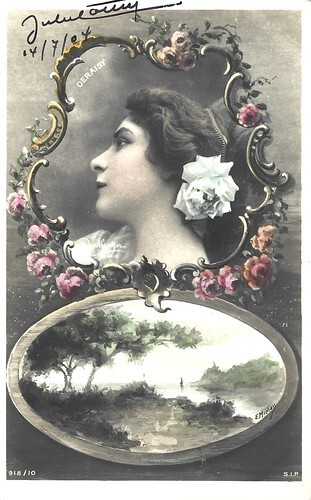
French postcard by Ed. S.I.P., no. 918/10. Photo: Reutlinger. Picture: E. Michau. The card was mailed in 1904.
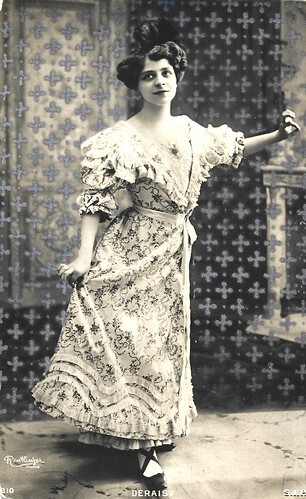
French postcard by Ed. S.I.P., no. 910. Photo: Reutlinger, Paris.
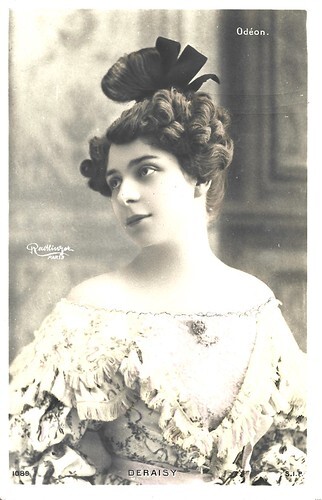
French postcard by Ed. S.I.P., no. 1088. Photo: Reutlinger, Paris.
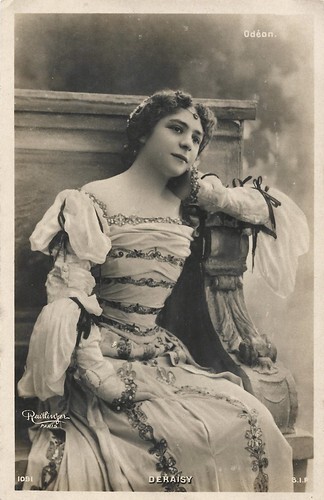
French postcard by Ed. S.I.P., no. 1091. Photo: Reutlinger, Paris. Caption: Odéon.
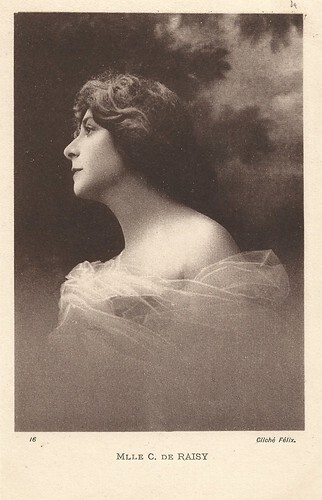
French postcard, no. 16. Photo: Félix.
A newly wed-bride who gets trapped in a room with a skeleton
Carmen Deraisy, aka Carmen de Raisy, was born Carmen Marie Hermine Carraud in Asnières-sur-Seine, France, in 1883. Deraisy was taught at the Paris Conservatoire national supérieur d'art dramatique, where Paul Mounet was her teacher.
In the early 1900s, she acted at the Théâtre de l'Oeuvre, where in 1905, she played the femme fatale Gioconda Danti in Gabriele D'Annunzio 's play 'La Gioconda', and Ornelia in D'Annunzio's 'La figlia di Jorio'. In 1907, she had a supporting part in L'Affaire des Poisons by Sardou, performed at the Théâtre de la Porte Saint-Martin, with Gilda Darthy as Mme de Montespan and Maxime Desjardins as King Louis XIV. At the same theatre, she also had supporting parts in 'Le Bourgeois gentilhomme' and 'Horace', both with Darthy in the female lead. Afterwards, she did several performances at the Théâtre de l'Ambigu-Comique, as in 'Nick Carter' in 1909. In 1910, she played La Poule blanche (The White Chicken) in 'Chantecler' by Edmond Rostand, first performed on 7 February 1910 at the Théâtre de la Porte-Saint-Martin.
In the same year, 1910, Deraisy began acting in films at the Éclair company in La jolie dame de Narbonne / The Pretty Lady of Narbonne (Victorin-Hippolyte Jasset, 1910), where she played the lead role from the start. Already in 1911, she stepped over to Pathé, where she could be seen in La mariée du château maudit / The Bride of the Cursed Castle (Albert Capellani, 1911), a Horror-like film about a newlywed bride who gets trapped in a room with the skeleton of a noblewoman, locked in there centuries ago.
After that, Deraisy acted in eight more films at Pathé between 1911 and 1914. In Les Martyrs de la vie / The Martyrs of Life (René Leprince, 1912), with René Alexandre and Stacia Napierkowska , she played a wealthy, ugly woman abandoned by her husband-to-be, who prefers a simple working-class girl. The woman becomes a nun, and one day the sick girl is brought into her ward... In 1914, Deraisy had a supporting part in the remake of La Lutte pour la vie / The Fight for Life, directed by Leprince and Ferdinand Zecca, and starring René Alexandre . Deraisy's last silent film was the Gaumont production La Statue du silence / The Statue of Silence (unknown director, 1914). All in all, she played in 14 films between 1910 and 1914.
In 1911, a scandalous event happened at the Théâtre de la Porte-Saint-Martin in Paris when Deraisy was attacked by British former boxer and then boxing school teacher and owner Marc Gaucher, who rubbed rubbish in her face. He was given a 15-day suspended prison sentence and fined 200 francs. Parallel to her film career, Deraisy acted in the early 1910s at the Théâtre Femina, Théâtre des Arts and Théâtre de la Comédie Royale in plays by Raymond Roussel, G.B. Shaw and Tristan Bernard. During the late 1910s, Deraisy would continue to perform at the Théâtre de la Porte St. Martin, e.g. in 1916 as Roxane in Rostand's 'Cyrano de Bergerac'. Deraisy would return to the film set only once more, as a fortuneteller in the Harry Baur film Péchés de jeunesse / Sins of Youth (Maurice Tourneur, 1941). Carmen Deraisy died in Paris in 1954.
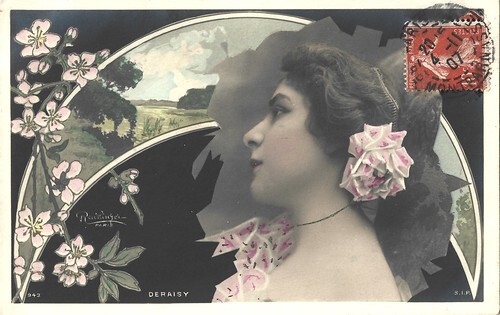
French postcard by Ed. S.I.P., no. 943. Photo: Reutlinger, Paris.
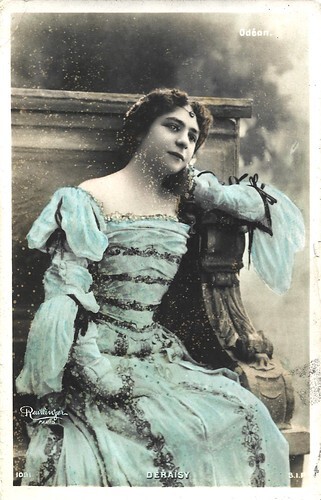
French postcard by Ed. S.I.P., no. 1091. Photo: Reutlinger, Paris.
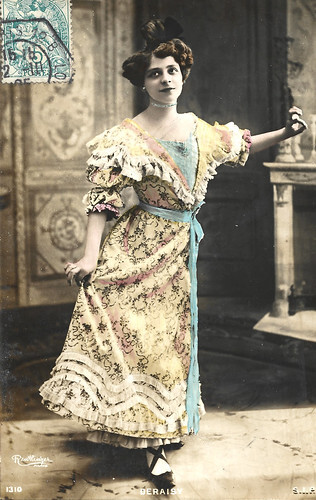
French postcard by Ed. S.I.P., no. 1310. Photo: Reutlinger, Paris.
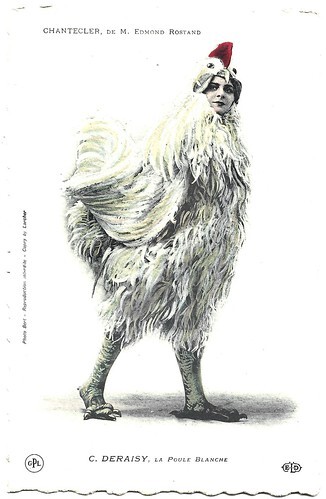
French postcard by GPL ELD (Ed. Le Deley). Photo: Bert. Carmen Deraisy as La Poule Blanche (The White Chicken) in the French play ' Chantecler ' (1910) by Edmond Rostand.
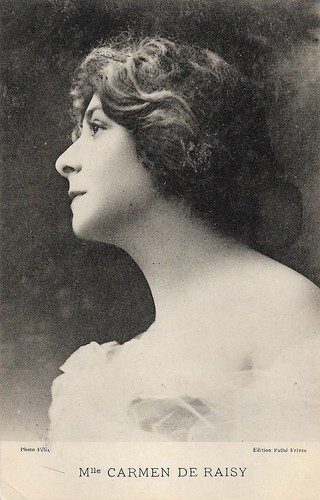
French postcard by Edition Pathé Frères. Photo: Félix. Caption: Mlle Carmen de Raisy.
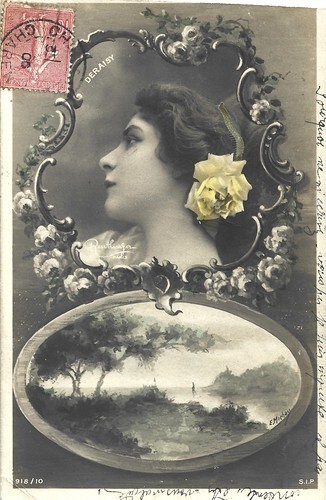
French postcard by Ed. S.I.P., no. 918/10. Photo: Reutlinger, Paris. Image: E. Michau.
You can view La mariée du château maudit (1911) at Eye Filmmuseum's section on YouTube. Recommended!
Sources: Wikipedia (French), Les Archives du Spectacle, Gallica, and .

French postcard by Ed. S.I.P., no. 918/10. Photo: Reutlinger. Picture: E. Michau. The card was mailed in 1904.

French postcard by Ed. S.I.P., no. 910. Photo: Reutlinger, Paris.

French postcard by Ed. S.I.P., no. 1088. Photo: Reutlinger, Paris.

French postcard by Ed. S.I.P., no. 1091. Photo: Reutlinger, Paris. Caption: Odéon.

French postcard, no. 16. Photo: Félix.
A newly wed-bride who gets trapped in a room with a skeleton
Carmen Deraisy, aka Carmen de Raisy, was born Carmen Marie Hermine Carraud in Asnières-sur-Seine, France, in 1883. Deraisy was taught at the Paris Conservatoire national supérieur d'art dramatique, where Paul Mounet was her teacher.
In the early 1900s, she acted at the Théâtre de l'Oeuvre, where in 1905, she played the femme fatale Gioconda Danti in Gabriele D'Annunzio 's play 'La Gioconda', and Ornelia in D'Annunzio's 'La figlia di Jorio'. In 1907, she had a supporting part in L'Affaire des Poisons by Sardou, performed at the Théâtre de la Porte Saint-Martin, with Gilda Darthy as Mme de Montespan and Maxime Desjardins as King Louis XIV. At the same theatre, she also had supporting parts in 'Le Bourgeois gentilhomme' and 'Horace', both with Darthy in the female lead. Afterwards, she did several performances at the Théâtre de l'Ambigu-Comique, as in 'Nick Carter' in 1909. In 1910, she played La Poule blanche (The White Chicken) in 'Chantecler' by Edmond Rostand, first performed on 7 February 1910 at the Théâtre de la Porte-Saint-Martin.
In the same year, 1910, Deraisy began acting in films at the Éclair company in La jolie dame de Narbonne / The Pretty Lady of Narbonne (Victorin-Hippolyte Jasset, 1910), where she played the lead role from the start. Already in 1911, she stepped over to Pathé, where she could be seen in La mariée du château maudit / The Bride of the Cursed Castle (Albert Capellani, 1911), a Horror-like film about a newlywed bride who gets trapped in a room with the skeleton of a noblewoman, locked in there centuries ago.
After that, Deraisy acted in eight more films at Pathé between 1911 and 1914. In Les Martyrs de la vie / The Martyrs of Life (René Leprince, 1912), with René Alexandre and Stacia Napierkowska , she played a wealthy, ugly woman abandoned by her husband-to-be, who prefers a simple working-class girl. The woman becomes a nun, and one day the sick girl is brought into her ward... In 1914, Deraisy had a supporting part in the remake of La Lutte pour la vie / The Fight for Life, directed by Leprince and Ferdinand Zecca, and starring René Alexandre . Deraisy's last silent film was the Gaumont production La Statue du silence / The Statue of Silence (unknown director, 1914). All in all, she played in 14 films between 1910 and 1914.
In 1911, a scandalous event happened at the Théâtre de la Porte-Saint-Martin in Paris when Deraisy was attacked by British former boxer and then boxing school teacher and owner Marc Gaucher, who rubbed rubbish in her face. He was given a 15-day suspended prison sentence and fined 200 francs. Parallel to her film career, Deraisy acted in the early 1910s at the Théâtre Femina, Théâtre des Arts and Théâtre de la Comédie Royale in plays by Raymond Roussel, G.B. Shaw and Tristan Bernard. During the late 1910s, Deraisy would continue to perform at the Théâtre de la Porte St. Martin, e.g. in 1916 as Roxane in Rostand's 'Cyrano de Bergerac'. Deraisy would return to the film set only once more, as a fortuneteller in the Harry Baur film Péchés de jeunesse / Sins of Youth (Maurice Tourneur, 1941). Carmen Deraisy died in Paris in 1954.

French postcard by Ed. S.I.P., no. 943. Photo: Reutlinger, Paris.

French postcard by Ed. S.I.P., no. 1091. Photo: Reutlinger, Paris.

French postcard by Ed. S.I.P., no. 1310. Photo: Reutlinger, Paris.

French postcard by GPL ELD (Ed. Le Deley). Photo: Bert. Carmen Deraisy as La Poule Blanche (The White Chicken) in the French play ' Chantecler ' (1910) by Edmond Rostand.

French postcard by Edition Pathé Frères. Photo: Félix. Caption: Mlle Carmen de Raisy.

French postcard by Ed. S.I.P., no. 918/10. Photo: Reutlinger, Paris. Image: E. Michau.
You can view La mariée du château maudit (1911) at Eye Filmmuseum's section on YouTube. Recommended!
Sources: Wikipedia (French), Les Archives du Spectacle, Gallica, and .
Published on August 09, 2025 22:00
Paul van Yperen's Blog
- Paul van Yperen's profile
- 13 followers
Paul van Yperen isn't a Goodreads Author
(yet),
but they
do have a blog,
so here are some recent posts imported from
their feed.



